- Worldschooling Topics
- Family Travel Resources
- Destinations
- Travel Tips
- Responsible Travel
- Family Gap Year Guide
- Places and Destinations


Best Travel WiFi Router (And 7 Tips for How To Use A Portable Router)
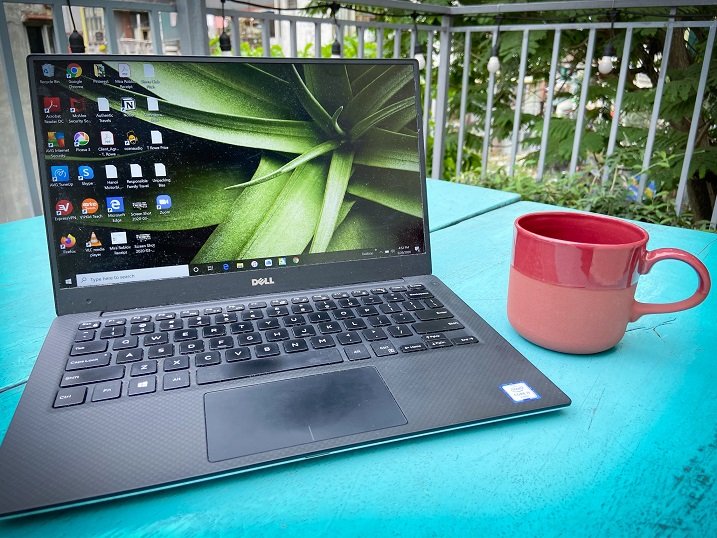
As a digital nomad family, one of the most useful tools for staying connected is a travel WiFi router. In this guest post, my husband, Clint Bush (who works full time as a software engineer), shares his reasons why you need a portable router for travel.
We’ve been working remotely since 2018. As a remote worker, it’s important to have consistent internet connection. Nothing is worse than being on a Zoom call (or leading a meeting, for that matter) and dropping out because of an unstable connection.

Even though we always get a local data SIM card, so we can use a WiFi mobile hotspot from our phone if the internet goes down, our travel WiFi router is by far one of the key tools in our digital nomad toolbox. Read this post to learn which travel WiFi router brands we prefer, and why you’ll want to travel with a portable WiFi router.
This post was written by Clint Bush and originally published on November 18, 2018.
This post may contain affiliate links. That means I may receive a small commission if you click on the link and purchase something. But don't worry, this will not result in any extra costs to you.
Table of Contents
Our top picks for a travel WiFi router
Want some quick tips for which travel WiFi router to choose? Here’s our top pick for a portable WiFi router, along with our pick for a mesh network and WiFi extender.
- Travel wifi router: GL. iNet Slate AX (GL-AXT1800)
- Mesh network: Amazon eero 6+ mesh Wi-Fi system (up to 4,500 sq. ft.)
- WiFi extender: TP-Link WiFi Extender (up to 1,200 sq. ft.)
What is a travel WiFi router?
For those who might not know the function of a travel WiFi router, here's a quick IT lesson. Internet connection gets sent in analog form through a cable from the cable company into your hotel or home. The cable connects to a modem that converts it from an analog signal to a digital signal.

A router then connects to the modem (or is built into the modem) via a cable. That router turns the internet signal into radio frequencies that are broadcast out. This is WiFi (short for wireless fidelity) - the radio broadcasting of internet signals.
Since the WiFi signal is a radio frequency, it is subject to interference that can be caused by other radio signals in the air, microwaves, concrete walls, etc. The point is if you only have a single router outputting a signal on one end of the house or hotel, and you are on the other end, how strong is the signal going to be?
For travelers, and especially digital nomads who rely on reliable internet for work, one quick fix is to carry a portable wireless router.
Travel WiFi router brands to buy
In terms of a good travel WiFi router, as well as a WiFi extender or a mesh network, there are several major brands out there. If you’re planning on using a virtual private network (VPN) such as ExpressVPN , they have a list of routers (such as the Netgear Nighthawk ) they directly work with, but I find them too bulky and expensive especially for travel.
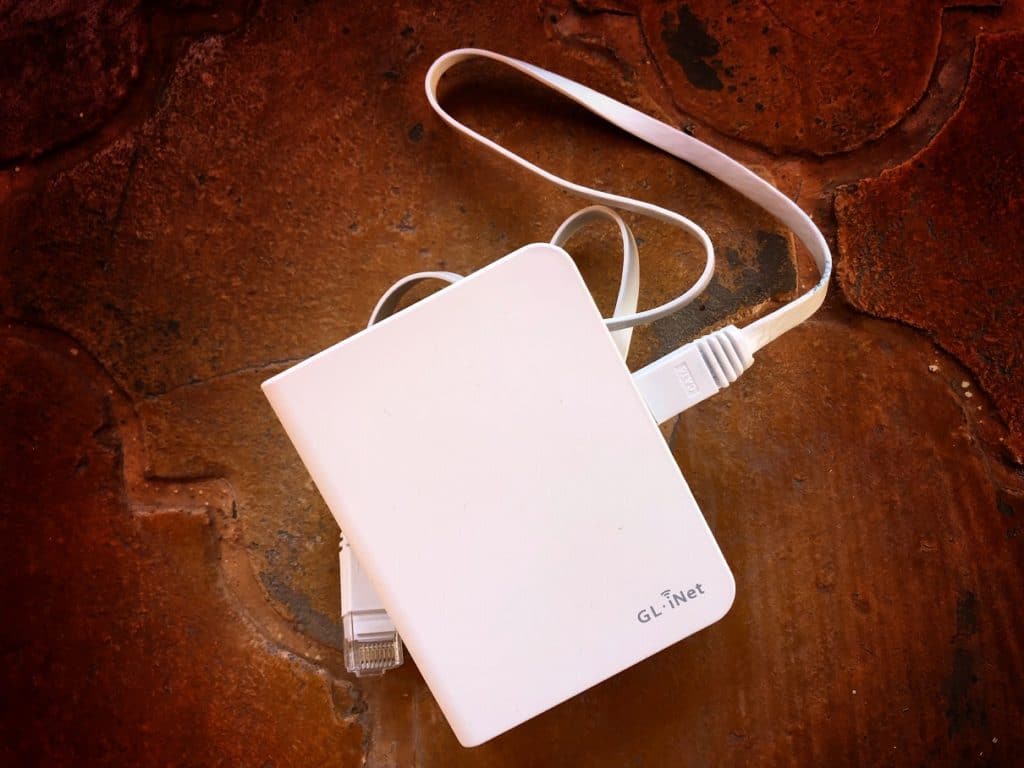
I prefer a more compact travel router that can run OpenVPN directly. While this involves additional setup and requires some network knowledge (Express VPN has a good walkthrough ), the small size of the travel WiFi router makes it convenient for travel.
If you want to try out Express VPN, snag my referral code to get 30 days free !
One major advantage of the bulkier Express VPN-approved travel WiFi routers compared to a mini wireless router for travel is speed. This is especially important when using a VPN. Our small travel WiFi router does a great job, but if we need to stream video the travel router WiFi can’t always handle that. VPN speeds can throttle quite a bit. Getting one of the bigger approved routers can increase your connection speeds and handle larger bandwidth loads better.

Ready for a change? Take the first step to living a life of full time travel.
However, if you’re traveling, you’ll want to focus on compactness, rather than bulk. Besides a travel WiFi router, you can also consider traveling with a mesh network (multiple travel routers that connect to the original router to act as a single network) or a WiFi range extender (that extends your WiFi signal). Here are the top brands of wireless travel routers that we recommend.
We like GL.iNet because their products perform consistently well. We traveled with the GL.iNet GL-AR750 (Creta) travel WiFi router in the past, as well as an older version of the GL.iNet GL-MT3000 (Beryl) wireless travel router. However, there are plenty of other travel WiFi routers from GL.iNet that you can bring for your travels.
The GL.iNet travel routers we recommend have a USB port and an ethernet port (or multiple ports) so you can plug into the device directly. Click the buttons below to look at these travel WiFi routers from GL.iNet.
Amazon eero
If you’re planning on staying somewhere that will give you direct access to the original router, then bringing along a mesh network might be more useful than a single travel WiFi router. Essentially, a mesh network is a set of routers that link to the main router to create a blanket network throughout the space, sending consistent wireless signals. This is ideal if you’re planning on housesitting or staying at someone’s house, as you’ll likely be able to directly connect with the main internet router.
One drawback of traveling with a mesh network is that you’re bringing multiple devices instead of just one item (the mesh network usually comes in sets of 3). Additionally, mesh networks tend to have a higher price point (because they’re multiple devices), so you’ll need to be careful when traveling with these expensive devices.
Check out these mesh networks from Amazon eero.
We have not personally used TP Link, but have read positive reviews of their devices. Like GL.iNet, they offer a travel WiFi router that travelers can use. And like the Amazon eero, they also have a mesh network option.
TP Link also offers a dual band WiFi extender, which can help extend the range of WiFi signals from your Airbnb or hotel WiFi router, using both 2.4 GHz and 5 GHz frequencies. This extender requires a United States outlet for its power supply, but you can carry a power adapter if you’re traveling overseas.
One thing to note about using a WiFi extender, the strength of the signal will be weak at its farthest point of the extender range.
Learn more about the amazing family travel resources we use for worldschooling!

Benefits and tips for how to use a portable router
There are many benefits to carrying a travel WiFi router with you whenever you travel. Primarily, a travel WiFi router helps repeat the WiFi signal and minimizes the instances of spotty WiFi. Additionally a travel WiFi router allows for multiple devices to connect to the WiFi network, and allows for use of a VPN.

Once you know the benefits of having a travel WiFi router, it’s also helpful to know how to use a portable router. Here are some details of why a travel WiFi router is beneficial for travel, and how to use a portable router (and VPN) for travel.
1. WiFi repeating
This is the first benefit of your own travel wifi router: repeating the signal. Many routers these days have the ability to pick up an existing WiFi signal and extend or repeat that signal.
By placing an additional portable router closer to the WiFi signal, you can extend the distance of that WiFi signal. This increases your coverage across the house or hotel room. You will lose a bit of speed when you do this. Keep that in mind if you are trying to stream a video or play a game online.
2. Optional hard-wiring to skip spotty public WiFi
This tip will only help you if you are in a hotel that has an ethernet cable available to you. This is usually the case in business hotels, or if the home or AirBnB you are staying at has the router directly in the unit.
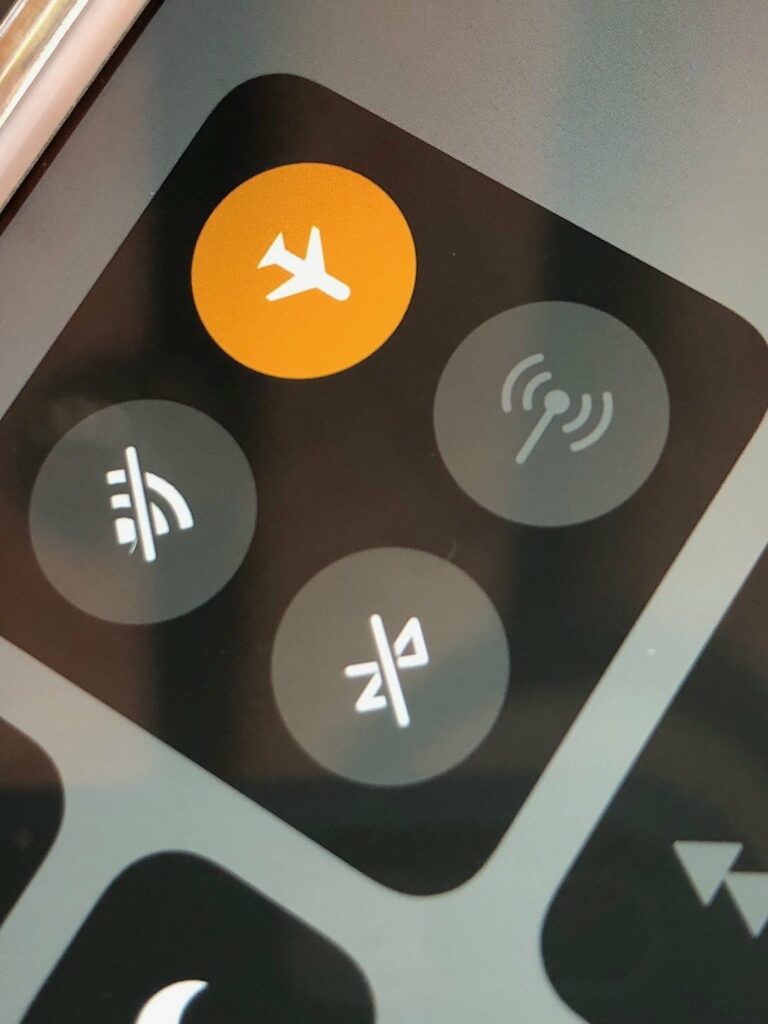
If either of these are the case, and you have the option to plugin an ethernet cable, then having a portable router can allow you to create your own WiFi network off of that wired connection. That means all of your devices can connect to a single WiFi source. This is way more reliable than the public WiFi available to you.
3. Easy connecting for multiple devices
One of my favorite reasons to use a portable router is the ease of connection setup when I get to a new location for all of our devices. Between our family we have multiple laptops, tablets, phones, and a Roku. Setting up each of these with new WiFi would be a pain in the neck.
My solution is to connect them to the WiFi network I created on the portable router. That way, I just set up the portable router at the new connection. Voilà one device setup and all devices are connected.
We’ve done this while we were slow traveling in cities like Jakarta , Indonesia and Guanajuato , Mexico.

Get weekly worldschooling tips sent to your inbox with my Worldschooling Wednesday email series.
4. Running VPN directly through a router
If you are using a VPN (and you absolutely should be using a VPN when you're connecting to WiFi outside your home!), you usually run it through each device through an application or VPN configuration. This works perfectly fine for my wife and me, since we remember to turn it on before using the public WiFi.

My kids, on the other hand, they never remember. So if they jump on a device, they are accessing the internet without protection. Of course, they are not logging into bank accounts or sharing sensitive information so it’s not that big of a deal. However, for ease of mind, I still want to make sure they are keeping our information secure.
Read up on the other useful travel gear and tools we travel with around the world.
5. Using a VPN Connection with your travel WiFi router
When it comes to choosing between using VPN vs travel router, there actually isn’t a choice. You should be doing both to ensure that your personal and confidential information remains secure.
Having a travel WiFi router that allows for VPN connection directly through the router is the way to go.
By running the VPN directly through the router, I now know that my kids are automatically connected to the VPN as soon as they start using their device.
6. Advantages of running a VPN through a router
There are several other advantages of running VPN this way too:
- ExpressVPN and other VPN services usually limit your devices you can connect to the VPN at a single moment. ExpressVPN for example limits you to three devices at a time. Have two phone and two laptops between my wife and I alone, we already exceed that. By running the VPN through the router, it only counts as one device rather than four.
- My work laptop can’t run a VPN application on it for a number of reasons, so using it through the router is the only option I have.
- Roku and other similar devices usually don’t have a way to connect to VPN, so running them through the router that has VPN is the only way to go.
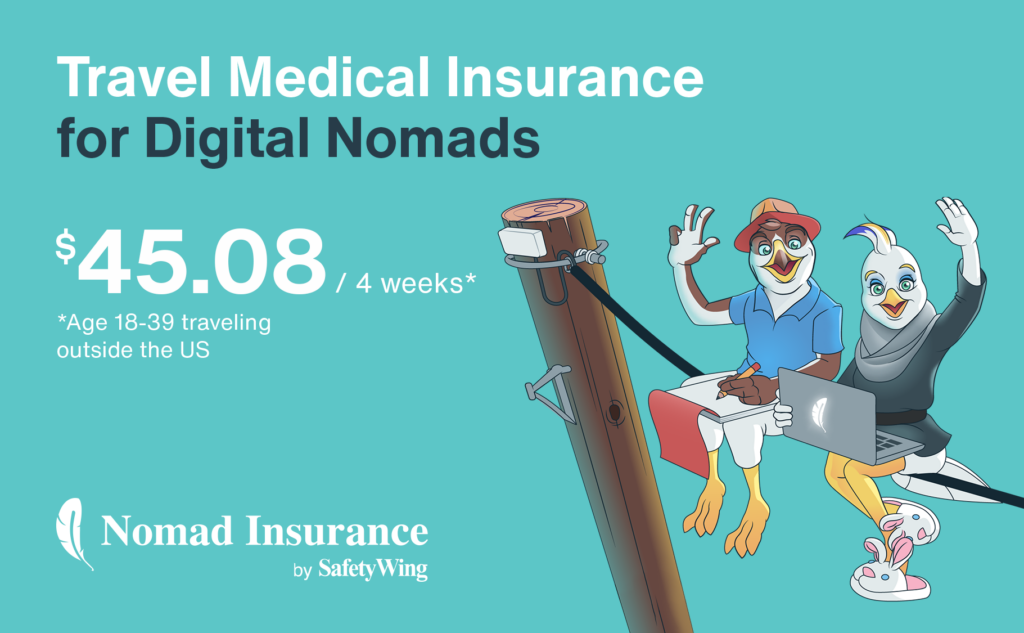
Get prepared for any emergency with the insurance made for digital nomads!
7. Setting up your travel WiFi router
The actual steps on setting up a portable router will vary from router to router, but here are some tips that helped me:
- Find a spot that is centrally located if possible and sit the router mid-level or higher for best broadcasting.
- Plug the router directly into the modem or existing router if possible using an ethernet cable. This will give you the best signal strength.
- When repeating the existing WiFi signal, do some speed tests on the existing network to find the fasted available network to connect to. Sometimes that is only 1 network, so you won’t have any options there. If there are 5GHz vs 2.4GHz options, experiment with both to see which of the connections your router works best with. There’s a whole side discussion about 5GHz and 2.4GHz that I am going to skip for now, but hit me up if you have any questions regarding that.
- Plug the router into a surge protector if possible. Since it will always be plugged in, there is a high risk of power surge. Protect your investment by unplugging at night or plugging into a surge protector.
- Use a WPA-2 password key when creating your WiFi network on the router. This will give you the best protection.
- Remember when using your portable router, your data is not encrypted unless you are using a VPN. Sometimes there’s a false sense of security because you are using your own router and not the existing Public WiFi. Always use a VPN.
Learn about our digital nomad worldschooling lifestyle .
Travel WiFi router: a must have for digital nomads
For those of you living a nomadic lifestyle, and even if you aren't, having a reliable internet connection while you travel is important. There’s no need to be standing by a window all day hoping that your cell phone gets a strong enough signal to hotspot! Those days are over!

With a travel WiFi router (or a mesh network or WiFi extender), you can ensure that you stay connected to the internet. And that’s an important tool to have to help you live the digital nomad travel life of your dreams!
Do you have recommendations for your favorite travel WiFi router? Send me a message and let me know which travel WiFi router you prefer.
Are you wondering what other tools you need to lead a full-time travel lifestyle with your kids? Get a copy of my ebook, Hey Kids, Let’s Go Travel! to get started on planning a family gap year.
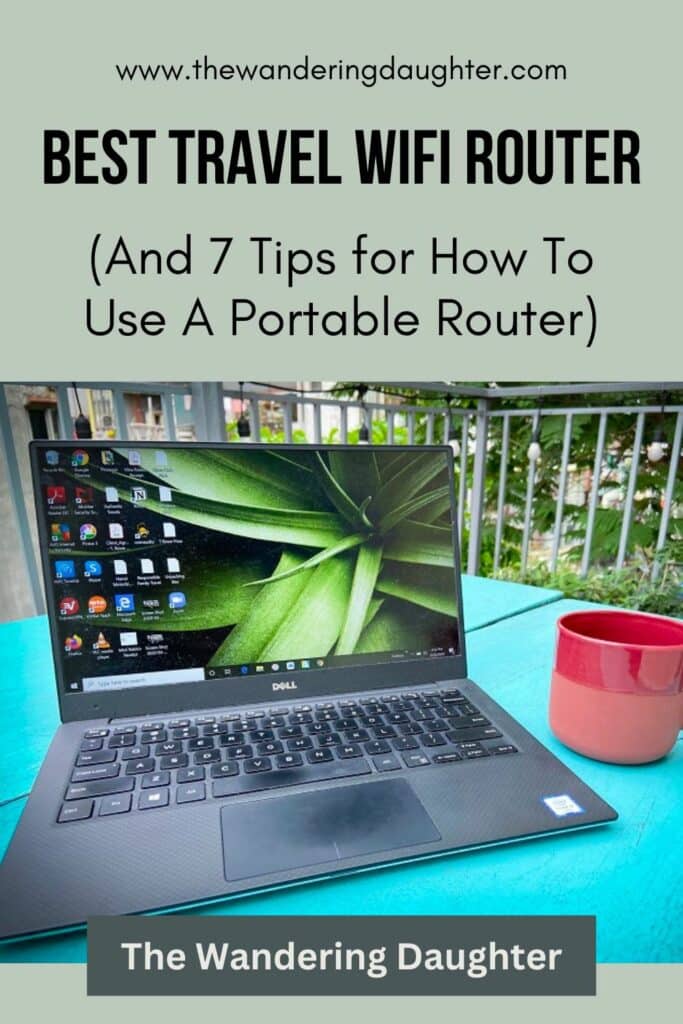
Need help thinking through how to budget for a family trip? My Travel Budget Worksheet is just the tool you need! Click here to receive your free copy by signing up for my newsletter.

Want to connect with me on social media? Find me on Facebook , Instagram , Pinterest , and Twitter. And for those of you who are dedicated to traveling more responsibly, sustainably, and ethically, join over 200 like-minded families on my Facebook group, Responsible Family Travel .
Sharing is caring!
Related Posts

Sign up to get travel tips in your inbox!

What is a Travel Router, Types, and How Do They Work?
Are you traveling soon with an insane volume of office work breathing down your neck? If yes, you might want to throw yet another gadget into your backpack before heading out. Yes, you guessed it right, a portable travel router.
Portable, sleek, and multi-faceted! This is what a travel router feels like. But what exactly is it, from a technical perspective? Well, it isn’t anything complicated but a more compact version of a standard router.
It still does the same job of connecting multiple devices to the network or internet, depending on availability. Now that you know a bit about travel routers , here are some of the important features to look for, before you can consider investing in one:
- Sleek form factor
- Battery-run setup
- Adequate number of ethernet ports
- Latest wireless standard
- MU-MIMO support
- Proper ventilation
- VPN support
- SIM-card support
- Customizability
While the list continues to grow, these are some of the vital traits that you must look for in a travel router, provided you want it to cover every base and manage every form of professional workload.
Table of Contents
1. Repeaters
2. access points, 3. sim-based routers, 5. client mode routers, pros & cons of a travel router, different types of travel routers / networking devices.
The type of travel networking device you want to purchase depends on several factors, including the nature of your work, the number of devices you want to connect, availability of the internet at a given location, the number of non-wireless products around, nature of the primary internet supplying device, and even the security safeguards you prefer.
Depending on these requirements, here are the travel routers that need to be considered:
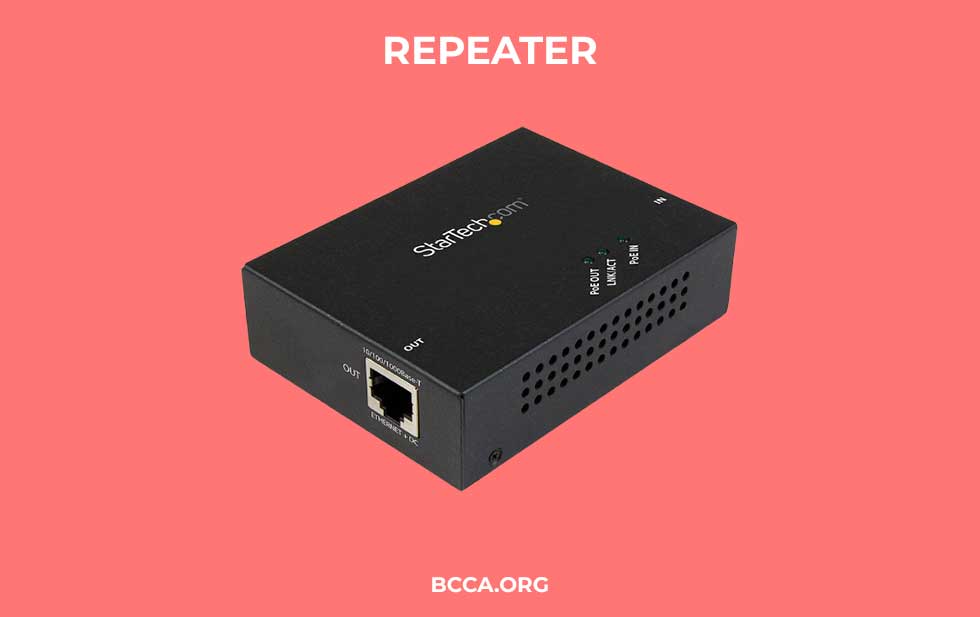
If you have a steady wireless connection around and you simply want to bring it straight to your devices, a repeater or a portable Wi-Fi extender seems like a good choice. Purchasing this form of the router makes sense if you want something for your office or home but do not want to allocate a lot of space to place a full-fledged extender.

Some travel routers need to have several ethernet ports, preferably WAN, for them to haul internet from non-wireless devices, like modems. Therefore, if you are moving to a place at only has active internet for basic tasks, a travel router capable of working in the AP mode can help you pull internet connectivity for your smart devices.

Can travel routers work if the place you are heading towards doesn’t have a dedicated internet connection in the first place? Well, it still can if your travel router has a SIM card slot to make use of the 4G LTE connection, thereby working as a portable hotspot of sorts.

If you want to connect multiple networks together, especially to get hold of a completely separate and secure network for your devices to work with, you are better off investing in a bridge-like travel router.

In case you only have non-wireless devices around or a laptop with a broken wireless adapter, you would want a travel router that can work in the client mode, courtesy of the multiple ethernet ports for each.
In addition to these variants, you can even consider investing in single and dual-band travel routers, completely wireless routers with battery backup, and other models, based on individual preferences.
You can even select routers based on the wireless standard. While a Wi-Fi 6 router is always the best option, Wi-Fi 5 devices aren’t bad either. Still, if you just want to focus more on the coverage and less on speeds, Wi-Fi 4 or 802.11n routers can be considered.
Finally, it is important for the travel routers to be flexible when it comes to the power source. While most routers still come with adapters, you can even opt for battery-run ones or devices with PoE or Power-over-Ethernet functionality.
How do Travel Routers Work?
Travel routers, inherently, have the same skill sets as traditional routers. However, they are just way more portable and exceptionally good at connecting to existing public wireless networks and eventually extending the same to smart and non-wireless devices.
Depending on the type of router you purchase, you can either:
- Extend the existing public Wi-Fi network as a private network
- Bridge the same for getting hold of a newer network
- Connect to non-wireless devices
- Connect directly to the public wireless device as an access point.
Also, once you have a travel router with you, your devices need not establish a direct connection with the main internet source, thereby saving you a lot of time and effort.
Your router becomes the hub, which then secures the network and even allows the connected devices to share data between them, in case the router has NAS functionality in the first place.
Certain devices, mostly with OpenWRT firmware , offer VPN integrations and a wide range of other open-source functionalities that allow you to secure the device further.
- Ability to add multiple devices to a single routing setup
- Secure private network
- Portability
- Ability to stay even more secure over hotel networks with VPN support
- Some travel routers even offer WPA2 encryption
- Can support both wired and wireless connectivity
- Some routers allow data sharing over networks
- Can work as a wireless extender when at home
- The external power supply can be a bottleneck
- Coverage can be an issue at times
- Single-band routers compromise on near band throughput
- Not all come with app support
- Not meant for gaming and 4K streaming
Now that you know a fair bit about travel routers, you need to ask yourself a simple question, i.e., Are travel routers cut out for you?
Well, if you are a professional who needs to work even while traveling, a travel router is a necessary investment. They let you connect several devices to the internet with ease and even let you extend the internet at home.
Regardless of whether you need one or not, it is still better to keep an updated one handy to ensure that you never run out of internet, even while traveling to the remotest of places.

Chris loves technology, specifically smart home technology! With both hands-on and executive leadership experience in his corporate career, Chris stays abreast of emerging technology and solutions and immerses himself in BCCA when not in the office.
How-To Geek
Get a travel router to upgrade your hotel wi-fi experience.
You can upgrade your hotel Wi-Fi experience easily.
Quick Links
What's a travel router, why use a travel router in a hotel, which travel router should you get.
You might not have "travel router" on your vacation packing list, but after reading this article, you just might. Here's why we always pack a router with us when we're headed to a hotel.
A travel router is a small network router designed with an emphasis on portability and use in-the-field. While you could, in theory, use a travel router as an internet router in your home, it's not intended for that.
Instead, travel routers are meant to link together a smaller number of devices all congregated fairly close together. Think, your laptop and phone, your kids' tablets, and maybe even a streaming stick in a hotel room---not all those things plus a pile of computers, smart devices, and such spread out across your whole home.
They typically have a very small form factor, the size of a portable battery pack or even smaller. Speaking of that, many of them are portable battery packs, so you can use them to charge your phone while you travel in addition to their router function.
Further, unlike the router you have at home, travel routers have UI elements and even physical toggles that make it easy to quickly switch them between functions like router mode, hotspot mode, repeater mode, and so on.
That last part is crucial. You want a travel router that can easily connect to the hotel's internet in different and reliable ways. In some hotels, you can plug the travel router directly into a courtesy Ethernet connection in your room, which is easy peasy.
In other hotels, there's no physical internet connection, and you have to connect the travel router to the hotel's Wi-Fi and use it in hotspot mode, where it captures the Wi-Fi connection, and then all your local devices connect to the travel router instead of the hotel's Wi-Fi system.
You might be thinking, "Well, that's all very fascinating, but I have no idea why I would go to the trouble?" And that's certainly a fair question to have on your mind if you've never considered packing a router (no matter how small it might be) along with your toiletries and phone charger .
Historically, one of the best reasons to pack a travel router was that many hotels didn't have Wi-Fi (they only had an Ethernet port in the room for business travelers to plug in their laptops).
Later, when hotels started to get Wi-Fi, they had frustrating policies like only one or two devices per guest/room were allowed on the network. Even today, some hotel Wi-Fi systems still have such rules.
When you use a travel router, you can "log in" just the travel router to the hotel's system so, as far as they are concerned, there is only one device in the room. All the traffic of the other devices passes through the travel router.
Speaking of device traffic, you can also leverage the travel router to increase your privacy. Most travel routers support basic VPN protocols like PPTP or L2TP, and the more advanced ones support OpenVPN and WireGuard .
That makes it simple to tunnel right from your room to a third-party VPN or right back to your corporate or home VPN server. It also makes it easy to transfer files securely between your devices as the file transfer is happening over the micro network you set up, and the files never pass through the hotel's infrastructure in any way.
It also makes it much easier to use your devices in the fashion you're accustomed to. You could set your travel router's Wi-Fi credentials to match your home network's Wi-Fi credentials, for example. Not only does that make it dead simple to log in when you get to your hotel (as your phone and laptop already know the way "home"), but you can even toss your Chromecast or favorite streaming stick into your bag and use it in your hotel room. Forget the stupid "smart" TV interface hotels have, enjoy your streaming services the way you want without the lag.
Above all else, when you're shopping for a travel router (whether you pick one of our suggestions or forge out on your own to do some research), you need this feature: captive portal connectivity.
You know how when you first connect to a hotel's Wi-Fi there is usually a pop-up page where you accept the terms and conditions and/or login with your name and room number? That's the portal. You need a router that "capture" that exchange and mimics your initial login device (like your iPhone).
All of our picks below support easy captive portal exchanges, which makes the setup when you first get to your hotel room a breeze. Without that feature, you're left manually cloning your original login device's MAC address which usually works but can be hit or miss.
One of the most popular options on the market is the TP-Link N300 Nano Router . It's a steal at around $30, but it's starting to show its age.
It only supports 802.11n (Wi-Fi 4) on the 2.4 GHz band. But for only ten bucks more, you can jump from the N300 Nano Router to the TP-Link AC750 Nano Router .
TP-Link TL-WR902AC AC750
It's tiny, inexpensive, and our all-around top pick for best travel router. For most folks, it's the easiest solution.
The upgraded model features dual-band Wi-Fi, 802.11AC (Wi-Fi 5), and a really convenient switch on the side that makes it dead simple to change modes without logging into the router.
While we love the TP-Link Nano lineup, especially the newest models, and think they are the best fit for just about everyone, there are a few other options to consider.
If you want more advanced VPN solutions, you'll need to step beyond the TP-Link offerings and consider something like the GL.iNet GLMT300N ---it's roughly equivalent to the TP-Link N300 Nano Router but runs the popular OpenWRT router firmware and supports both OpenVPN and WireGuard.
And if you want a beefy upgrade over the TP-Link AC750 Nano Router consider the GL.iNet GL-A1300 .
GL-iNet GL-A1300
For power users that want passthrough connectivity for Ethernet devices and advanced VPN services like WireGuard, this travel router delivers.
It also runs OpenWRT firmware and robust VPN support like its smaller sibling, but includes two additional Ethernet ports, support for many more Wi-Fi devices, and more.
But whichever of our picks you go with, you'll become the master of your Wi-Fi destiny when you're on the road. Forget cruddy hotel Wi-Fi or frustrating Wi-Fi rules. Plug in your own router and go. And hey, if you're in the upgrade mood, here are some other travel gadget upgrades worth looking at.
- facebook-spy
- twitter-spy
- pinterest-spy
Livin’ That Van Life? Check Out the Best Compact Travel Routers For Accessing the Internet Anywhere
By Tyler Schoeber
Tyler Schoeber
Contributor

- Share This Article
Life on the road has its downfalls — but zero access to the internet doesn’t have to be one of them. Travel routers have been around for a bit now to help people all over the globe access the internet for work and play in places they otherwise wouldn’t be able to.
Accessing the internet in a hotel, Airbnb or even a Starbucks can be a bit of a mess. WiFi speed will often slow down due to so many users being on the same router, which means for those trying to get work done in a timely manner, it can become kind of a struggle. Travel routers are perfect for the on-the-road type of person who finds themselves constantly traveling from place to place for work, or, more recently, the kind of person living in a renovated sprinter van, school bus or SUV. This might sound weird to some of you, but van life is growing tremendously in popularity due to remote work becoming easier and easier for most millennials and older Gen-Zers.
So, if you find yourself constantly in a situation where you desperately need WiFi to get some work done away from the place you call home, you’re going to need a travel router.
What is a Travel Router?
A travel router is a router like the one you have set up at home. Instead of it being a stationary entity you never touch until it stops working for whatever reason, travel routers are smaller, portable routers meant to go with you on trips. They simplify the process of connecting devices to public networks in hotels, airports, Airbnbs and more. Some can even be considered the best routers for gaming and streaming movies.
Related Stories
Netgear’s m6 pro mobile hotspot is a must-have for frequent fliers, passkeys are the future of internet security, here’s how dashlane can help, how do travel routers work.
Travel routers work by plugging into the wall at a hotel, airport, coffee shop or wherever else you might be working. You will need access to a place with internet access already, so sadly you can’t technically use this on the road — it’s more of a portable stationary option. So, it’s not always like your average hot spot (but occasionally can be), it’s more like your best WiFi router .
What Are the Benefits of Using a Travel Router?
By using a travel router, you won’t have to spend copious amounts of time trying to connect to the internet every time you need it. After the very first time you connect, all of your devices previously connected will recognize the router and automatically connect no matter where you connect the travel router to. Travel routers are also less spotty than public WiFi, and, it’s entirely private to you. Travel routers are much faster than the guest WiFi floating around wherever you may be and are tiny enough to pack in most small bags.
If you’re constantly on the road or find yourself in hotel rooms and airports more regularly than the average person, check out the best travel routers below and make your life a little bit easier.
1. TP-Link AC750 Wireless Portable Nano Travel Router
The TP-Link AC750 Wireless Portable Nano Travel Router is one of the highest-rated travel routers on Amazon. It has a travel-sized design that’s small enough to throw in your carry-on or under-seat bag, making it incredibly convenient to those constantly on the road. WiFi is consistently fast and powerful enough to allow users to watch crystal clear HD content on all of their devices. It also can allow you to connect to outdoor WISP Access Points in public areas to work as a hotspot when you might need it most.
TP-Link AC750 Wireless Portable Nano Travel Router
$34.98 $39.99 13% off, 2. gl.inet gl-mt300n-v2 wireless mini portable travel router.
This tiny travel router is so tiny that it can fit in your back pocket without a problem. It has super-high security protocols to ensure your information is safe no matter where you’re at, offering an extra layer of protection wherever you have the ability to connect. As you’d imagine, it’s great for giving users a stronger, more reliable internet service in a wireless setting in both hotels and airports. Additionally, users will be able to connect to existing wireless networks without a cord, such as WiFi services in cafes. Hotspot usage is also available, too.
GL.iNET GL-MT300N-V2 Wireless Mini Portable Travel Router
3. netgear nighthawk m1 mobile hotspot 4g lte router.
Safely, swiftly and easily connect up to 20 devices in total with the NETGEAR Nighthawk M1 Mobile Hotspot 4G LTE Router and have each and every one of them work like magic. This travel router brings public WiFi into a private setting for everyone you’re on the road with. It connects with every mobile carrier securely providing fast internet for phones, laptops and tablets. It has a long battery life so you can use it on the road without even plugging it in, too.
NETGEAR Nighthawk M1 Mobile Hotspot 4G LTE Router
$199.99 $349.99 43% off, 4. tp-link n300 wireless portable nano travel router.
TP-Link has a couple of travel routers to be reckoned with, hence why this is the second time we’re throwing one in here for you to check out. This travel router is perfect for slipping in your pocket and bringing with you wherever and creating a secure WiFi hotspot in a matter of seconds. You’ll get lag-free HD video streaming each and every time the same way you would on a secure network at home. It has advanced security and industry-leading support with a two-year warranty.
TP-Link N300 Wireless Portable Nano Travel Router
5. gl.inet gl-ar750s-ext gigabit travel ac vpn router.
With the GL.iNet GL-AR750S-Ext (Slate) Gigabit Travel AC VPN Router, you’ll get OpenVPN and WireGuard pre-installed for maximum security. If those two aren’t your style, this travel router is also compatible with more than thirty other VPN providers. It’s compact and lightweight, making it perfect for frequent travelers. By using this travel router, you will also have the ability to connect to multiple workplaces without a problem, whether they’re at your work-from-home desk or at your office computer. It’s great for the kind of person who is extra reliant on security.
GL.iNet GL-AR750S-Ext Gigabit Travel AC VPN Router
Tyler Schoeber joined SPY in 2020, after working at TripAdvisor as Photo Intern-turned-Production Specialist. Tyler's editorial background is heavily focused on e-commerce journalism and…
Newsletters
Sign up for SPY news straight to your inbox every day
Most Popular
Ryan gosling and kate mckinnon's 'close encounter' sketch sends 'snl' cold open into hysterics, come for the torture, stay for the poetry: this might be taylor swift's most personal album yet, masters 2024 prize money pegged at $20m, up $2m from prior year, you might also like, biden congratulates tennessee auto plant on historic unionization drive, hipgnosis drama continues: blackstone bids $1.5 billion for troubled music fund, topping concord, sprinter gabby thomas says diamond league flosports deal is a drag, inside the hidden world of vip perks at america’s marquee sports arenas, prince harry makes official change that speaks volumes about his royal future.
Copyright © 2024 Penske Business Media, LLC. All Rights reserved.
The Enlightened Mindset
Exploring the World of Knowledge and Understanding
Welcome to the world's first fully AI generated website!
Understanding How Travel Routers Work: A Comprehensive Guide
By Happy Sharer
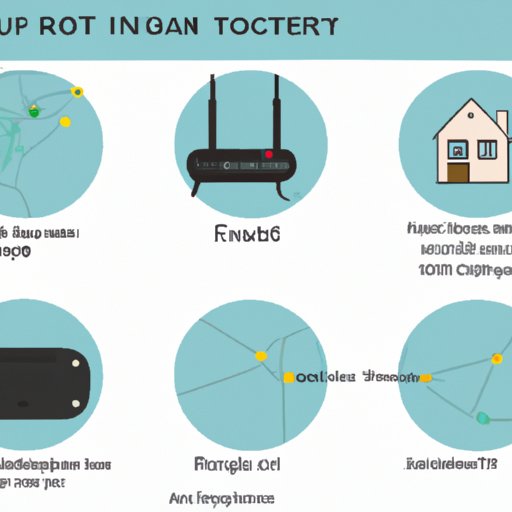
Introduction
A travel router is a small device that allows users to access the internet in areas where Wi-Fi is not available. It is an essential tool for travelers who need to stay connected while on the go. With a travel router, users can connect multiple devices such as laptops, smartphones, and tablets to the same internet connection.
Travel routers come in all shapes and sizes, but they are typically small enough to fit in a pocket or purse. They are also extremely easy to use, making them ideal for those who don’t want to deal with the hassle of setting up a complex network. In this article, we’ll explore how a travel router works, what it can do, and how to choose the right one for your needs.
Exploring the Basics of Travel Routers: How Do They Work?
A travel router works by taking an existing Wi-Fi signal and amplifying it so that multiple devices can be connected at once. The router then creates its own network, allowing users to share files, stream media, and access the internet anywhere there is an available Wi-Fi signal. This makes it an invaluable tool for travelers who need to stay connected while on the go.
The benefits of using a travel router are numerous. For starters, it eliminates the need for multiple devices to connect to the same Wi-Fi network. This means fewer passwords to remember and less time spent entering them. Additionally, travel routers provide a secure connection, meaning any data sent over the network is encrypted and protected from hackers. Finally, travel routers are incredibly portable, making them perfect for trips or vacations.
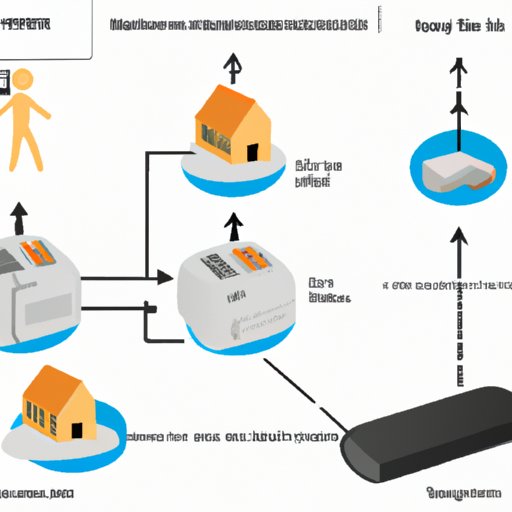
A Guide to Understanding How Travel Routers Function
Setting up a travel router is relatively straightforward. First, the router must be plugged into a power source and connected to a modem or switch. Next, the router will need to be configured, usually via a web-based interface. This process involves entering settings such as the type of encryption to use, the IP address of the network, and the password for the network.
Once the router is configured, it is ready to use. All that needs to be done is to connect the devices to the new network created by the router. This can be done by selecting the network name (SSID) and entering the password. Once connected, users can start browsing the internet or sharing files.
If there are any issues with the router, such as slow speeds or dropped connections, there are several steps to take to troubleshoot the problem. First, make sure the router is in a good signal area and not too far away from the modem. Additionally, restarting the router can often fix any minor issues. If the problem persists, contact the manufacturer for further assistance.
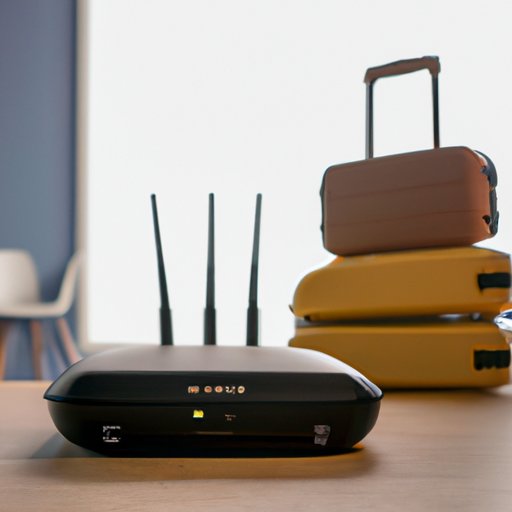
Taking the Mystery Out of Travel Routers: What You Need to Know
When shopping for a travel router, there are several factors to consider. First, look for routers that support the latest Wi-Fi standards, such as 802.11ac. This ensures maximum speed and compatibility with the latest devices. Additionally, look for routers with multiple antennas, as this increases the range of the router. Finally, look for routers that offer additional features such as parental controls, guest networks, and USB ports.
When comparing different types of travel routers, consider the following factors. Wired routers are typically more reliable than wireless routers, while wireless routers are easier to set up and more portable. Mesh routers provide the best coverage, but they are more expensive than traditional routers. Finally, travel routers typically offer fewer features than their full-sized counterparts, so make sure to read the specs before buying.
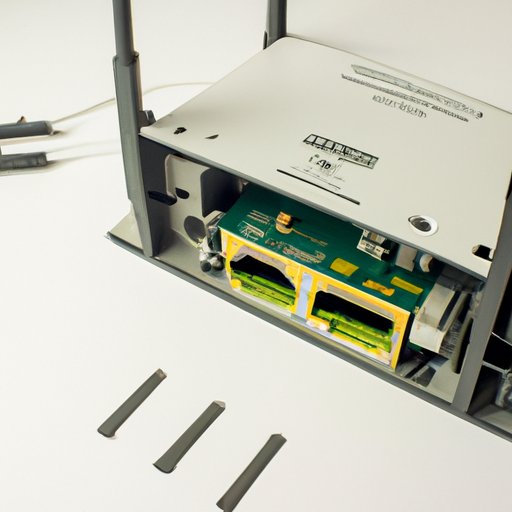
Unpacking the Inner Workings of Travel Routers
Travel routers are made up of several different components that work together to create a Wi-Fi network. The main component is a radio transceiver, which is responsible for receiving and transmitting the signals. Other components include antennas, modems, switches, and routers. These components work together to create a network that is both secure and reliable.
The radio transceiver is the most important component of a travel router. It is responsible for receiving and transmitting the signals, and it is also responsible for ensuring that only authorized users have access to the network. Additionally, the transceiver is responsible for encrypting the data to ensure that it is secure.
Breaking Down the Tech Behind Travel Routers
In order to understand how travel routers work, it is important to understand the technologies involved. Wi-Fi is the technology used to transmit data wirelessly, and it is the most commonly used technology for travel routers. Additionally, many travel routers use advanced security protocols such as WPA2-PSK and WEP to protect the network from unauthorized access.
Travel routers also use VPNs (virtual private networks) to ensure that all data transmitted over the network is encrypted. This helps to keep sensitive information safe from hackers and other malicious actors. Additionally, some travel routers offer additional security features such as parental controls and firewalls.
How to Make Sense of Travel Routers: A Comprehensive Overview
Travel routers are an essential tool for anyone who needs to stay connected while on the go. They are small and easy to use, and they offer a secure connection for multiple devices. Setting up a travel router is relatively straightforward, and there are plenty of options to choose from depending on your needs.
When shopping for a travel router, make sure to look for models that support the latest Wi-Fi standards and offer additional features such as parental controls. Additionally, understanding the components and technologies used in travel routers can help to ensure that you get the best performance out of your router.
In conclusion, travel routers are a great way to stay connected while on the go. With a bit of research, you can find the right router to meet your needs. Whether you are looking for a basic model or something more advanced, there is sure to be a travel router that fits the bill.
Travel routers are an invaluable tool for travelers who need to stay connected while on the go. With a bit of research, you can find the right router to meet your needs. Consider factors such as the latest Wi-Fi standards, additional features, and the components and technologies used to ensure the best performance. Hopefully, this article has helped to demystify the inner workings of travel routers and provided a comprehensive overview of everything you need to know.
(Note: Is this article not meeting your expectations? Do you have knowledge or insights to share? Unlock new opportunities and expand your reach by joining our authors team. Click Registration to join us and share your expertise with our readers.)
Hi, I'm Happy Sharer and I love sharing interesting and useful knowledge with others. I have a passion for learning and enjoy explaining complex concepts in a simple way.
Related Post
Exploring japan: a comprehensive guide for your memorable journey, your ultimate guide to packing for a perfect trip to hawaii, the ultimate packing checklist: essentials for a week-long work trip, leave a reply cancel reply.
Your email address will not be published. Required fields are marked *
Expert Guide: Removing Gel Nail Polish at Home Safely
Trading crypto in bull and bear markets: a comprehensive examination of the differences, making croatia travel arrangements, make their day extra special: celebrate with a customized cake.
- Great Tech Gifts for Any Occasion
- The Best Gadgets for The Beach or Pool
TP-Link TL-WR902AC AC750 Travel Router Review
A versatile pocket-sized Wi-Fi router
:max_bytes(150000):strip_icc():format(webp)/AndyZahn-889988aaa3a24074903f74ca8ebd874f.jpg)
- Lower Columbia College
We independently evaluate all recommended products and services. If you click on links we provide, we may receive compensation. Learn more .
TP-Link TL-WR902AC AC750 Travel Router
Lifewire / Andy Zahn
Extremely portable
Fast Connection
Inexpensive
Easy setup process
Range is somewhat limited
Incldued cables are short
The TP-Link TL-WR902AC Travel Router is both versatile and portable. Whether you’re traveling and want more security and privacy than a public Wi-Fi network affords, or you just want to extend your home Wi-Fi network, this humble little gadget can’t be beaten.
- Connectivity
- Competition
- Final Verdict
When you’re on the road, a fast and safe wireless connection can be a tricky thing to come by. An open network is a vulnerable network, and someone could easily be snooping on you when you log in to the guest network in your hotel to which dozens, perhaps hundreds of people are also connected. That’s where the TP-Link TL-WR902AC Travel Router comes in, offering a private network connection wherever the road takes you.
Design: Small and simple
The TP-Link TL-WR902AC is nothing if not simple in its design. You’ve got two Ethernet ports (one to connect the router to the network, one to connect a device to the router), a USB port, and a power adapter port. There’s a reset button, a switch for selecting one of three different modes, and the device comes packaged with just a short ethernet cable and an equally short power cable.
The short length of these cables is somewhat limiting, so you may want to supply your own. Fortunately, they’re easy and inexpensive accessories to buy. Since power is supplied via a micro-USB port, this router could easily be powered via a portable battery pack, which means you don’t necessarily even need a wall outlet to use it.
The small size and light weight of the TP-Link TL-WR902AC is a definite boon to frequent travelers. It’s so small that it easily fits in my pants pocket, making it diminutive enough to go with you wherever you go and however little you’re able to carry. It seems to be made of quite durable plastic, so you needn’t worry about it breaking en route. The design is fairly bland and utilitarian, with a simple row of indicator lights breaking up its monotonous grey and white surface, but then it's not a category that inspires a lot of dramatic design.
Setup: Hassle free
The TP-Link TL-WR902AC works effortlessly as a travel router . It’s basically plug and play, so you just need to plug it into an ethernet port in your hotel room and boom, you’ve got your own private network. It took me less than ten minutes to get it up and running the first time in router mode, and subsequent installations were of truly inconsequential length. It’s only slightly more complex than charging your phone, and the included instructions are straightforward and well laid out.
You just need to plug it into an ethernet port in your hotel room and boom, you’ve got your own private network.
Connectivity: Quick and reliable
In the Ookla speed tests I ran, the TP-Link TL-WR902AC showed similar results to a standard ISP provided router from Centurylink. I never experienced any issues with speed or reliability when using this router. I also appreciated that this router packs in dual-band capability despite its small size.
Range was just OK, but by no means terrible for such a diminutive device. I was able to use it throughout a medium-sized house and around the yard beyond up to about 100 feet. That range dropped off pretty quickly when obstructions hampered the signal. However, this router is intended for private internet browsing in a hotel, convention center, vacation house, or other remote location where portability and ease of use are more important than range and signal strength.
I was able to use it throughout a medium-sized house and around the yard beyond up to about 100 feet.
Beyond its usefulness as a standalone router, the TP-Link TL-WR902AC can also function in a number of other capacities. It can be set up as a range extender for your existing network, or as a transmitter to add wireless capability to a device designed only to connect to a wired network .
Software: Just the essentials
The TP-Link TL-WR902AC doesn’t really have software to speak of beyond the basic backend tools, and that’s just fine. The lack of need for extra software is an indicator of the desirable simplicity of this router.
Price: Budget friendly
At only $45, the TP-Link TL-WR902AC is about as cheap as routers come, and is really quite a bargain considering its portability, ease of use, and remarkable versatility. It offers similar performance compared to a basic ISP-provided router, but for less than half the typical price.
It's really quite a bargain considering its portability, ease of use, and remarkable versatility.
TP-Link TL-WR902AC Travel Router vs Ravpower Filehub AC750 Travel Router
If you’re looking for a step up from the TP-Link TL-WR902AC, the Ravpower Filehub AC750 has a built-in battery bank that allows it to operate for a short period of time without being plugged in. It can also be used as a portable battery bank with which to charge your smartphone or other devices. However, it’s more expensive, heavier, and has a more confusing setup process than the TP-Link.
With its strong signal, diminutive size, and affordable price, the TP-Link TL-WR902AC Travel Router is an easy device to recommend.
People typically don’t even think about packing a router in their suitcase, but the TTP-Link TL-WR902AC Travel Router deserves a place in your bag. It’s fast, quick, and easy to set up, and is small enough to fit in your pocket. Whether you’re traveling the globe or expanding your home Wi-Fi network, the TP-Link TL-WR902AC is a capable companion.
- Product Name TL-WR902AC AC750 Travel Router
- Product Brand TP-Link
- SKU 5844810
- Price $45.00
- Product Dimensions 2.6 x 2.9 x 0.9 in.
- Warranty 2 years
- Ports 2 Ethernet, 1 USB
Get the Latest Tech News Delivered Every Day
- The Best Wireless Travel Routers of 2024
- The Best Mesh Wi-Fi Network Systems of 2024
- The Best Wi-Fi Range Extenders of 2024
- The Best Asus Routers of 2024
- 5 Things to Consider Before Buying a Wireless Router
- The Best Parental Control Routers of 2024
- The Best Long-Range Routers of 2024
- Can Two Routers Be Used on the Same Home Network?
- The Best Cable Modem/Router Combos of 2024
- How to Use a Router as a Wi-Fi Extender
- The Best USB Wi-Fi Adapters of 2024
- What Is a Wi-Fi Adapter?
- The Best Tech to Travel With in 2024
- What Is a Wi-Fi Router?
- The Best Netgear Routers of 2024
- How to Connect Fire Stick to Hotel Wi-Fi

Savvy Travel Advice
Best Travel Routers for Internet while Traveling
Last updated: April 14, 2024 - Written by Jessica Norah 224 Comments
These days most travelers want to be able to get online regularly while traveling to check email, get directions, check hotel and restaurant reviews, upload photos, update social media, and stay in touch with those back home. Travel routers can help with this.
It is definitely easier to stay connected as wireless Internet is now widely available in most parts of the world but there are still a number of situations when it can be tricky (or expensive) to connect.
As travel bloggers who regularly have to manage our business on the go, it is often really important for us to be able to get online on a regular basis while traveling and it can be very frustrating when we are in a hotel with weak Wi-Fi, we are being restricted from using multiple devices on one Internet connection, or we would like more security when using an unsecured public hotspot.
A travel router is a compact little device which solves these common Internet issues and offers a number of features to the on-the-go traveler who wants to stay connected. In this post we’re going to go through some of the best travel router options available on the market today based on real-world testing and personal experiences, so you can pick the right option for you.
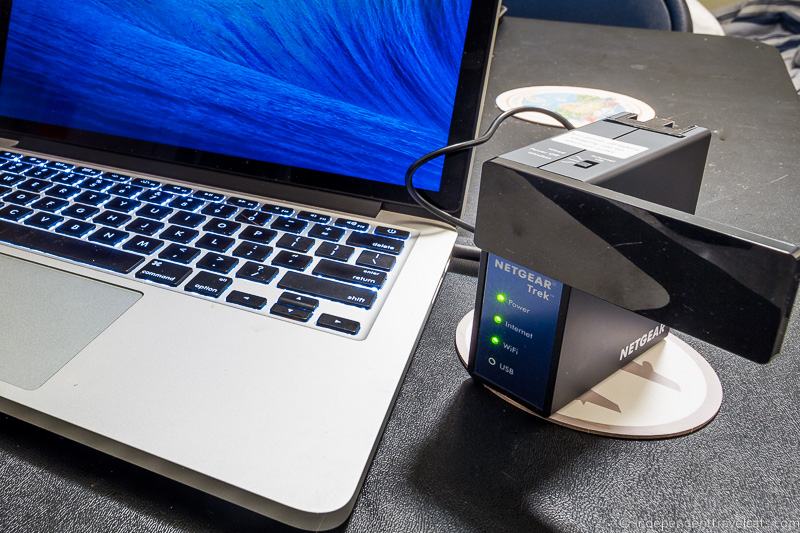
Table of Contents:
Basic Information on what a Travel Router Does
If you are new to travel routers, also known as portable WIFI routers, this section will help you understand what they do and whether they might be a good fit for your travels or not.
We understand that a lot of the terminology can be somewhat opaque, so Laurence has put his years of experience as a software engineer to use to help explain everything you need to know.
What is a Travel Router?
A travel router is a wireless range extender designed for people who are on the go and need to connect to the Internet when they are away from home. It also performs the functions of a wireless access point.
Just like you would use a home WiFi router to connect your devices to the Internet at home, you may also want to consider having a portable router to use when traveling.
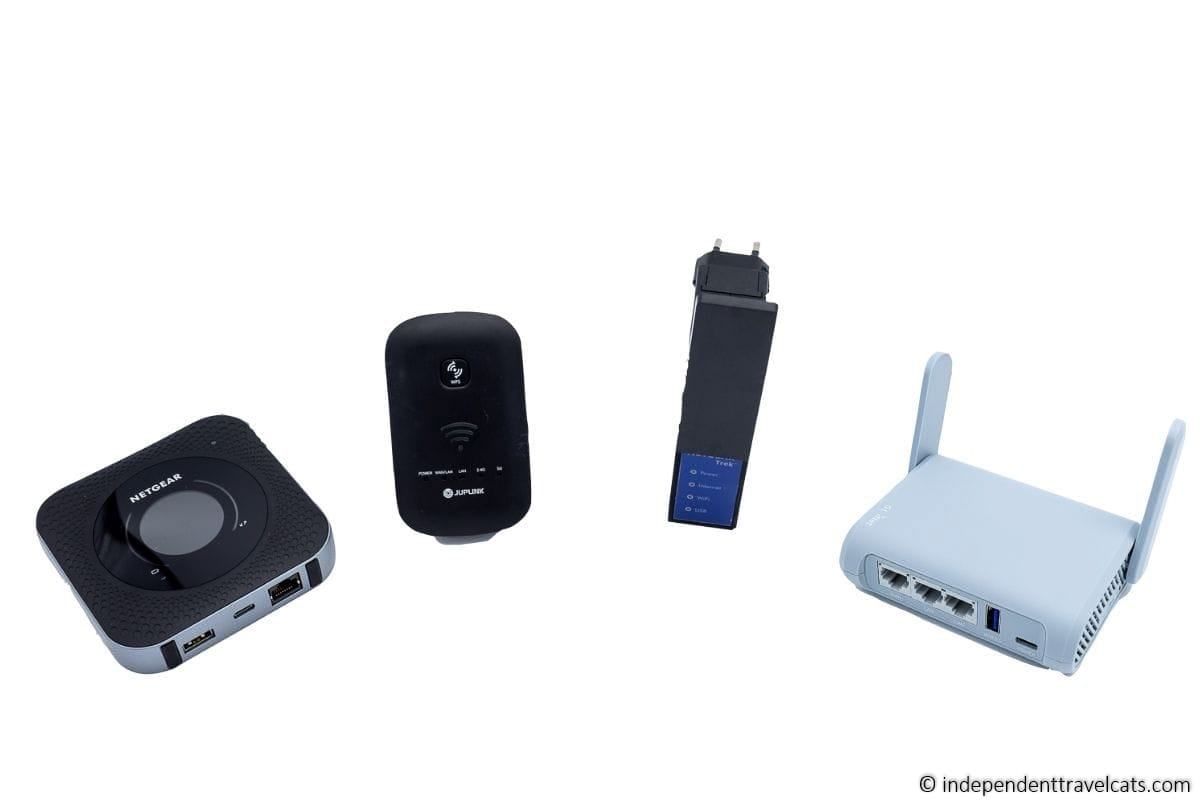
What does a Travel Router do?
Different wireless travel routers have different features, but the main feature is that they increase the range of existing wireless Internet networks. So for example, if you are in a hotel with a weak wireless signal that you are having difficulty connecting to with your laptop or phone, the travel router will amplify the signal so you can connect more easily.
Here is an overview of the main features of a travel router:
- A travel router can extend the range of wireless networks , meaning you can connect to a network somewhere that you might not have been able to connect to with your device because the signal is too weak. The powerful antenna of a travel router can pick up this weak signal and amplify it so your devices can connect to it.
- The travel router also creates a secure wireless network at a public hotspot to better protect your devices . Often when traveling the networks we connect to are unsecured and unencrypted, which means anyone could in theory grab hold of passwords or other data that we send to and from the internet. Travel routers feature a firewall which protects your personal devices from known DoS attacks and port scans from the Internet, giving you a more secure internet connection. However, it is still not recommended that you share sensitive information over a public connection.
- A travel router allows you to connect multiple devices to a network , even with a single login. The travel router is seen by networks as a single device, so if you are only given one login, you can still use multiple devices. You just login once from the travel router via a web browser (or in some cases a provided smartphone app), and then all your devices can be connected to the network created by the travel router.
- Some travel routers can also be used as a WiFi bridge . These have Ethernet ports so you can connect Ethernet-enabled devices wirelessly to an existing WiFi network. These can include Internet-ready TVs, Blu-ray players, and gaming consoles.
- Other features of travel routers may include the ability to connect to a wired network and turn that into a wireless network, to provide USB charging power to devices such as phones. to work without power, and even to act as an SD Card reader or media hub.
- Some travel routers (including one on our list) can also act as mobile hotspots, but this is not common. See our guide to mobile hotspots for more options in this area.
How much do travel routers cost?
Travel routers range in price from about $20 to $130, although more expensive models with more features are available. We’d recommend that most people look at ones in the $30 to $70 range, as these will work for most users.
If you have a small budget, you can get a decent travel router for around $30. See our recommended travel router list later in the article; they are listed in order by retail price. But beware of ones that are really cheap as they may not work well as advertised.
If you need a travel router that also acts as a mobile hotspot or has other specialized features, then you will pay extra. Some of these can be upwards of $200.

The Best Travel Routers 2024
There are a number of travel routers on the market today, which range in price and features. All the below models would make for a good choice, and the model you choose will depend on your budget and required features.
We currently use a GL.iNet GL-MT1300 which replaces our previous and now discontinued Netgear Trek N300 (PR2000).
We also use the Netgear Nighthawk M1 on some trips when we need access to the Internet as this functions primarily as a mobile hotspot, but it can also be used as a travel router.
Below are our current favorite recommendations:
1. GL.iNET GL-MT300N-V2 (Mango) Mini Travel Router
This is the first of a few GL.iNet routers that we recommend in this post. We like them for a number of reasons. First, they’re based on the OpenWRT software, which is a Linux based operating system that receives regular updates. GL.iNet keep on top of regular firmware updates, so the routers stay secure and get new features. This is unfortunately not as common as you might think, but it is super important to keep your devices safe.
As an example, the GL.iNet routers we list have all been upgraded to include support for WPA3, the latest wireless security standard. Regular updates and support for new features is definitely a benefit when it comes to a travel router, and means it will likely be more future proof.
Whilst this may all sound quite technical, the good news is that you don’t need to really worry about it if you’re not an advanced user. The devices have a simple interface and are easy to setup, and upgrades are just a single click option. If you want to dive into more advanced options you can, but the device works great out of the box, with setup via a simple web interface.
All the GL.iNet routers in our list also all support VPN credentials (see why you need a VPN for travel here ). This means that if you have a VPN account for more secure browsing like NordVPN , all your devices will connect through that when using this device.

The MT300N-V2 model, also known as Mango, is one of the more entry level options in terms of price and features, but if you’re looking for a small device that will do pretty much everything you are likely to need from a travel router, it’s a great option.
You get 300Mbps 2.4Ghz WiFi support, WPA2 and WPA3 support, and two 100 Mbps Ethernet ports for sharing a wired network. It’s also very privacy-focused. As well as the aforementioned VPN support, it also comes with built-in support for Cloudflare’s DNS over TLS. This basically means your internet connection is going to be pretty secure and hard for anyone to snoop on.
Another great feature is that if you have a smartphone with tethering support, or a 3G/4G data dongle, you can plug this smartphone into the USB 2 port on this router, and share the phone’s data over the router’s WiFi network.
The device is powered by USB, so any USB power source can power it, including a power bank or smartphone charger.
The reviews are positive and it’s available at a great price for a travel router that supports 300Mbps and only weighs 1.41oz. It is not as fully featured as some of the other options, in particular it only operates on the 2.4GHz band and the ethernet ports are 100Mbit rather than gigabit. However for most users this likely won’t make a significant difference.
If you are after a lightweight great value travel router with VPN support, this is a solid option.
Price: Check latest price on Amazon here
2. TP-Link TL-WR902AC Router
The TP-Link TL-WR902AC wireless travel router is another small, value option that is worth considering.

This weighs just 2oz, is powered by USB and supports the 802.11ac standard, which offers speeds up to 433Mbps. We’re not sure this speed will make much difference in the real world, as you’re always limited by the speed of the network you connect to, it is good to have.
It also has a USB port that you can connect a USB drive to for file sharing, or to charge a smartphone or other USB powered device. There’s also a 100Mbps ethernet port. It doesn’t have a built-in battery, so it does need to be powered from either a USB battery pack or a wall adaptor.
This is definitely an option if you’re looking for a small travel router at a good price, but be aware the software is not updated as regularly as the GL-iNet and it doesn’t have as many features such as VPN support.
Price: Check the latest price on Amazon here
3. NewQ Filehub AC 750
If you’re after a travel router with a few more features and great functionality, then the NeqQ Filehub AC750 is a good choice. It may also allow you to replace some of the other devices you typically travel with to pack less.

As well as offering a fast 433Mbps network with support for both 2.4GHz and 5GHz networks, this device features a 6700mah battery so it works without needing power, and can also be used to charge your devices.
It also features an SD Card reader and a USB port, so you can transfer files from memory cards to your hard drives or computer. It also has DLNA compatible media serving capabilities, although it is missing built in VPN support.
The latter means you can plug in a hard drive or memory card with your movies on, and stream them directly to your TV, laptop, or mobile phone. There’s a lot of functionality for the price and it weighs under 7 ounces!
Price: Check the latest price on Amazon here .
4. GL.iNet GL-A1300 (Slate Plus) Travel Router
The GL-A1300 from Gl.iNet is the latest version of the travel router we currently use. The GL-A1300 supports 400Mbps on the 2.4Ghz channel, and up to 867Mbps on the 5Ghz channel. It also supports up to 40 devices simultaneously, thanks to a relatively fast processor and lots of RAM.
Like the other GL.iNet routers it also gets regular updates and includes support for features like IPv6 and WPA3, as well as lots of other advanced features that make this perfect for both travel and at home use.

Now, to be honest, most WiFi networks you connect to aren’t going to offer internet speeds which this router can take advantage of. However, if you happen to connect to one that is that fast, this device will let you take full advantage of it! It also means when you’re not travelling you can use it at home as a fast network option to extend an existing network.
You also get three gigabit ethernet ports, a faster USB 3.0 port with media server capabilities, a micro SD slot for storage, and a USB-C port for power. As with the other GL.iNet devices in this list, If you have a smartphone that supports tethering, you can plug it into the USB port and share your smartphone data as well. Or, if you have a USB 3G/4G modem, you can plug that into the USB slot and share that data.
This router is also specifically designed to provide good support for a wide range of VPN services as well as support for IPv6, making this one of the most future proof travel routers we’re aware of on the market. It weighs 6.3oz, so it’s not the smallest option, but it’s still very compact and offers a lot of functionality for the price.
5. GL.iNet GL-MT3000 (Beryl AX)
Launched in December 2022, this travel router takes the speed crown from our previous fastest travel router, the GL.iNet GL-MT1300 (Beryl) , and as the name suggests, is an upgrade over the 1300 Beryl model.

If you want one of the fastest and most future proof travel routers on the market, this is the model to go for. It’s one of the few travel routers we know of currently that supports the latest WiFi 6 standard, with speeds of up to 574Mbps on the 2.4GHz channel and a blazing fast 2402Mbps on the 5Ghz channel.
It also has an incredibly fast dual-core CPU and double the RAM of the previous Beryl model, meaning it can support up to 70 connected devices simultaneously.
You also get a USB 3 port for tethering support and 2 LAN ports. One of those LAN ports offers gigabit speeds whilst the other is 2.5 gigabits, which is about as fast as you can get, and ideal if you also want to use this at home with a fibre connection.
It otherwise has the same features as the other GL.iNet products, so you get regular updates and support for VPN connectivity if you have a VPN account. If you do have a VPN, this router offers WireGuard speeds of up to 300Mbps, which is incredibly fast compared to other travel routers on the market.
To be honest, this router is probably a bit much for most general travel needs. However, If you have a lot of devices to connect, or just want the fastest option with all the features, and support for USB 3, this is the one to go for. At 7oz, it’s not the lightest option out there but you do get incredible performance.
Price : Check latest price on Amazon here .
6. Netgear Nighthawk M1
If you are looking for a product that is both a mobile hotspot and a travel router, the Netgear Nighthawk M1 (MR1100) is an option to consider. This is for people who know they are going to be traveling in places without Internet access.

As well as offering travel router capabilities like extending an ethernet or wireless network, this device also lets you put a 4G LTE SIM card into it, and use it as a mobile hotspot when you are away from wireless or ethernet.
It has a 5040mAH built in battery which you can use to charge your phone, media streaming support, can connect up to 20 devices, and supports both 2.4GHz and 5GHz 802.11ac wireless networks.
Note that this can work on multiple bands around the world, but it doesn’t support all bands around the world. Check to make sure it will work where you need it to work before purchasing. The device should come unlocked and be able to work with any compatible SIM card.
This is definitely a more premium product, but may be a good option for more frequent travelers, those who work remotely, and those who need to get online in more remote locations like RVs or rural settings. For more convenient travel, there are cases you can purchase for it to keep the router and cords, such as this one .
If you are looking for an even faster mobile hotspot that also doubles as a travel router, then you might consider the newer versions which support 5G, including the Netgear Nighthawk M5 (MR5200) and the Nighthawk M6 (MR6150 & MR6500).
These offer 5G compatibility, a touchscreen interface, and can support up to 32 devices. They are significantly more expensive than the M1, but worth considering if you have a larger budget and want a more future-proof router that supports 5G. The M6 series additionally supports WiFi 6.
Note that there is also a M2 version of the router available in certain markets like the United Kingdom and Europe. This one also offers more features like a touchscreen interface but it doesn’t include 5G support.
Price: Check latest price here
You can see and compare most of the travel routers above in one place on Amazon here .
What We Like about Travel Routers
Our primary use for our travel router has been to extend existing Wi-Fi connections. We have often encountered the situation when we are happy to learn that a wireless Internet connection exists in a hotel, bus, cafe, or airport but are then disappointed that the connection is too weak to connect to or is very slow.
Our travel router can then be pulled out to help strengthen the signal so that we can get online using our phone, tablet, and/or laptops. Although not always possible, it is also great in those situations where you can extend a Wi-Fi range from a hotel lobby to your room or from an indoor space to a patio.
The device also partially helps with the security issue of using public Wi-Fi hotspots by providing a firewall and some protection from common Internet threats; however, you should still be cautious about providing sensitive personal information over a public connection.
Travel Routers are also great in other traveling situations beyond just extending an existing wireless connection. There are situations where you might only be given a password to connect one device at a time on a wireless network or may have to pay for additional devices. Obviously, since we are traveling as a couple with two cell phones, two laptops, and two Wi-Fi enabled cameras between us, one Internet connection is not enough and we hate to pay for Internet!
So by whipping out this device, it will allow you to connect multiple devices to a wireless network using a single login. You just login once from the travel router via a web browser or the provided smartphone app, and then all your devices can be connected to the travel routers network, where they should all work simultaneously.
Also, if you are in a hotel or other location that only offers wired Internet access in your room, you can plug the Ethernet cable into the travel router and create a wireless connection that can be used for all of your WiFi-enabled devices.
Interestingly we have ended up using our travel router as much, if not more, at our apartment verses while traveling. When we lived in California, we had a good wireless Internet connection in our apartment but it became weaker when trying to use a laptop or phone outside on the deck.
We’ve set up the travel router to extend the range of our home wireless network to be able to blog more efficiently on the deck which was one of my favorite spots to blog . We have also used the USB ports on our router to charge cell phones and other devices and to plug in our USB hard drive for use as a network attached storage device to be shared on our home network.
We also like that most of these travel routers are powered through a micro-USB port, so you can actually power them from a laptop or USB power bank if you don’t have easy access to a power point.

Limitations of Travel Routers
Travel routers are not a mobile hotspot, so they cannot create an Internet connection if one does not already exist. So if you are wanting to actually use the Internet in place where there is no or very poor Internet, you’ll probably want to consider something like a mobile hotspot rather than a router or range extender product.
The Netgear Nighthawk M1 is a combo router and mobile hotspot, and so this could be an option as well if you need a hotspot.
For those wondering how to get online or how to find an Internet connection while traveling, see our travel guide to getting online when traveling . It also covers things like mobile hotspots, SIM cards, international data plans, VPNs, etc.
Sometimes despite the power of a travel router’s antenna, the signal will still be too weak to connect. In a few situations we have spent too much time trying to get a connection to work when the signal is simply just too weak. Some routers can also take a few minutes to connect to a network which can leave you wondering if it is just taking awhile or if it isn’t working.
Be sure to check before you buy to make sure the travel router is compatible with your devices! This should not be an issue for most newer devices but some may not work as well with older devices or those using older operating systems.
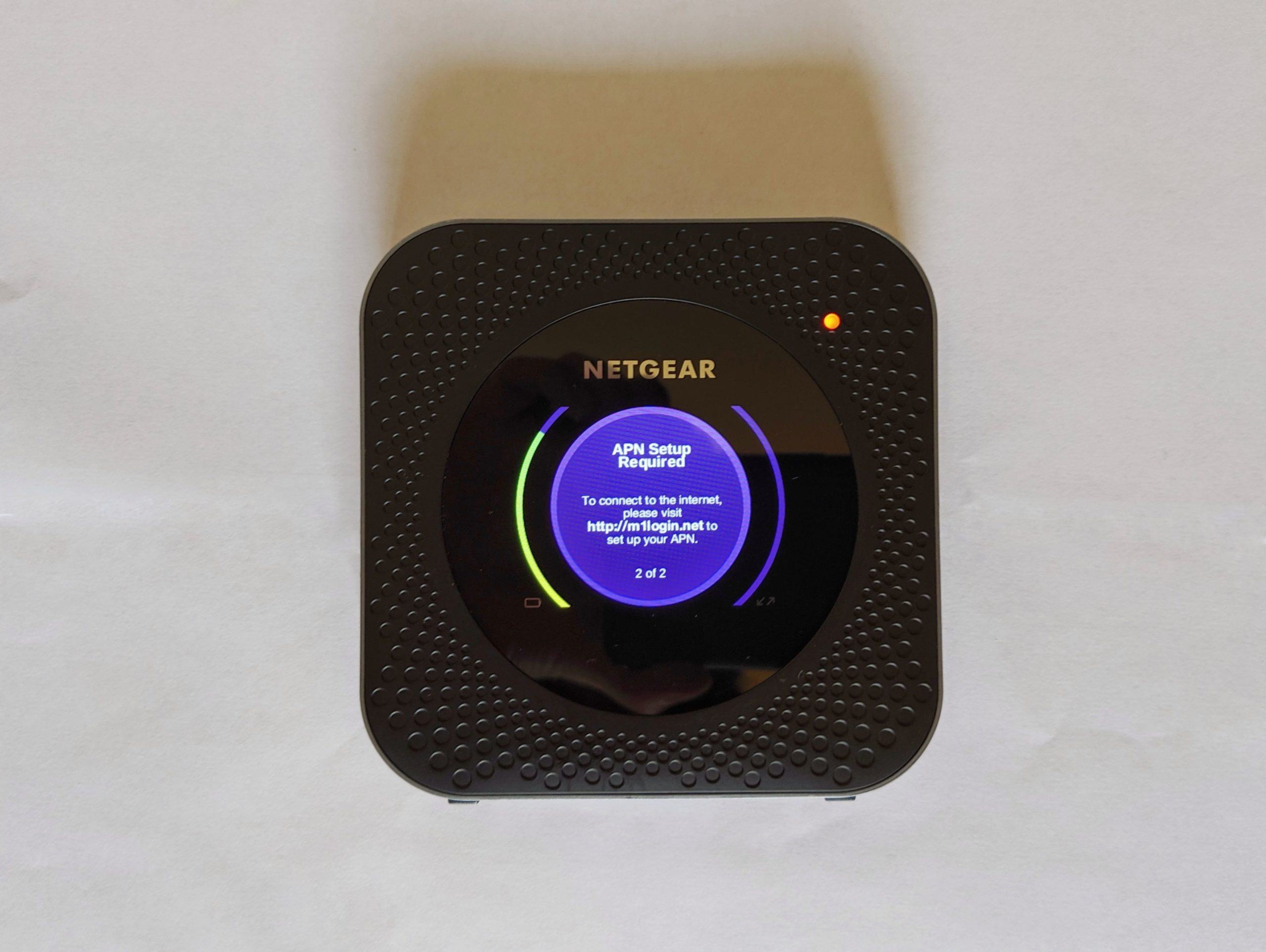
Do you Need a Travel Router?
Overall, we have found travel routers to be a benefit to our travels. They are generally easy to use once configured, and are compact and easy to travel with.
Given that many hotels only allow you to join a network using one device at a time (or charge extra for multiple devices), having a travel router makes it possible for us to use all our WiFi enabled devices at once without extra fees.
We currently use ours both at home to extend the range of our own home Internet and while traveling to extend wireless Internet connections, to login multiple devices using one password, and to add a little security while using public WiFi hotspots.

What issues do you have related to using the Internet while traveling? Have you used or would you consider using a travel router? As always, we’d love to hear any advice, tips, or questions you may have!
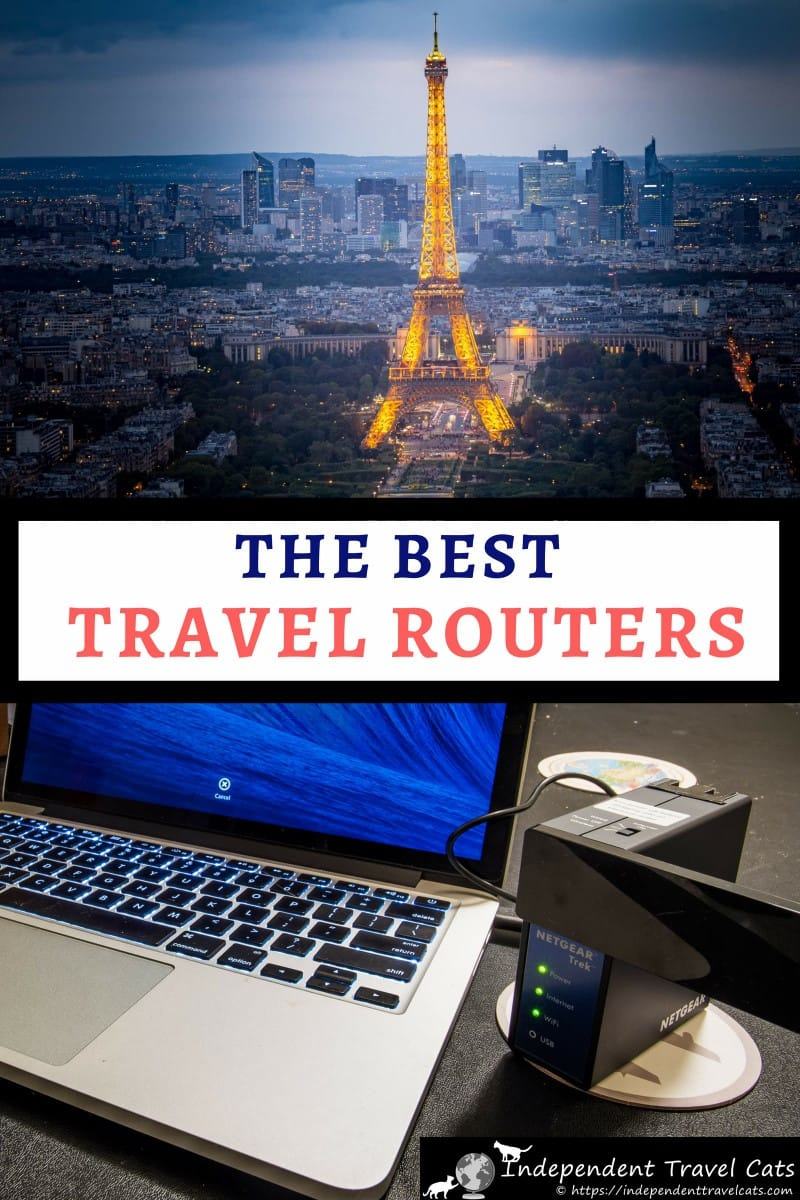
Share this Post!
There are 224 comments on this post.
Please scroll to the end to leave a comment
Andrew Scott Post author
April 13, 2024 at 6:37 am
I’m so overloaded with reviews and information that I decided I’m going to get something you use or recommend. Best review is one where someone recommends something they actually use. Now, you use the GL.iNet GL-MT1300 but Amazon says it’s no longer available. I think it said “try this instead” but I’m wondering if you’d recommend its apparent replace, whose model I can’t remember, or if you’d switch up/to one of the others you recommend/reviewed. Thanks in advance.
Jessica & Laurence Norah Post author
April 14, 2024 at 1:44 am
Yes, it looks like our Beryl router (MT1300) is showing as unavailable, so it looks like it is either out of stock or has been recently discontinued. GL.iNet has been updating and making new routers pretty regularly over the past several years. So based on that one, we would recommned the GL.iNet GL-A1300 (Slate Plus) router . It’s offers pretty much the same feature set as the MT1300, but with improved VPN support. It’s also at roughly the same price point as the one we bought.
If you want support for more recent network technology, then the MT3000 (Beryl AX) would be the option to go for. The Beryl AX (MT3000) is the same model as we have with more advanced technology but at a higher price point. For most travel needs though, the A1300 should work fine.
Either of the above models should work fine for you. We have had good luck with our GL.iNet travel routers and they offer free customer support as well as free returns on Amazon. I would say they are the most reliable brand out on the market right now for regular travel routers. You can, of course, also ask us any questions you may have about routers and we are happy to try to help.
Hope this helps and wishing you happy travels!
Best, Jessica
March 24, 2024 at 1:16 pm
This is a follow-up to my first comment but unable to reply to unapproved comments hence this one.
Just realised that since they are invariably powered via USB, rather than buying one with a built-in battery, you could just use a power bank to power them. The trick would be knowing what size of power bank you’d need for a given travel router.
March 25, 2024 at 4:25 am
Yes, Internet on cruises can be challenging. I think it will depend on the Wifi signal (if it is only available in the cruise cabins) if it will reach to other public areas or not.
The majority of the travel routers we recommend accept a USB input for power so many can be charged/powered by battery. The main thing is to check that the battery bank puts out an output that matches the input of the travel router. Most travel routers accept a 5V 2amp, 3amp or 4amp input, which should work with most battery banks. However, some higher powered routers require a higher voltage, so just check the specifications to be sure.
In terms of size, a 15,000 to 25,000 mah battery bank such as this one by INIU should provide many hours of operation.
Hope that helps and hope you have a wonderful cruise!
Best, Jessica & Laurence
March 24, 2024 at 1:06 pm
We’re looking at one for use on cruises since we learned we can’t hot-spot the WiFi each of phones will have access to. Thought we’d only be able to use it in our room until I read about the one that is battery powered. That would allow us to use it beside the pool or in some other public area. THAT would be extroflexible.
March 25, 2024 at 4:16 am
See our response to both of your comments above to your second comment.
Kelly Post author
December 28, 2023 at 9:24 am
Hi – we sure appreciate the great info!
I was hoping to learn if you thought a travel router would be a good choice to replace our router in Mexico so that we are able to access US streaming through our VPN? It would become our new permanent router there. And/or would we able to use 2 routers with the same VPN, one for other travel and one for our Mexico residence?
December 28, 2023 at 1:54 pm
Happy to try to help with your travel router and VPN questions. So it sounds like a permanent router would be best for your Mexico home and most home routers by GLiNet, Netgear, and many other brands will support a VPN. So for example, this one by GL.iNet should work find as a home router with a VPN service. A home router is going to be larger (so not ideal for travel) but is going to generally perform better overall than a small travel router and have more features, so best to stick to that for home use.
It sounds like you also want a more portable travel router for when you travel internationally to other locations outside of Mexico and the USA? And in that case, most of the midrange and above travel routers support VPN services. You just want to avoid the really cheap ones. Any of the GLiNet travel router options we recommend above such as the Slate or Beryl models should work fine with most VPN services and they are really good travel routers as well. Just see our recommended list above.
And yes, you should be able to use the same VPN service across your home and travel routers. If you stick to the same brand across your routers, it might be a bit easier with configuration but it probably doesn’t make too much difference.
It sounds like you probably already have a VPN service for traveling, but if not, Laurence made a guide and a list of VPNs for traveling here that might be useful.
Hope that helps but just let us know if you have any further questions!
December 28, 2023 at 4:49 pm
Big thanks, Jessica – all VERY helpful information to make my learning curve more bearable.
I will look further into supporting your sites.
Much appreciation,
December 29, 2023 at 6:32 pm
You’re very welcome, and just let us know if you have further questions as you do any further research on routers and VPNs!
Patricia Post author
September 18, 2023 at 9:00 am
Do I need any cabling to use these travel routers with an iPad Pro. Looking at the photos they seem to have Lan connectors and usb sockets , but at the moment at least iPads don’t have either of these. Please advise. I need the router to connect to Wi-Fi when the signal is weak but I would also like it to be as secure as possible thank you. Great reviews
September 18, 2023 at 9:55 pm
Hi Patricia,
No, you don’t need any cables to be able to use any of the recommended travel routers with your iPad Pro, they all can be used with WiFi with your devices. However, most also allow for LAN Ethernet connectivity if you need a wired connection and many also have USB ports. But most people just use their devices over WiFi so you would be fine with any travel router if you are just needing to mainly connect your devices for security, easier connectivity, and extending existing WiFi.
Bob Simmons Post author
July 2, 2023 at 10:05 am
Thanks for the great article. My issue is with WiFi that requires payment after entering password. Also each device requires payment. On a cell phone, after logging in, it pops up a window (browser?) where you enter the credit card info. Do any of these travel routers have that capability, to enter payment information? Reading the user manuals it appears the answer is no. In your travels maybe you have encountered this issue.
Laurence Post author
July 4, 2023 at 9:34 am
It’s our pleasure, and we will do our best to try to help you.
So the window that pops up to take payment is called a captive portal, and it’s the same thing you often encounter even with free Wifi where it might ask you to enter your name or e-mail address to access the internet. All the travel routers on our list support this, so you can log in and pay if necessary for internet access. A window will pop up on the first device you connect with where you can pay. A pop-up blocker or ad blocker might stop it from happening but in our experience a browser window normally just appears to log in with.
Let us know if you have any more questions!
Laurence & Jessica
Luke Post author
May 25, 2023 at 5:08 am
Just want to say thanks for the sharing informative article, very helpful in choosing the best travel router for our next trip!
June 2, 2023 at 4:39 am
You’re very welcome and glad to hear you found the best travel router for your upcoming travels! And thanks for taking the time to comment.
B.Balakrishnan Post author
May 19, 2023 at 4:04 am
This blog post on the best travel routers for the internet while traveling in 2023 is a lifesaver! Staying connected on the go is crucial, and these router recommendations are just what I needed. Thank you for the helpful insights!
May 21, 2023 at 9:50 am
Hi there, So glad you found our travel router review helpful. Just let us know if you have any questions!
Arnold Machel Post author
April 23, 2023 at 9:08 am
Thanks for the great article. I’ve used a travel router for years and found them super helpful, especially in situations where I want to use a portable Chromecast, but the hotel WiFi security settings won’t it allow to connect directly to the hotel WiFi.
I am now using a laptop that needs a high wattage charger (ideally 65 watts) and would love to finde a travel router with that kind of charging capability, but I can’t seem to find the technical stats on most of them. Any thoughts?
April 24, 2023 at 1:28 am
Glad to hear you have found a travel router useful on your travels. So it sounds like you are looking for a travel router that doubles up as a powerbank that you can use to charge your laptop? Unfortunately, we aren’t aware of any travel routers on the market which offer that level of output, most travel routers which have the facility to charge devices have fairly small batteries and don’t offer high wattage outputs. The ones that offer the ability to charge a device, are more designed to top up a smartphone rather than to power a laptop.
So if you want a portable device to help charge your laptop on the go, I would look at powerbanks like this one that are speciically designed to charge laptops.
Hope that helps! Jessica
April 24, 2023 at 6:34 am
Thanks Jessica. Too bad. Was just hoping to get one device to do both. Good luck with the blog.
April 26, 2023 at 2:19 am
You’re very welcome. Yes, unfortunately I don’t think there is a device that would be able to do both those things well. Feel free to come back and let us know what travel router and charging device you decide to use on your next trip as it may be helpul to furture readers wanting to do the same thing.
Sherry Duvall Post author
March 6, 2023 at 6:46 am
Thanks for this great article! I have just discovered travel routers and am intrigued as to whether this would be something that would work for my family. I would like to know if any of these would work on a cruise ship? We have to pay for each device, or log off and login on them which is such a pain. Cruise ships are huge so will it work when you are far away from your room, and if so, which one would you recommend? Thank you for any help!
March 6, 2023 at 8:44 am
Our pleasure! So to the first part of your question, yes, this should work to allow you to use multiple devices with a single login. The travel router will appear as one device to the cruise ship network, and then you would be able to connect your devices to the travel router’s network without needing to keep logging in and out.
For the second part of the question, travel routers have a variable range but it won’t cover a whole cruise ship unfortunately. It would work in your room and then nearby, but all the walls etc would reduce the range. So it wouldn’t cover the whole ship sadly. But any of the travel routers on the list work in a very similar way in terms of login and would cover your room.
Hope this helps!
March 6, 2023 at 9:41 am
Thank you very much…guess I will save my money!
QBM Post author
March 1, 2023 at 9:21 pm
This article from Independent Travel Cats’ blog is a comparison and review of the top portable WiFi routers for travellers. This post does a good job of researching and comparing the features, benefits, and cons of each router. Personal anecdotes and experiences from the bloggers’ travels are also included in the article. In sum, if you are a frequent traveller in need of a dependable and transportable router, you will find this article to be a gold mine of information.
March 2, 2023 at 4:14 am
Thanks so much for the very kind summary and recommendation of our travel router review article!! If you have any questions about portable routers, feel free to ask!
Daniel W Post author
February 24, 2023 at 8:33 pm
I appreciate what you did with this blog post, especially the way you keep it updated. It is the best online resource for people looking for information on travel routers, thanks!
February 27, 2023 at 7:12 am
Thanks for the kind words and glad you found our travel routers review article useful! If you have any questions about choosing the best travel router for you, just let us know. Happy to try to help!
Karen Arnauld-Bakelaar Post author
January 20, 2023 at 10:21 pm
This i8s so incredibly useful – thank you! Can you help me sort out which might be the best option for me? I mainly work in South Africa, which means we have long spells without power, so anything that runs on battery would be nice to have. I’m in a rural area, so even while working from home I often have trouble getting a wifi signal, especially in bad weather.
I need the signal to be strong enough for Zoom meetings, etc – and often it’s not.
I also need a portable option for when I travel, but I don’t know if I need something to boost a signal or to hotspot – can you help me with this?
All internet here is wifi – I have a home plug-in router with a SIM card in it, and a small portable router as well, but they don’t always do the job!
January 23, 2023 at 7:22 am
It’s our pleasure. So it sounds like you need a mobile hotspot rather than a travel router. A travel router can only extend an existing WiFi signal.
A mobile hotspot works over cellular networks (like a mobile phone). However this can be affected by bad weather, so would basically be the same situation as you are in as your plug-in router likely works the same way. The only difference is that a mobile hotspot has a built-in battery.
So in bad weather situations, there may not be anything more you can do as strong weather can affect the overall signal which could affect the signal for any kind of devices using WiFi or mobile signals. But you might try a hotspot to see if that helps as it works with a different type of signal (cellular signal versus WiFi).
Monte Post author
December 23, 2022 at 3:10 pm
Is there a travel router best suited for offline multiplayer gaming? My wife and I often wind up in areas with no internet. A normal home router constantly nags us with the “you aren’t connected” screen. We know! That’s why we’re playing Minecraft!
December 24, 2022 at 6:48 am
Happy to try to help. So I am guessing the home routers you are referring to are ones that are not your own but ones you stay in while traveling?
So none of the travel router models we recommend are specifically designed for offline gaming. However, we think any of the Gl.iNet routers on the list would work in this scenario, allowing you to create a local WiFi network that your devices can connect to without needing to connect to another WiFi network. However, we have not tried this specific scenario so it is hard to say if one or another router on this list would be better suited to the task. But the more advanced ones offer more features and more future proofing.
Another option to try might be to see if one of your computers (or smartphones if playing on them) allows you to set up a WiFi hotspot. Some Windows 10 and Windows 11 laptops for example have the option to allow you to set up a local WiFi network, which you could then connect your other device too. This may be another possible solutation you could check out.
Anyway, hope that helps and we’d love to know what solution you come up with that solves your issue as it may be useful to future readers.
Virag Post author
November 28, 2022 at 8:22 am
Hi, Thank you for this amazing article. I travel quite a lot and work at the same time and I would need something that I can use to boost the available public wifi (like in hotels or coffee shops). Which one would you recommend in this case?
Thank you in advance, Virag
November 28, 2022 at 9:38 am
Glad you found our travel routers guide useful. So any of the routers listed in our guide would work for that purpose but the GL.iNet routers with the antennas, such as the Slate, Beryl, or the Slate AX models, would have the best performance. We personally use the Beryl model . So I’d recommend any of those three models or a similar travel router to those.
I believe Amazon has been offering discounts on most of the routers for the past week so I would definitely compare prices as you can sometimes get one of the newer models for a good price when they are running discounts.
Hope that helps, and just let us know if you have further questions.
Steve Brown Post author
October 31, 2022 at 11:45 pm
Thank you for sharing the list. I really needed one. I have dead wifi zones with which the travel routers could help.
November 1, 2022 at 9:19 am
It’s our pleasure, glad you found our list useful. So whilst a travel router can work to resolve dead zones, you might prefer to purchase a WiFi extender instead, especially if you plan to use this at home. They tend to be a little bit cheaper because they don’t need as much functionality.
Another option to solve dead zones would be to upgrade to a mesh WiFi network – see our guide to the best home WiFi routers for ideas in that area. The mesh system can help make it so that the WiFi is able to extend throughout your home.
Hope that helps and just let us know if you have any questions!
AJ Post author
October 21, 2022 at 5:01 pm
I purchased two of these items ( #1 and #3) but since I am not tech savvy at all, they were impossible to use. I tried reading and rereading the instructions. I tried the company websites. I tried many youtube videos. I sat between Carls Jr and Walmart, who both have free wifi. I was able to scan each one with a success response. BUT NO WIFI.
This sucks. When someone in an actual store can hook me up and show me how to use it, and provide an actual phone number I can call when I am on the road (which I always am), then I’ll buy one. But reading reviews and going to amazon, and returning said items to amazon, is not my cup of tea.
October 21, 2022 at 5:09 pm
Sorry to hear that you are having issues with using your travel router while traveling. So most travel routers require a little bit of setup.
Have you tried using them inside where you know the WiFi was a good strength and working properly? If you were sitting outside the stores, the public signal might not have been strong enough for instance to really work.
If you have already gotten the manufacturer’s instructions (GL.iNet has some really detailed ones online you can get), you can also try contacting their customer support. If you want in-person support, you could also try going to a local tech store near you (or a chain like Best Buy) that sells travel routers and might be able to troubleshoot with you and help you.
Hope you are able to get it to work!
David Post author
October 1, 2022 at 10:31 pm
For travelers who need access to the internet while traveling, this device sounds very useful. In our everyday life we cannot think of going a day without internet. Thanks for sharing for your valueable information.
October 3, 2022 at 6:55 am
Yes, travel routers can be very useful for those who need to be connected while traveling. If you have any questions about travel routers, just ask!
Chris Post author
September 7, 2022 at 1:54 am
I’m having trouble backup my extender settings, it takes saying that backup is done but can’t find the file??!!
September 7, 2022 at 5:08 am
Many travel routers do allow you to back up their settings, and save the settings to a file. But you will want to check the manual for your specific travel router model to see if it has that functionality and how to do that.
When you backup something as you did, it should give you the option to choose the file location when you do so. So if you check your browser downloads folder it should be there where you set it to save. Or check your manual for the default location.
Hope that helps, Jessica
Jason Post author
August 1, 2022 at 7:32 pm
Hello. Thanks for all the great info. I have been researching travel router setup, but am not sure if it’s possible to do what I’m attempting. I hope you can help me out.
I have an “older” ASUS Dual-Band router that was replaced when we upgraded our home to Eero Mesh router. What I’d like to do is set up the old ASUS router with the same SSID & password as my current home router (the Eero), so that I can take the ASUS on family vacations, connect it to the hotel/condo/house/etc. WiFi, and then all of our devices will automatically connect to it (since they have the same SSID/pswd already saved from our Eero router), without having to sign in all of our devices to the hotel/condo/house/etc. WiFi.
I’ve found some articles that explain how to set up 2 routers with the same SSID & pswd, but they all require connecting the router to a laptop for the initial setup/configuration. So, the real question/problem is: I don’t want to take my laptop on vacation, just to connect my old ASUS router to the vacation home’s WiFi. So, is it possible to set up my old ASUS router at home, and then plug it directly into the vacation hotel/condo/home router via ethernet cable, or will I need to bring my laptop to open a web browser and complete the setup?
August 2, 2022 at 12:10 am
It’s hard to really give specifics without knowing the type of router and equipment. But if the main step that is required is to connect to the Asus router via a web browser over the WiFi connection, then you shouldn’t need a laptop specifically to do that as you can just use the web browser on your smartphone to achieve the same thing. So that part of it should work.
I would definitely test this setup at home first to see if you can extend your existing network with your old Asus router to see if it works as you intend. If you can’t get it to work at home, I would not recommend taking it on vacation. If you can’t get it to work, I would just recommend getting a new travel router that will do what you need it to do for your trip.
Best, Laurence
David Paker Post author
July 4, 2022 at 1:34 pm
Wow! You guys are doing an amazing job. Following your tutorials, I learned so much !!
July 5, 2022 at 2:38 am
So glad you found our articles helpful. If you have any questions about travel routers, just ask!
May 12, 2022 at 10:42 pm
Thanks for the review. I’ll definitely look into it. It really is frustrating if the signal is slow. . I’ll be willing to carry extra weight if it would boost connection,.
May 13, 2022 at 2:07 am
Yes, a travel router may definitely be able to help with that. It does require packing something extra but travel routers are designed for travel and many of the models are pretty small and lightweight these days so won’t add a lot of extra weight! But I would recommend keeping the dimensions and weights of each model in mind when choosing the best travel router for you.
Ryan J Post author
May 11, 2022 at 6:19 am
Thank you for such a thorough and informative writeup! I also read your Best Mobile Hotpots review and was inspired to purchase the Nighthawk M1100, especially considering it’s added ability to be a travel router and boost a current wifi signal. Will be travelling to Europe and staying at many AirBnb’s. Just in case any of them have a weak wifi signal, I’ll be prepared! Now that I have the device, I can’t seem to find instructions on how to use it as a travel router specifically. I’ve searched everywhere online, and there seems to be different wording out there “turn the m1100 into a modem, use it with a modem, etc. Saw one video on how to use the nighthawk with another router (boosting that router’s signal), but it requires connecting an ethernet cable from the router to the Nighthawk. Is that the process of using it as a travel router? Ideally, I’d like to be able to avoid using the ethernet cable, especially if on a public network (i.e. train) that I need to connect to but is weak. Or staying somwhere that I don’t have access to the broadcasting router. Any specific instructions on using the Nighthawk M1100 as a travel router without using an ethernet cable? Thanks in advance.
May 11, 2022 at 9:28 am
So yes, the Nighthawk M1100 is mainly used as a mobile hotspot, but it can also be used as a travel router. So it is definitely possible to set up the MR1100 as a travel router to share a WiFi network, but the manual is not super helpful. We remember this ourselves when we set it up.
The section you are looking for calls it called WiFi data offloading. If you load the MR1100 manual on this page ( https://www.downloads.netgear.com/files/GDC/MR1100/MR1100_UM_EN.pdf ) – you are looking for the instructions on page 30, titled “offload your mobile internet connection”. There are sections here on setting this up for either Wifi offloading or ethernet offloading. You are looking for the instructions on Wifi offloading.
Hope that helps, but just let us know if you have any further questions. We have used both the Nighthawk M1 and M2 and have set them up to work as a travel router ourselves so happy to help!
May 12, 2022 at 6:34 pm
Amazing. Would have never found that out on my own. Thank you! Will let you know how it goes. My wife and I are being “digital nomads” for the first time having worked remote in the States for the past 20 years. Will be travelling to Spain, Portugal, France, Italy, Croatia, Switzerland, Germany, UK, and Ireland over the course of 5 1/2 months. Leaving next week and super excited!
May 13, 2022 at 2:06 am
Glad that helped and you should be able to test it out before you leave. Having the ability to use it both as both a travel router and a mobile hotspot (when you don’t have WiFi) is nice for a long trip like that.
Enjoy your time working as digital nomads in Europe!
Paul Post author
April 30, 2022 at 2:16 pm
Hi, we’re staying at a place that requires us to re-log in every 24 hours. Are there travel routers that will automatically take care of that for you?
May 1, 2022 at 5:33 am
So we aren’t aware of any travel routers that would be able to automatically do this out of the box. With a travel router there is the advantage that you only have to do this once, rather than once for each device you connect to the travel router. So you should be able to just do the necessary daily login once and then all the devices connected to your router should not have to do the log-in.
Depending on how technically minded you are, it is worth pointing out that the GL.iNet routers are based on the OpenWRT software, which allows technically-savvy users to install extra packages if they want and run custom code. However, this is beyond the scope of most users (and not necessary or recommended in most cases). However, if that does describe you though, then that’s an option as you may be able to write code (or find code written by someone else) that would be able to do the auto log-in each day.
Pasu Post author
April 28, 2022 at 9:24 pm
“A travel router allows you to connect multiple devices to a network, even with a single login. The travel router is seen by networks as a single device, so if you are only given one login, you can still use multiple devices. You just login once from the travel router via a web browser (or in some cases a provided smartphone app), and then all your devices can be connected to the network created by the travel router.”.
That’s exactly what I need. Connecting to a WiFi and giving the signal to other devices.
But sorry, which if the mentioned models can do this?
Thank you for your help
April 29, 2022 at 3:51 am
All of the travel routers we mention in our article can do this as this is one of the main features of most travel routers. The one we are personally currently using is the GL.iNet Beryl model above, but as noted, any of the above models can do this.
For instance, we often use it with the WiFi in a hotel to connect all our devices at once without having to log in each one. It can also help get around device limits imposed by some hotels as you just need to connect the travel router.
Travel routers can also make your connection more private and secure, and you can also use most of them in conjunction with most VPNs.
Hope that helps and just let us know if you have any further questions.
April 20, 2022 at 8:43 am
Thanks for this article, but it wasn’t clear to me if any of these support what I want to do: I want to be able to connect a baby monitor to a hotel network (for instance, so a babysitter can keep an eye on the kids from a living room), but my baby cams don’t support connections to captive networks. I’ve gathered that this is where the travel router comes in, allowing me to create my own network after connecting to the hotel’s wifi. What I am hoping to find though, is a travel router that does NOT require an Ethernet connection to make that initial connection to the hotel’s wifi, as not all hotel rooms come with Ethernet ports. It looks like the HooToo TM-02 does this, but I also note that that model is getting a bit long in the tooth at this point. Do any of your recommendations support what I am trying to do? Thanks!
April 20, 2022 at 10:03 am
So none of the travel routers on our list require an ethernet connection to make the first connection, they all work over WiFi (although some can work via ethernet as some have ethernet ports as we note). The way it works is that you turn on the travel router and connect your phone or laptop to the travel router’s WiFi network. Then you use a web browser to configure the travel router to connect to the hotel WiFi network, and if necessary login through the captive portal.
In our experience, the GL.iNet products are the currently the more reliable and most regularly updated options. So those would be our top recommendations, but any of these should work. But newer models are more future proof.
Just a note that setting up cameras or using surveillance devices in hotel rooms is illegal in many countries if any person filmed is unaware of their presence (so if the babysitter or other hotel staff were filmed without their knowledge). So just something to be aware of.
Shannon Post author
February 1, 2022 at 12:02 pm
Hello, I’m currently at a campground with about 4mbps Wi-Fi. I need 200 mbps to do my job and i need help finding the right option. I need something that works with any internet provider and will give me a minimum of 200mbps. Can you help?
February 2, 2022 at 2:39 am
Hi Shannon,
So 200 mbps is very very high and you are unlikely to get that unless you are able to access a 5G mobile network AND a very good cellular signal. The average download speed for 4G is 8-10 mbps. Do you possibly mean 20 mbps that you need for work?
A travel router can help increase a connection but it is not going to make it much faster in most cases. The connection speed at the campsite may be 4mbps at its max and if so, there is nothing you can do to increase that. Especially not 5X or 50X!
If the campsite does have a very fast connection but you are too far from the signal then a travel router can help, but it will likely not make a very big difference, it will generally just make the connection more reliable and secure. But if you travel a lot for work then a travel router like the Beryl one we list above is probably one you would want to have. But you still need to be in places that have a decent connection.
So your best option would be to look into mobile hotspots. These connect over a mobile network and can give you either 4G or 5G speeds depending on the type, and you would need a SIM card to go in them as they are similar to phones in that regard. Of course, you still would need a good cellular network reception for them to work. You can see our guide to mobile hotspots here .
So the best advice is to make sure to do some research before you head to a new place to see what its WiFi connection speed and mobile signal is so that you can see if it a place that you would be able to work from or not. If so, then if you have a travel router and/or mobile hotspot, it should help you work remotely when needed.
Looking to the future, a better option might be something like the Starlink satellite internet which can provide fast internet via low orbit satellites anywhere in the world.
Sage Post author
June 19, 2022 at 11:36 am
Hello! To follow up on this reply (and I am not a techie 🙂 ) I was planning on working from France through a hotel’s WiFi but maybe I should use my cellphone, which is verizon 4G LTE and can be a hotspot? In general, are cellular networks faster than a hotel wifi? I guess it depend on their carrier?
Also, do you recommend a VPN whichever way we access the internet – via cellphone hotspot or hotel wifi?
June 20, 2022 at 4:07 am
So the answer as to whether the hotel WiFi is faster than your cellphone 4G is a difficult one to answer. WiFi is definitely capable of being faster than 4G, but this depends on a number of factors, including the speed of the internet connection the hotel has, how far from the router your device is, and how many other people are using it. 4G also has similar issues, depending on factors like how far away the nearest mast is, if your room is near to a window (walls can weaken a signal), and so on.
In most cases, I’d say that hotel wifi is likely to be faster, but this is definitely not always going to be the case. In general, in your situation, I’d probably say to go with the less expensive option. This is likely to be to get a travel router and use the hotel WiFi (the travel router can then be used on future trips as well). But it depends on the cost of your international data plan.
If you decide to get a travel router (and use hotel WiFi), just be sure to read the instructions and test it out locally before your trip so you know how to set it up and use it before you get to France. Any of the routers we list should work for your situation, our favorites are the ones by GL.iNet.
When it comes to a VPN, VPNs can definitely provide more protection. However, if you are going to use a travel router or cellphone hotspot to connect, it is probably not necessary. Cellphone hotspots or a travel router are going to be more secure because it’s just you connecting to your connection, and mobile networks are a lot harder to hack.
The security concerns over public WiFi networks are not as great as they used to be now that the majority of the web has moved to https. That means the data that is sent from your device to the web and back again is encrypted end to end, so it’s a lot harder for people to snoop on it. In the old days of unencrypted websites and public hotspots, it was fairly easy for someone to hack into someone’s connection, but this is much harder today, especially if you stick to secured websites.
There are still advantages to using a VPN though. Obviously, there is the additional peace of mind, but also some websites block users from specific countries and some countries may block access to certain websites. So a VPN can usually get around that for travelers who need to access websites from their home country. One of the advantages to surfing the web with a VPN in France we’ve found is that it keeps all the websites from constantly redirecting you to the French versions.
Note that some jobs require employees doing remote work to use a VPN or only sign into accounts using some sort of secure connection. This is especially the case if you deal with client data or other sensitive information. So be sure to check your job’s remote work policy regarding security.
We have a post that reviews VPNs for travel here , if you decide you want to use a VPN.
Hope that helps, and feel free to follow-up if you have further questions. Wishing you a great trip to France.
Will Pearce Post author
December 17, 2021 at 8:28 am
I’ve had a HooToo HT-TM05 for about 5 years, and was initially very happy with it. Increasingly, though, I’m encountering web logins on hotel wifi–a situation that I’ve not been able to handle with the HooToo.
I’m aware that some travel routers can be configured with the web login credentials so that they’re able to establish the wifi connection, but it’s not clear from your review which of your recommended devices can do that.
Could you clarify that, please. Also, if you know of some way to get the HooToo to handle this situation, I’d be glad to hear it.
December 17, 2021 at 1:15 pm
Sorry you are having issues with your travel router. Hotel log-ins can be tricky. So the HooToo HT-TM05 should be able to handle the situation you describe (and HooToo noted this in their old FAQ section), as that’s a common scenario for using a travel router. You would normally connect to the Hootoo network with your smartphone or laptop, login to the Hootoo and select the hotel network, and then open up a new browser page from your phone or laptop and try to use the web. This should launch the hotel login page.
Sometimes though this might not work, and it’s possibly because the Hootoo is an older device as that model is now several years old. There are various reasons that it could fail, including a custom DNS setup on your device, use of a VPN, or trying to navigate to some https pages. It’s hard to troubleshoot without seeing the error message you are getting. How far into the process are you getting? Are you getting any error messages?
If this occurs in more than one hotel, and you can’t get it working, I’d recommend contacting HooToo for support. They list the following info on their website: Tel: 1-888-456-8468 (Monday-Friday: 9:00 – 17:00 PST) and email [email protected]
It looks like the company has not updated information on HooToo HT-TMO5 for a couple of years now and it may be that the company is no longer supporting the device. We also just saw that it has been removed from Amazon.
If nothing is working, it is probably that you just need to upgrade the device. I’d recommend upgrading to one of the newer GL.inet, TP-Link, or Netgear travel router models. We’ve used both the GL.inet Beryl and Netgear M1 in hotels recently without incident.
Hope that helps and just let us know if you have any further questions!
Pipps Post author
November 18, 2021 at 2:45 am
Thanks for the great guide and clear recommendations👍
November 18, 2021 at 2:13 pm
Thanks Pipps for taking the time to leave a comment. Glad our travel router guide was helpful and just let us know if you have any questions!
November 19, 2021 at 2:18 am
My pleasure, you definitely got the Amazon referral 👍
Nikki Mag Post author
October 14, 2021 at 10:12 pm
Thank you for this wealth of information, greatly appreciate it. I am not tech savvy whatsoever and was hoping you had some information to share.
My employer requires an ethernet connection from a modem/router to the company laptop. We are unable to directly connect to wifi. As of today, is there a recommended travel router that I can connect via ethernet cable? I apologize if youve answered this already and I missed it.
October 15, 2021 at 6:35 am
No problem, and happy to try to help!
All the GL inet travel routers we recommend come with at least two ethernet ports. For instance, the Slate router has three Ethernet ports and a lot of other features. So you can connect to the router via an ethernet cable, and then configure the router to connect to either a WiFi network, or to another network with the other ethernet port on the router. This is fairly plug and play so shouldn’t be too tricky, and the instructions that come with the devices are quite easy to follow as well.
You may also want to talk to your company’s IT department as well about the issue since it sounds like they require a certain level of security to be in place for use. If you, for instance, need to use a VPN to connect to your work data, the Slate router is compatible with over 30+ VPNs but may not be compatible with all VPNs.
Hope that helps, and just let us know if you have any other questions!
jack Post author
October 9, 2021 at 7:48 pm
thanks for the awesome article I am looking for a mobile hotspot and a travel router, I need it very much. I found your article. Very beautiful and will come in handy for me.
October 10, 2021 at 4:53 am
Glad it was helpful and hope you found a travel router that works for you. If you are looking for a device that can be both a travel router or wireless hotspot, then the Netgear Nighthawk router is probably your best bet. If you are looking for two separate devices, then you can also check out this article about choosing a mobile hotspot .
But do let us know if you have any questions about travel routers or mobile hotspots.
Joao Post author
October 6, 2021 at 7:41 am
Thank you for this great article.
I’m looking for a travel router, just with the intention of better capturing public networks.
Which of these routers do you think provides a better increase in signal strength on public wireless networks?
October 7, 2021 at 1:31 am
So we’d recommend either the Gl.iNet AR750S ( https://amzn.to/2Quyhsb ) or the GL.iNet MT1300 would be our suggestions. These both have little external aerials which mean they are able to get improved range compared to other options in the round up.
October 7, 2021 at 3:10 am
Hi Jessica,
Thank you for the reply.
Do you think the gain in signal strength is worth it for the price difference for the GL.iNet GL-AR300M16 for example?
October 8, 2021 at 1:44 pm
The more powerful travel routers should be able to provide a stronger signal, but I think you would also be paying more for extra features (not just signal strength specs) as well on the more expensive routers. Whether it would improve the signal strength over some of the lower priced GL.iNet routers is probably going to depend on the particular situation and place in which you use it. You might consider buying the lower priced and test it out to see if it works as you need it to. If not, you could return it and purchase the more expensive router with the better signal strength.
For more technical questions about signal strength and the differences between models, you might want to reach out to the GL.iNet customer service and let them know how you specifically plan to use it and they can probably give you a more technical answer since we have not tested the two routers at the same time.
Alice Post author
August 9, 2021 at 7:50 am
Great information here on travel routers. Which of the Glinet routers would you recommend for a first time user? Interested in using it for working on laptop at coffee shops and for travel (domestic and international). Not super tech savvy so something that is pretty easy to use and will last.
August 9, 2021 at 8:35 am
Thanks very much! I appreciate we go into a bit of detail with the GL.iNet routers and their advanced features, but the good news is that you don’t need to be technical to use them, they work well out of the box with a simple web interface to set them up. Any of the ones listed should actually meet your needs.
So the MT300N-v2 (Mango) is a good option if size and budget are the key constraints. It is small, lightweight, and the least expensive. Its small size and weight make it perfect for travel.
For a more future-proof solution, then the two higher-priced GL.iNet models (Slate and Beryl) offer a faster WiFi network with support for the 5Ghz band, which tends to be less congested and therefore faster in public situations. The Beryl model (which we have), is the most powerful with the fastest processor inside, but it’s honestly not going to make a huge difference between that and the AR750 (Slate) unless you have a need for the USB 3 port or want to connect to very fast networks (which most public wifi networks in our experience are not!).
Hope that helps, and let us know if you have any further questions!
August 4, 2021 at 1:25 pm
First off, I say thank you for this information. I will say that I used to use the Netgear Trek N300 before I left it in a hotel (doh). So when I saw that you used to use it as well and saw the information on Juplink EC3-750, I was sold.
I haven’t been able to connect to hotels with it since most hotels have a login screen. I can’t seem to get the setup right on the Juplink to actually be able to pull up the screen to login. How do you set yours up to use in hotels so I can get my setup right. Thank you in advance.
August 5, 2021 at 4:59 am
Yes, the Netgear Treks were great and I wish they would have continued to make and update those. The Netgear Nighthawk M1 is good, but expensive if you are not using it for a mobile hotspot as well as a router.
So the interface for the Juplink can be a bit confusing as it has the different modes and functions. You should be able to get it set up as follows.
First, put the router in repeater mode, then plug it in (if you’ve set it up previously, hold down the reset button on the side for five seconds to start over).
Once the router is on, you should be able to connect your device to the Juplink WiFi network, which doesn’t have a password. You will then be able to login to the router via the url router.juplink.com, the default username and password is admin for both.
From the admin page, press the “repeater wizard” option. This should bring up a list of all the WiFi hotspots, and you would choose the hotel network option. Here you can also specify the network name, this will be your network name. If there is a security password on the network, the network you create will start off with the same password.
The router will restart, and when it comes back it should present you with the new wireless network to connect to. If you connect to this and then try to use the internet, you should be presented with the network login screen.
For added security, I’d recommend changing the password of the created network to a password of your own choosing. You can do this by going to router.juplink.com, logging in again with the username and password, and then going to the WiFi settings. Here you can change the name and password on the WiFi settings.
Hopefully that will work for you, but if not feel free to let us know!
August 6, 2021 at 3:15 pm
It doesn’t work. The hotel sign in page never comes up to sign in.
August 7, 2021 at 9:01 am
I am sorry to hear that isn’t working. I would reach out to Juplink’s customer service to see if they can help as that is the process that we have followed in the past.
If you can’t get it to work after reaching out to Juplink, I’d recommend returning it for one of the recommended GL.iNet or TP-Link travel routers. We have found that GL.inet keeps their software the most updated in recent years so can be the best for the kind of issues you are having.
Let us know what happens as it may be that it doesn’t work well (or is difficult to configure) at certain hotels and we will consider removing it from our list if that is the case.
August 9, 2021 at 6:37 am
We have done more testing with our Juplink and we were able to replicate the issue you are having with a network sign-in page. So for now, we are removing this router from our list and have reached out to Juplink’s customer service to see if Juplink has a solution to fix this issue. It is still working fine as an extender/router but it seems to have issues with log-in screens. Laurence is not sure if this is a hardware or software issue.
In the meantime, we would recommend returning the Juplink and getting a GL.iNET travel router or similar – we have not had the log-in page issues with the GL.iNet router (we have the Beryl one specifically) and are showing it able to load log-in pages when the Juplink one cannot when using them both at the same time. Sorry for the inconvenience as we have had the Juplink for over a year but our travels have been pretty limited due to Covid so we were not able to test it as much as we normally would and it worked fine in our initial uses.
Tiara Post author
May 3, 2021 at 6:42 am
Great, informative article! And it’s awesome that you guys are still making responses after two years.
I’m looking for a travel router that can help me for my remote contact center work. I’m interested in traveling to national parks or otherwise and am looking for routers to secure a good connection on the days I have to work. I know hotels and whatnot near parks can still be somewhat slow, and this is also for general travel. What would you recommend?
May 3, 2021 at 10:33 am
Yes, we aim to try to reply to all comments and email questions related to travel and photography – and have been trying to do so for 10 years now 😉
So a travel router can certainly help improve a connection by making it more consistent and secure. However, it can’t turn a really slow connection into a fast one. Any of the travel routers on this list can help with extending Wifi, making your connection more secure, and allowing you to use it with more devices more easily. So it just depends on if there are any features you’d need (e.g., Ethernet ports) and buying one that works with faster speeds will make it more future-proof.
However, the reality is that in and around many national parks and state parks, the WiFi speed is not great. This is especially the case in the Western and rural parts of the USA.
Now if you have a poor Wifi connection but good mobile phone signal strength, then a mobile hotspot will work. This will do the same things as the travel router but it will also help you extend the mobile signal to connect your other devices (e.g., laptop, tablet, etc.) that you need to use. So you might check out the Netgear Nighthawk M1 device we recommend above in the article which can act as both a travel router and a mobile hotspot – we have this one and have used it on places like boats and rural areas where we have phone signal but there was no Wifi access.
For those who work in remote areas with both poor Wifi access and poor mobile phone signals, they often need to rely on satellite access but these devices are not currently travel-friendly or budget-friendly. A mobile hotspot can only help where there is some mobile signal.
So I would investigate the places you are thinking of spending time and need a faster connection and see what the Wifi access and mobile signals (for your specific carrier) are in those areas. That can help you assess what type of device might be best for you and also if you should plan to work in certain places or just visit them when you don’t need to work.
Hope that helps, and let us know if you have any further questions! Jessica
Patti Hackney Post author
April 14, 2021 at 9:40 am
We are looking for a travel router that we can plug into a strong antenna that we wired outside our boat. Our paid for wifi is pretty far away, but the antenna works great to connect; however only on one device (our laptop) if the antenna is plugged into it. Do you know of any travel routers that have the ability to connect an external antenna to pick up the wifi signal? Thank you for any information you can give us. Patti
April 15, 2021 at 7:18 am
The Netgear M1 / M2 can support an external antenna but it’s only for improving a 4G LTE signal rather than a WiFi signal. So I don’t think that would work for you given your situation.
There are some travel routers that support external antennas. Some versions of the GL.iNET GL-AR300M , for example, have an external antenna which you can connect your own antenna to them. But you would want to check if it is the same connector type as your existing antenna so that they are compatible.
But a travel router may not be the best fit for you, given your situation, so you may want to ask a networking/router specialist at a Best Buy or similar to ask about options that would work with your boat Wifi signal/external antenna situation. An access point, standard router, or bridge may be a better option.
YL Hu Post author
March 30, 2021 at 10:14 am
Very practical and interesting topic. I am currently looking at a mobile router, Ryoko. Would hope to hear from anyone who has been using it. Thanks. YL
March 30, 2021 at 10:24 am
This more of a hotspot than an actual travel router which is what my post is about. The is a 4g router and requires a SIM card to use.
I have not heard of or used the Muama-Ryoko mobile routers before. They only have a 3.1/5.0 rating on TrustPilot and a lot of mixed and bad recent customer reviews. So I would really read the reviews there before making a decision.
If you are just looking for a travel router (not a mobile hotspot), I would consider one of the other ones we list above as they are actual travel routers. If you need something that also functions as a mobile hotspot, the Netgear Nighthawk M1 functions as a router and extender but you can also add a SIM card and use it as a mobile hotspot as well.
Jum Post author
April 8, 2021 at 5:37 am
It’s very difficult to find genuine reviews. Apart from Trust Pilot, the rest of the review websites on Google are extremely suspicious. They all 100% recommend and offer a link direct to Muama-Ryoko. The company seems to have a complete stranglehold on any info. I would avoid.
Melissa Post author
January 27, 2021 at 9:16 pm
I am not the most tech savvy person but I am looking for a way to use Chromecast in hotels when I travel overseas. The Wifi is usually horrible in these hotels so I’m not sure that Chromecast would work without some help. Can you recommend something easy to use that could help in this situation? Also, do I need a sim card or anything for these mobile routers or am I thinking of a hotspot?
Thanks so much!
January 30, 2021 at 5:13 am
Hi Melissa,
A travel router could definitely help in this situation, and it would also make setting it up each time easier. As you know the Chromecast needs a WiFi network to connect to, and if you use a travel router then you can setup the Chromecast to connect to the WiFi network that the travel router creates. This means you won’t need to reconfigure the Chromecast every time.
In addition, the travel router should be able to deal with spotty hotel wifi more reliably than the Chromecast. Being stuck behind the TV means it will get worse reception in general, whereas you can place the travel router in a better location.
You don’t need a sim card for these travel routers as they just extend an existing network – you are indeed thinking of a mobile hotspot. That is also an option, but for streaming it would work out quite expensive as streaming uses a lot of data. So a travel router that improves the WiFi reception is your best option. Any of the options we list should work well for your purposes.
Sparkles Post author
June 2, 2021 at 8:43 pm
The problem with chromecast on hotel wifi is the login access page since it doesn’t have a built in browser without a travel router logging in requires spoofing the mac address of a different device to match the mac address of the chromecast.
Pondorosa Post author
January 21, 2021 at 1:52 pm
Great insight on travel routers, VPN’s and other stuff I did not know of. Thank you!!!
January 23, 2021 at 8:34 am
You’re very welcome Pondorosa – if you have any further questions about travel routers just let us know!!
Thomas Bash Post author
December 21, 2020 at 3:46 am
Thanks for sharing this informative blog, I think the Tp-Link travel routers are best.
December 22, 2020 at 11:02 am
You’re very welcome, and thanks for taking the time to share your views on travel routers with us!
Julie Post author
December 3, 2020 at 11:21 am
Wow! This was exactly the article I needed. Thank you. I’m trying to convince my employer to let me take my remote, on-line job on the permanent road (RV). Their concern is that I occasionally need to take credit card information for orders. I also do video calls with customers, so speed is important. I go through a VPN at home with a wired, ethernet connection. I could easily create a mobile hotspot where needed with my phone, so is the GL-iNetGL-AR750S all I really need? Or is it necessary to go up to the NetGear Nighthawk?
December 4, 2020 at 4:56 am
Glad you found our article on travel routers helpful.
So if you are confident of phone reception, usually you would set up the VPN connection on your phone and then set it up as a mobile hotspot. The only reason you’d need a travel router in this case is to extend the range of the WiFi network that your phone creates. So a regular travel router (like the GL.iNet one ) is probably good to have for this purpose and it can also provide extra strength and extra security when you do use public WiFi networks. Since you need VPN, that is probably a good one for you.
Something like the NetGear Nighthawk (which is a router + mobile hotspot) is only necessary if you’re going to be connecting multiple devices at higher speeds than your phone can handle since you already are able to create a mobile hotspot with VPN on your phone. So you can test that out in advance to see if you would need a mobile hotspot or not, or if your phone connection is enough.
However, my main concern would be around cell reception, which will obviously depend on where you plan to be traveling. Remote and rural parts of the USA might not always have great cell reception and if you are an avid RV traveler, you’ll know there are some big dead zones for networks here and there. The only solution to this is to investigate satellite options – for example the Starlink system is coming online in the USA at the moment, which offers fast speeds at a reasonable price (compared the other offerings at least!). So it may take your subscribing to something like this to convince your boss if they are worried about you always being able to be online, or making sure you only travel to places with good phone signals. A mobile hotspot won’t work in places where there is no signal of some kind.
Anyway, hope that helps and just let us know if you have further questions!
Matt Post author
October 29, 2020 at 5:54 pm
Hi Jessica, your article was great. It was very helpful and much needed information. Your article was clear, consistent, and well-researched. Thanks.
October 30, 2020 at 5:01 am
Hi Matt, Glad you found it helpful. We have tried to keep it updated over the years as technology and manufacturers have changed for travel routers! Just let us know if you have any questions. Best, Jessica
Dwayne Post author
July 25, 2020 at 3:01 pm
I’m at a hotel and would like a secure connection the room does not have a ethernet port, I connect to the internet on a log in screen and most of the times the screen doesn’t come up and connects itself. I have theTP-LINK TL-WR902AC AC750 WI-FI TRAVEL ROUTER set at hotspot mode and plugged to my laptop. The power and wireless lights are lit, but the internet light blinks, the hardware is version 3. I have tried the range extender mode and could connect to internet at all. Is there something I’m not doing in the router setup page. I have not had any answers yet with the tplink support staff. This is a really good site. Thanks
July 26, 2020 at 4:05 am
Sorry to hear you are having issues logging into your router at the hotel.
So could you clarify, you are in a hotel and you are connecting to the TP-Link WiFi network, but the internet is not working? Normally what should happen is the first time you want to connect to a new network you have to visit http://tplinkwifi.net , login with the username and password (the default is admin for both), and then follow the quick setup instructions which will allow you to choose a network. Then, if you try to browser to another website, the hotel login page (if there is one) should come up.
The router should be in hotspot mode as you say, but it doesn’t need to be plugged into your laptop. Normally the internet light only blinks in access point or router mode so you might want to check the mode switch is in “share hotspot” mode.
Let us know if you were able to get it fixed or if not, happy to try to help further. But hopefully you got through to the Tp-Link staff as well.
July 27, 2020 at 12:43 pm
Hello Jessica, I got connected to internet with my router on saturday, I just kept playing around with the tplink setup page and got it work. I am also using the hotspot shield free vpn, I did a speed test my upload and download mbps is under 1 at 0.56mbps. and sometimes the download gets to 1.07 Is there something I can do to get the speed faster? Thanks
July 28, 2020 at 4:31 am
Glad you got connected. So if the Internet speed is just slow where you are, there is nothing really you can do to make it faster, unfortunately. But the travel router should not slow it down. Travel routers can help strengthen a signal but they don’t really affect speed.
However, VPNs can slow down speeds (particularly free services) so you might want to test the speed without the VPN to see if that is the case. If you do find it is the VPN, you might want to consider trying a different VPN or connecting without it. You can see our list of the recommended VPNs for travelers .
If you find that the Wifi speed where you are is just too slow to perform what you need, then your only other real choice might be to consider a mobile hotspot as these create an Internet connection. However, these are more expensive and rely on a mobile network, so best to see if you can get things to work with the travel router if you can since there is an existing connection where you are.
Evan Bell Post author
May 8, 2020 at 4:08 pm
I had a Netgear travel router but it recently broke and need a new one to connect to the internet when away. This is a great resource on travel routers, I appreciate!
May 8, 2020 at 4:28 pm
Great to hear you found our travel router review article helpful. We’ve had good experience with Netgear devices, it is too bad they never made an update to the Netgear Trek, but there are several good options out there by TP-Link, GL.iNet, and RavPower. Just let us know if you have any questions.
Tim Post author
April 27, 2020 at 7:45 am
Great info about the internet during travelling and using travel routers. Is there other things I should do to keep info and passwords secure while travelling and avoid hacking attacks? Thanks.
April 27, 2020 at 9:15 am
Yes, there are lots of other things you can do to further protect your data:
-Make sure all your devices (phones, tablets, laptops, etc.) are secure and protected with passwords and identify verification -Make sure your operating systems on your devices are updated with most recent updates and patches – you should also have firewall/virus protection -Use a VPN when traveling. For more info you can see our guide to choosing a VPN . You’ll want to make sure your travel router is compatible with a VPN -Avoid accessing sensitive accounts or data while on public Wifi – you should try to access important accounts (e.g., banking) as little as possible when traveling to avoid identify theft and people getting your password details. -Make sure you have backup copies of important data and info stored at home before your trip -Never give out your account passwords to anyone while traveling -Avoid providing any information on unsecured websites -Be cautious about downloading files, especially if you are not absolutely sure of their source
Hope that helps, and do let us know if you have any questions about choosing a travel router!
Sam Johnson Post author
March 24, 2020 at 6:16 am
I have Linksys WTR54GS Wireless-G Travel Router . This comes with a built-in access point and an Ethernet port used to connect to a wired network or to other computers. For a secured connection, this device has an encryption capability. This has its own power supply and an antenna. Included in the package is a case for easy safekeeping.
March 24, 2020 at 6:29 am
Thanks for sharing which travel router you use and glad that one has worked well for you. That is an older model which is why its not included on our list as it doesn’t support the latest WiFi standards, but should still work for most people!
Jeff Post author
February 12, 2020 at 6:15 pm
I have a tp-link nano travel router today. But the problem with it is that it does not play well with the captive portal system that hotels use. Every time I try to set up the router in a new hotel it takes multiple efforts to get the travel router to recognize the hotels wireless network. And then even after it does, it quite often will not show me the captive portal login page. It is very frustrating. What is your experience with these travel routers you recommend and their ability to play well with hotels captive portal?
February 13, 2020 at 6:50 am
Usually when we have this problem the issue is because the wifi network signal is so weak that even the travel router struggles to connect. However, normally we don’t have any problems with the captive portal – the routers are designed to be able to handle them, and should pass it through to your device so you can login. When you say it won’t show you the captive portal screen, do you mean after you have connected your travel router to the network, and connected your device to the travel router, that it’s just not loading the screen? Does it load anything at all?
If you are consistently having these problems, you might want to reach out to TP-Link for support as it’s possible the router has a fault, or it might need a firmware update.
Hope that helps! Laurence
February 13, 2020 at 10:12 am
>”When you say it won’t show you the captive portal screen, do you mean after you have connected your travel router to the network, and connected your device to the travel router, that it’s just not loading the screen?”
Correct. Most times (not always) the captive portal screen will never display. I repeat the setup process over and over to have the router scan for the hotel’s wifi signal and about half the time after several tries the captive portal login screen might appear.
>”Does it load anything at all?”
When it doesn’t show a screen, usually what happens is a message pops up stating something like “The network you are using may require you to visit it’s login page.” And that’s it. No login page appears.
I am done with this travel router. I’m tossing it. But I don’t want to purchase a different travel router only to have this same problem persist.
February 13, 2020 at 12:03 pm
It sounds like you know what you are doing and have tried a lot of things. Although it can take a little time to get to the captive login screen, you should be able to get there if the signal is strong enough and it is set up, so it is likely a hardware or firmware issue, so our only recommendation would be to ask TP-LInk about the issue and see if they have specific guidance on your model. We have not encountered this issue with the routers we have used.
Tlynnk Post author
July 15, 2020 at 11:06 am
I absolutely HATE my TP Link nano. Thank goodness it was cheap. It’s going straight to the trash. After two years of problems, I give up.
James Post author
January 8, 2020 at 2:45 am
I am using a travel router from one of the top-notch brands but its speed is far below the committed numbers. Which other routers do you suggest which can deliver at par speeds that we get at our homes/ offices? Thanks in advance.
January 8, 2020 at 10:13 am
So we usually find when we travel that the speed of the internet is often slower than at work or home (depending on your home connection speed). When I talk about the speed of the internet, I mean the connection speed that the hotel or guesthouse network offers. If there connection is slow, then the travel router won’t be able to improve upon that.
Most travel routers offer speeds in the region of 300Mbps, which is more than fast enough for streaming even very high definition content, and faster than most networks. So I think that no travel router will really improve that speed so any of them will pretty much give you the same speed. The only option would be to invest in a mobile hotspot, which bypasses the wifi entirely and connects over a 4G network which could deliver faster speeds. If these are available in the country you are traveling in, they can be faster than WiFi in some cases.
If you decide you’d prefer a mobile hotspot, you can read about them more in this article and it includes some of our suggestions if you decide you want to rent or buy a hotspot.
Tony Post author
January 16, 2020 at 11:18 am
My entire career has been designing digital networks all over the world, so I think I can help explain why what you’re asking for is currently impossible. First, don’t confuse network “speed” with network bandwidth. Public WiFi utilizes Broadband technology, which can be best visualized by comparing it to a regular pipe. No available technology can increase the size of a pipe in order to increase the rate of flow. Rather, a bigger pipe must be installed!
Likewise, no current technology can take a Public WiFi with a bandwidth (pipe) of 150mpbs and increase the bandwidth to 300mbps. What the best Travel Routers do is boost and extend a weak network signal into a much stronger network signal, which in turn decreases network latency, which improves the overall quality AND quantity of the flow of digital information to your laptop or tablet.
Steve Post author
January 5, 2020 at 11:37 pm
Everyone should choose a strong router at an affordable price especially while traveling. Many on this list of routers that will be a great choice. I use a TP-link router that is quite good while traveling.
January 6, 2020 at 1:16 pm
Hi Steve, Yes, the TP-Link ones are a great choice and well-priced. They also seem to keep updating the technology in them every couple of years which is good! Best, Jessica
O.G. Post author
September 23, 2019 at 2:33 pm
This was a great informative post about usig the internet during travelling and using travel routers. If you want to use the internet while travelling then you must buy a wireless mobile router because its signal range are large with the secure password nd also send a message to the user if someone try to hack a password, otherwise you feel trouble during travelling! I use them mostly because of the added security as I don’t feel safe using the internet in public places for private things and banking while traveling without having extra security. Thanks.
September 26, 2019 at 12:41 pm
Yes, travel routers are probably primarily used to increase signal strength, but yes, the extra level of security is definitely an additional featured added by travel routers. They can help make public WiFi networks a bit more secure.
Glad our article was helpful to you! Jessica
Brad Post author
September 16, 2019 at 2:34 am
Thanks for bringing our eye on this great device as we all know many hotels out their provides free internet service but the speed is ridiculously slow, show it could be of great use ( but the pricing can be a little lower in my opinion)
September 16, 2019 at 9:35 am
Hi Brad, Yes, a travel router can definitely help if you have a slow (or unsecured) connection at a hotel. If you are looking for the most budget-friendly option, the RAVPower Filehub Tripmate Nano is one to take a look at. Best, Jessica
Kimi Post author
September 11, 2019 at 1:34 am
Routers are great, as you can connect to the internet whenever you want. I mostly use it while I’m out on the beach, to listen to music or to watch some cool videos. But I’m still concerned about the safety and certain restrictions in certain countries, so I also use Nord VPN, so that my holiday would as comfortable as it can be. So, your own router and NordVPN are my best travel buds!
September 11, 2019 at 10:10 am
Hi Kimi, Yes, a VPN can be great, especially if you are traveling in lots of places with unsecure Internet (although a travel router can help secure your connection) and countries with lots of online restrictions. A VPN doesn’t work so great with some travel routers, but it sounds like you have found a good system for you! Best, Jessica
Sam Post author
August 27, 2019 at 9:03 pm
thanks @travelcats for the article. However, I am still a bit on the fence with these devices because I don’t find many hotels that use the Ethernet cable anymore in each room, so if I want to set up my own “room network”, I would need a device that acts as a Hotspot and the models mentioned in the article are Not that. Is this correct? If so, can you recommend some or have you already covered that subject in another article that you can post a link to?
August 28, 2019 at 7:25 am
Yes, so travel router devices can either extend an ethernet network into a WiFi network, or extend a weak WiFi signal into something your devices can connect to. Of course this only works if there is a wifi connection to extend.
If you want to connect when there is no WiFi connection, you would need a mobile hotspot, you can see some options here . Or you can get a device like this Netgear Nighthawk device that can function as both a travel router and mobile hotspot.
For more about mobile hotspots and getting online when traveling, this article may be useful: https://www.findingtheuniverse.com/how-to-get-online-when-travelling-away/
Hope that helps, and let us know if you have further questions!
Bob J Post author
July 8, 2019 at 8:17 pm
Can any of these routers act as a wireless Ethernet bridge? I want to connect net gear router to our resort WiFi and was wondering if a travel router would be reasonably priced way to do that
July 11, 2019 at 2:30 pm
That is a good question. Some of these routers may be able to do that but that is not really what they were designed to do. I would check the specs of the devices and contact the specific manufacturer of the one(s) you are interested in and ask them specifically if they can do this and how you would do this. If not, I would look for a device designed more to do this, I am sure Netgear could recommend one. Best, Jessica
Tex Post author
July 4, 2019 at 12:01 pm
It sounds like you can use either an app or a browser on a laptop to configure the Trek in case it needs a password to connect to the hotel’s wifi, am I understanding that correctly? Because if that is the case, then $35 for a way to boost the WiFi signal is a bargain. So many hotels advertise free WiFi but deliver very slow connections
July 6, 2019 at 2:30 pm
Hi Tex, Yes, that is correct, you can usually use them to get around hotel minimum device issues as well as to boost exisiting WiFi signals. They also add a bit more security. Netgear is not making the Trek any longer so they are hard to find, but you might be able to find one on Amazon or ebay or secondhand. But other routers work in a similar way and they pretty much all do the same thing so you can also check out the other devices. Best, Jessica
Jimmy Chang Post author
July 1, 2019 at 5:42 am
Ravpower Filehub Plus slow down internet speed more than 50% makes it unusable in most case. Although the device’s small size and has it’s own battery is a huge plus. I bought one, really like it, but I return the product due to the internet performance disappointment.
July 1, 2019 at 5:58 pm
Hi Jimmy, Yes there are pros and cons to all of the travel routers. Sorry to hear the Ravpower Filehub Plus was not a good fit for you, but there are several other options out there that you can try. Best, Jessica
Adam Post author
June 9, 2019 at 2:32 am
Alright so this list needs updated badly. No WiFi AC options = bad. Which there are enough of to warrant an update.
June 9, 2019 at 2:08 pm
Thanks for your input! We do keep this list as up to date as we can, and there are not that many travel routers on the market that support this speed.
Some of our recommendations support the 300Mbps speed, and AC is only 433Mps, so the difference is not that great. In addition, in our experience most networks when we travel don’t offer speeds anywhere near close to maxing out even a 150mbps travel router. So there are very few places where you would encounter public Wifi AC at this time, therefore, there is not much of a compelling reason for most people to need this feature.
However, we’ll certainly review the post and update this list to ensure the best options are still represented ????
Beri Post author
May 28, 2019 at 3:46 am
I found a list of some more routers suitable for a VPN setup, have you had any experience with setting it up? I’m subscribed to this VPN but I’m a little uneasy about the technical part of configuring a router.
May 28, 2019 at 11:50 am
Hi Beri, Yes, as you know, not all routers will work with a VPN. But if you have a travel router that does, you will just need to follow the directions of that router to use it. It should work the same as without a VPN unless otherwise indicated. Best, Jessica
Tobias Claren Post author
May 21, 2019 at 4:09 am
Is it possible to use such Wireless Travel Router with a Wifi with voucher code (entry in web browser)?
May 21, 2019 at 5:23 am
Hi Tobias, Yes, it is. Once you have connected the travel router to the network, you should be able to access the voucher page from your device as you normally would. Best, Laurence
John Stafford Post author
May 16, 2019 at 6:43 am
Could you advise how these travel routers deal with the invariable web page sign in that most Hotels require you to fill in before allowing you on their WiFi network?
May 16, 2019 at 7:01 am
Hello John,
All the routers we recommend support the sign-in page that some networks require – they usually just forward it to the device you first access the network from. So say you are using a smartphone, you first connect the travel router to the hotel network using the configuration tool on your smartphone, and then when you try to access the internet, you will be redirected to the web page to sign in.
The advantage of using a travel router is that you should only need to sign in once, then any other devices you connect to your travel router will not need to sign in again. It also carries the advantage that if the hotel restricts access to one device, you can circumvent that as the hotel sees the router as the one device, and you can connect as many of your devices to the router as it supports.
Hope that helps! Jessica & Laurence
Stanley Post author
May 17, 2019 at 8:59 am
I have purchased TP Link Nano and configured to hotel WiFi. Unfortunately, it is not opening up the sign in page automatically. Hence I am not able to use the internet for my devices. What could be the possible reason?
May 17, 2019 at 10:57 am
Hi Stanley,
This can happen sometimes if your device is configured in a certain way, for example if you have a VPN running. If you connect the same device to the hotel wifi directly (without the router), does the login page come up?
Do you have another device you can try? If so, I’d logout and disconnect and try a different device.
The TP Link definitely does support this when you connect a device to it, but specific configurations can cause issues with your client devices. It’s hard to troubleshoot though as there are different possible causes.
Mark Post author
May 12, 2019 at 10:38 pm
Thanks for writing a great article about travel routers! I wish more routers/extenders would include software to function in this way.
Question: I have a particular use-case and I was wondering if any router that you’ve come across has the necessary functionality. Do any of these or any >$100 devices save the credentials of the wireless networks that you have to before and auto connect when they are available?
My wife and I travel to the same places often for work. We used the Airport Express for this for a while but we’re looking for a new solution and Apple has sadly dropped the product(one of the best smart routers out there for a long time).
Also when the local WiFi is slow we use the hotspots on our iPhones/iPad. We even have different mobile providers for different areas so one of us always has signal.
If we always had a common WiFi for all our devices that used the best signal or just auto-joined the hotspot when it was turned on we would be ecstatic!
May 13, 2019 at 8:58 am
Thanks very much!
So in our experience the travel routers we have used for this purpose (originally the Netgear Trek, although this is sadly no longer on sale) did remember the networks it had previously connected to, and would automatically reconnect to these. So we would think this would be standard for most of these. However we aren’t 100% sure as we mostly use the Trek still – the best thing might be to either contact the manufacturer of the one that sounds the best. Or just try the router that has the features you need, and then see if it works. If not, you should be able to return it for a refund.
Sorry we couldn’t be of more help. If you find out more about this in researching these routers, please let us know and we can add that to our article.
Alan Smith Post author
May 9, 2019 at 2:19 am
Thanks for sharing.
May 12, 2019 at 11:44 am
Hi Alan, glad you enjoyed the post. Just let us know if you have any questions about travel routers. Best, Jessica
Emani Post author
April 23, 2019 at 7:07 pm
Since there is no “like” button, I just wanted to quickly leave a comment to say thank you for writing this article because it was extremely helpful to a computer layman like myself. I greatly appreciate it 🙂
April 24, 2019 at 6:55 am
Hi Emani, Glad you found our article helpful, and just let us know if you have any questions about travel routers or what they do. Best, Jessica
Jacqueline Post author
April 21, 2019 at 3:54 pm
Hello I have a quick question I’m just looking for something I can get for my teenaged girls to watch Netflix and play games while on the road we do a lot of traveling and they want to watch movies and play games on there tablet and laptops do u know which router fits my family best thanks for this article by the way
April 22, 2019 at 3:08 am
Hi Jacqueline,
So the main question would be whether or not you need internet access while out and about, or just looking to extend coverage and use multiple devices at hotels etc. A travel router like these in this post can only extend an existing wireless network, so won’t help if you are in a car for example that does not have WiFi access.
If the device is primarily for use in hotels or near existing wireless networks, then any of the devices on this list would be a good fit. I’d recommend looking at the TPlink N300 or the GL iNet AR300.
If you are also looking for WiFi, then in that sort of situation you would want a wireless hotspot type device like the TEP wireless or Glocalme hotspot . You can read more about Internet access solutions while traveling in this article .
Alternatively, if you are traveling domestically, your phone may also allow you to create a wireless hotspot and share the connection with the other devices around you.
The only thing about these options is that it will depend on your daughters usage – streaming movies for example uses quite a lot of data, and most wireless hotspot services tend to restrict speeds after around 1GB of data, which is less than your average film.
Hope that helps, but do let us know if you have further questions! Laurence
Todd Post author
March 23, 2019 at 9:13 am
I just returned my new TP-Link N300 Nano after a couple of very frustrating days trying to connect it to my iPhone 6. Their helpdesk agent was friendly but couldn’t find a solution. I found a resolution in their community forum and flashed new firmware onto the device to solve the issue. Sadly, the router would lock up after a few minutes of use. I let it hang twice before declaring it useless and boxed it back up to send to Amazon.
It’s such a shame because it probably could be a good router. But who can afford to be upgrading software while on the road 🙁
March 23, 2019 at 11:39 am
Hi Todd, Thanks for taking the time to comment. Sorry to hear that this did not work out well for you, although glad you had good customer service experience. I hope you are able to find something that works for you. Best, Jessica
March 2, 2019 at 7:39 pm
Thanks for a great article. I wish I could find a device that does everything the RAVPower FileHub does, along with VPN. I need a router that does wired, wireless bridge, USB port for external HDD, Video streaming, and hopefully VPN. Any suggestions?
March 3, 2019 at 5:37 am
Hi Chris – that would be a great device indeed! We’ve taken a look around though, and we can’t find one that does everything you need – either they have VPN and don’t have file sharing, or vice versa. The best solution we can offer is something like the RAVPower FileHub, with setting up a VPN on your laptop or mobile phone. We know this is an extra step for each device, but right now we don’t know of a product that has all 5 of those features. Hopefully one will be available soon! Best, Jessica
January 31, 2019 at 6:01 am
My company has production plants all over the world. As such, there has been and will continue to be the opportunity for me to spend extended time abroad. This past year alone, I spent four weeks in Italy which is the reason I’m now searching for some sort of wifi booster. The hotels in Italy had wifi that would operate a laptop, iPhone, et cetera, but the signal was not strong/reliable enough to use my Chromecast. This meant I spent a lot of evenings looking at my iPhone 7 to watch Netflix. Not optimal!
What I need to know is will a product like this allow me to stream Netflix, Hulu, Youtube, whatever, to my Chromecast in such an instance? There is a very good chance that I might be spending weeks-on-end abroad again very soon. I would like to be able to address this issue before I leave. Any thoughts on this?
January 31, 2019 at 10:32 am
So this is not a question we can 100% answer. A travel router can boost signal and provide more secure Internet browsing, but it depends ultimately on the speed of the hotel’s connection.
First, the Internet speed in general in the location you are visiting will need to be fast enough to support streaming. It sounds like this has generally been the case in hotels you’ve stayed in, as you were able to stream to your iPhone. In that case, if your iPhone is able to stream across the WiFi, then a travel router should strengthen the signal sufficiently for the Chromecast to also work. However, we can’t guarantee it will work in every instance, so this might not be a guaranteed fix.
If you are able to download any films or TV shows we’d recommend doing this. I know Netflix lets you download some shows to supported devices. You might then be able to stream these more easily.
Alternatively, with something like the RAVPower router we mention, that acts as a streaming hub that your Chromecast should be able to stream from, if you have a hard drive or memory card with some shows on.
We think a travel router should help, but we can’t guarantee it in every situation!
Sajjad Ahmad Post author
January 23, 2019 at 1:17 am
Thanks for sharing this is such a very nice post and review of available travel routers. thanks for spending time on it. i found it very useful.
January 23, 2019 at 2:46 am
Hi Sajjad, You are very welcome and just let us know if you have any questions as you check out the different travel routers. Best, Jessica
Business Traveler Post author
December 13, 2018 at 6:49 am
great article, very helpful as a business traveler!
December 13, 2018 at 7:34 am
Thanks, glad you found it helpful! Just let us know if you have any questions about choosing a travel router. Best, Jessica
Gary Post author
December 2, 2018 at 10:39 pm
This is a very good article and comparison of different travel routers, as so far I’ve read several articles. Thank you!
December 3, 2018 at 6:00 am
Hi Gary, Thanks for taking the time to comment and glad to hear you found our travel route article helpful. Do let us know if you have any questions. Best, Jessica
Shah Post author
September 28, 2018 at 2:03 pm
This was a great informative post you have shared on this page about the internet during travelling and using travel routers. If you want to use the internet while travelling then you must buy a wireless mobile router because its signal range are large with the secure password nd also send a message to the user if someone try to hack a password, otherwise you feel trouble during travelling! Thanks.
September 29, 2018 at 8:05 pm
Hi Shah, Thanks so much for taking the time to comment, and hope you choose the best travel router for you. Wireless routers can definitely help you get online while traveling and also help keep you more secure when away from home! Best, Jessica
Bella Johsan Post author
September 28, 2018 at 2:05 am
Many wireless routers available in the market which is helpful during the travel like np15 and so many. We always want a good speed router during our travels, regarding best router I found this post really helpful.
September 29, 2018 at 7:01 am
Hi Bella, Glad you found this helpful in choosing a travel router and wishing you the best on your future travels! Best, Jessica
Sam Billings Post author
September 6, 2018 at 12:00 am
Netgear Trek is a small router for those travel a lot or whose work is to travel. This device is easy to handle and it does not need a lot of space. I really like it!
September 6, 2018 at 12:13 pm
Hi Sam, Yes, we like the Netgear Trek as well and it is a great size for travel. It is just a shame that Netgear stopped making them now. I am hoping that will come out with an updated or new travel router product that is similar to that one. Best, Jessica
pamela Post author
September 4, 2018 at 10:02 pm
TP-Link Nano travel routers N150 and N300 are so aesthetically pleasing. I have N150 and don’t have anything bad to say about it, except the price could be lower. Btw, I use Nordvpn with it, and I’d say it’s a perfect match.
September 5, 2018 at 4:06 am
Hi Pamela, Thanks so much for taking the time to comment and for your experience with the N150 travel router. Glad that you have had a good experience with it. We recommend NordVPN as well for those that need a VPN service. Best, Jessica
Jean Post author
August 11, 2018 at 3:07 pm
Hi. I’m looking into purchasing the TP-Link N300 Nano Travel Router to use at a lakeside resort. The lodge at the resort has free wi-fi but the nearby cottages do not. They last time we were there, we were able to pick up in our cottage a weak signal from the lodge. Would the TP-Link N300 Nano server to strengthen that signal. We use Mac laptops, if that matters. Obviously, we don’t know much about travel routers. Any information you can provide will be very helpful. THANKS!
August 13, 2018 at 12:53 am
Hi Jean, Yes, that is the sort of situation that the router is designed for and it should strengthen your signal and make it stronger than what it would be with only your laptops. It may not be a “strong” connection, but it should certainly be stronger. As long as you have relatively recent model laptop (last several years) most routers will work fine with most modern laptops, tablets, and phones. Wishing you a wonderful vacation at the lake! Best, Jessica
Stive Smith Post author
July 27, 2018 at 4:42 am
What a helpful technical post on travel routers! I think Wireless Router is the best one to achieve uninterrupted WiFi while blogging. I had some issues with my router which I was unable to fix on my own. Then, I got Netgear Support which was truly helpful in fixing all my router issues.
July 27, 2018 at 4:44 am
Hi Stive, So glad you found our travel routers post helpful. And yes, if you need help with a Netgear product, Netgear Support is a great place to get help with your travel router! Best, Jessica
Christina Post author
January 19, 2017 at 11:13 am
It’s nice to have WiFI while traveling and I appreciate the design and functional features of the device. The Netgear Trek’s initial function, increasing the range of existing wireless networks, sounds great.
January 20, 2017 at 3:19 am
Hi Christina, Yes, we still take the Netgear Trek travel router with us on most of our travels as it often comes in handy when we need to connect while on the road. Just let us know if you have any specific questions about the device that are not answered in the review. Best, Jessica
January 13, 2017 at 9:47 am
It’s nice that the included antenna can amplify the weak signal. Many people would find this product useful.
Harry Post author
January 3, 2017 at 2:57 pm
Thanks for the response. I”m back at home now but will try this at the next hotel. Great review. If this pans out, this truly is something that has been needed for quite a while and it will become my “go-to” solution when traveling.
travelcats Post author
January 3, 2017 at 3:18 pm
Hi Harry, We find that sometimes it does take a bit of patience and fiddling but we have been successful in using it as we described. Best of luck and please let us know how it works on your next trip! Best, Jessica & Laurence
December 30, 2016 at 9:34 am
I was led to understand the netgear N300 would allow you to use the hotel “captive portal” wifi with multiple devices. It doesn’t look like that is the case as your commenter above states. I see no option in the http://www.routerlogin.net netgear page for this to happen. It requires you to put in an ssid for the hotel network and a password. The problem is, with “captive portal” pages, there is no “password”. They ask for your room number and you to accept the user agreement.
What is needed is to be able to sign in to the netgear n300 and then open a browser and try to get on the internet and then the hotel page pops up and you enter your room number and any other required info and you are on the web.
I don’t see that capability in the netgear N300
Also, I think you may need the ability to “clone” the mac address of your laptop so your mac address isn’t always telling the hotel that you are probably using a “router” type device to get around their “one or two device” rules. If the mac address says “I’m a netgear router”, it would be easy for the hotel to not allow such mac addresses.
December 31, 2016 at 3:07 am
Hi Harry, In our experience the N300 router has allowed us to do this. You can enter the hotel SSID without a password, and then the router will forward your browser to the hotel page to log in, after which point you can browse with multiple devices. We’ve definitely used it in this situation and not had any problems at several hotels.
For the MAC address spoofing, we’ve never encountered a hotel set up intelligent enough to do this, and we suspect we never will – the effort to do so isn’t really worth the rewards we suspect.
Hope this helps, and I would message or call Netgear Support if you are having further difficulties. Best, Jessica
John-Paul Post author
October 12, 2016 at 3:24 pm
NetGear has been horrible in trying to answer my question.
I was told that I can connect in places like Starbucks that require me to click on ACCEPT their terms or a location like a hotel that might require me to enter other information on a log in screen.
I have not been able to make that happen. I select the network (such as Starbucks) and the system spins for a couple minutes and then says it can’t connect. It doesn’t take me to the needed screen to accept terms.
Is the function I want available and, if so, how is it supposed to work.
October 12, 2016 at 5:46 pm
Hi John-Paul, I am sorry to hear you have not had a great response to your question from Netgear. Um, have you gotten the Netgear to first work at your home? We were normally able to connect in public places, and have used it in hotels and coffee shops. It should first connect to the Netgear and then you should be able to then sign into the store or public screen wi-fi. Are you able to sign into the public wifi screen once you turn of the Netgear Trek? ~ Jessica
October 12, 2016 at 8:10 pm
No trouble logging on to NetGear at home and retransmitting my home network.
I was at a hospital with a public network. I was able to log on to their network (after accepting their terms on a pop up page) on both my computer and my iphone. However, when I selected the hospital network in the NetGear menu it tried to connect a couple of times but said they could not connect. It never gave me the sign on screen from the hospital.
So. The normal process should be
1) Connect my laptop to the NetGear network created by my device. 2) Go through the netgear menu and select the desired network from the available list. 3) Hit the Go/Enter/Next button (don’t remember which it’s called) 4) Any signon screen from the network should automatically come up??
It’s step 4 that isn’t happening
October 12, 2016 at 8:45 pm
Hi John-Paul, Yes, it sounds like you are doing it correctly. I don’t know what may be happening – it could be something to do with the hospital network in combo with the Netgear. But if you have had this problem at other places, it is probably the Netgear. Have you had it working in any public places you have tried? If contacting Netgear support isn’t working the best, you might try contacting them via social media such as sending them a Tweet (@Netgear) and feel free to tag me on it (@TravelCatsBlog) and I can monitor to make sure you get a reply. Sorry I can’t be more helpful but I hope Netgear can help you out. Best, Jessica
October 13, 2016 at 12:11 pm
Good news. I finally got it to work.
I’m very happy as now that we are retired this is going to be extremely useful in all the timeshares we stay in.
October 13, 2016 at 1:25 pm
Great, glad you got the Netgear Trek working! ~ Jessica
Mary Tarris Post author
February 22, 2016 at 4:38 pm
I use it to bring wifi to my laptop in various parts of the house from my desk, where it sits cabled to a broadband modem that itself is cabled to the internet. The big problem is that very often it shows up as not connected to the internet, although I can usually get it to function OK after turning various bits of kit off and then on again. Has anyone else had this hassle?.
February 24, 2016 at 4:34 am
Hi Mary, We have generally not used the device on a daily basis, but we have had issues where it disconnects itself and we have to reconnect the connection to get it rebooted. Another issues may be that since you may be in areas of the desk where there is a weak connection, it may be losing the wifi signal at times. I am not sure if there is anything you can do other than what you are doing. Anyone else have advice? ~ Jessica
Gary Jackson Post author
February 4, 2016 at 3:24 am
I am also using NETGEAR TREK since December 14. It helps me to connect multiple devices and let me do my work on the fourth flour. Its an excellent device!
February 6, 2016 at 11:04 am
Thanks for sharing your thoughts on the Netgear Trek. I am glad that you have found it helpful!
Gil Hale Post author
October 21, 2015 at 1:02 am
We have begun to use a DropCam camera (now a Nest product) as in some hotels we have had some items taken from our room (not Marriott). But, I found the DropCam would not connect directly to the Marriott provided WiFi in our room. I tried to use our iPad as a hotspot, but the connection was not reliable. I ended up investing in a Netgear Trek N300 WiFi router and was able to log that unit onto the Marriott WiFi with no problems, then connect our devices to the N300. Perfect…
October 24, 2015 at 6:58 am
Hi Gil, Sorry to hear about the taken items, but I am glad that you have found the Netgear Wifi router helpful during your travels! We are actually using it right now in Rome!! ~Jessica
Tom Post author
August 8, 2015 at 12:30 pm
I’ve had spotty results with the Netgear Trek. The Internet connection is flaky and it resets itself a few times each day, even when it seems to pick up a strong signal from a hotel or RV park. Did you run into that problem, too?
August 11, 2015 at 11:59 am
Hi Tom, We have not experienced the flakiness so much but we have had it reset when we have it on for a long time, but not quite that often. Maybe contact Netgear and see if they have any tips? ~Jessica
July 13, 2015 at 2:08 pm
Great review! I, too, am in the market for a travel router. Thus, I have a question: Can this be powered via a USB-powered port on my laptop or by A/C only?
July 13, 2015 at 8:27 pm
Hi Todd, thanks! Yes, you can power this via a plugged in USB cable or via the AC cord. If you use the Netgear Trek, please feel free to share your experience!
Adelina Post author
February 26, 2015 at 12:08 pm
Interesting. I’ve thought of maybe getting one of these for my own home! There are corners that just have such weak connections. It does seem a bit bulky though to be carrying it when traveling. How heavy is it?
March 4, 2015 at 3:23 pm
Hi Adelina, yes we use it both at home to extend our wifi to our patio and also sometimes while traveling. Here are the size and weight specs from the Netgear website:
Dimensions: 3.39 in x 3.31 in x 1.30 in (86.5 mm x 86.2 mm x 32 mm) Net Weight: 0.355 lb (161 g).
So it is fairly compact and not that heavy but if you are like me, every little bit can matter when trying to squeeze more things into one’s luggage so we generally just travel with it when we know we’ll be experiencing bad wi-fi. Hope that helps and feel free to ask more questions if you are deciding to buy.
Marisol@TravelingSolemates Post author
February 23, 2015 at 1:35 pm
Thanks for the review. I’ll definitely look into it. It really is frustrating if the signal is slow. . I’ll be willing to carry extra weight if it would boost connection,.
March 9, 2015 at 12:29 pm
Yes, just let me know if you have any questions about the Netgear trek Marisol!
Em... Post author
February 23, 2015 at 11:35 am
Gone are the days of combing an area for a dodgy internet cafe in order to e-mail friends and family about travels. Now you can use gadgets like this and blog away… Big innovations in just even a decade!
March 9, 2015 at 12:25 pm
Isn’t it amazing how fast Internet availability and speeds have changed in just the past 5-7 years!
Jess Post author
February 22, 2015 at 5:52 pm
My greatest frustration when traveling is places that advertise wifi when it’s too slow or unreliable to be usable – I’m fine when they just don’t have it, but I hate spending so much time trying to make it work. I think I could use one of these.
March 9, 2015 at 12:21 pm
Hi Jess, yes I agree. Better to not advertise Internet than to have Internet that is impossible to use:) This can help when there are weak signals.
Corinne Post author
February 22, 2015 at 3:38 am
Great review…as we all know living without good Internet is a killer!
March 9, 2015 at 12:13 pm
Indeed Corinne:)
Lyn (aka) The Travelling Lindfields Post author
February 22, 2015 at 1:47 am
This sounds like a very useful device for people who need the internet when they travel.
March 9, 2015 at 12:12 pm
Indeed, we find it both useful for home and for traveling!
Paula McInerney Post author
February 22, 2015 at 1:21 am
Interesting, We use netgear at home and love it. Gordon will look into this.
March 9, 2015 at 12:10 pm
Great, and just let me know if you or Gordon have any questions!
Leah | KidBucketList Post author
February 21, 2015 at 11:32 pm
I love the idea of SECURE access to public hotspots when travelling. My only concern is it’s size. It seems so big!
March 9, 2015 at 12:06 pm
Yes, it is also a pro and con when adding something extra to one’s luggage. Here are the size and weight specs from the Netgear website:
AwesomelyOZ Post author
February 19, 2015 at 9:11 pm
That’s very cool – I haven’t used this but it’s good to know it’s a reliable product. My mobile phone is a hotspot so if anything, we can connect multiple devices to it as well. It’s REALLY handy to have that functionality because it also doesn’t require any extra gear, just my phone. 🙂 Have a great one Jessica! -Iva 🙂
February 20, 2015 at 8:44 am
That sounds great and I wish I could use my cell phone as a hotspot, but it is quite expensive. Mobile hotspots are definitely very cool. The great thing about the Trek is that it is a very low cost option ($35 one time cost) for locations that have WiFi (or Ethernet) and you’d just like to make a stronger, safer, and more reliable connection.
Anda Post author
February 19, 2015 at 2:03 pm
Looks like an excellent device, I’ll be glad to look into it. The only downside is that you still need to carry a router from what I understand, which is an extra weight in the luggage…
February 20, 2015 at 8:42 am
Hi Anda, yes the Netgear Trek is a very neat device. It is pretty compact, but you do need to have the device with you to connect and increase the wifi range so it is going to take up some precious luggage space unfortunately.
SUZAN FAWCETT Post author
February 19, 2015 at 5:39 am
i was very interested in your take on this product. However I use an android tab when i travel and there was no mention made of that possibility in the specs. I research further and found that is does work with android and ios operating systems too. I am seriously looking at purchase. Thanks for bringing this device to our attention!
February 19, 2015 at 9:14 am
Yes, for some reason Netgear does not list it under the written system requirements, but the Netgear Trek works well with our Android phones and devices. Let us know if you have any other questions! ~ Jessica
February 18, 2015 at 7:52 pm
It sounds like you can use either an app or a browser on a laptop to configure the Trek in case it needs a password to connect to the hotel’s wifi, am I understanding that correctly? Because if that is the case, then $35 for a way to boost the WiFi signal is a bargain. So many hotels advertise free WiFi but deliver very slow connections.
Thanks for a great review!
February 19, 2015 at 9:09 am
Yes, that is correct. Similar to going to a coffee shop, it will bring up the Netgear page and you will choose the network you want and then connect to it as needed (if there is a password or something to click). Yes, we think the $35 is a very good value which is why Laurence bought his own so we now own two of the devices:)
Leave a Reply Cancel reply
Your email address will not be published. Required fields are marked *
Notify me of replies to my comment (just replies to your comment, no other e-mails, we promise!)
Subscribe to our monthly Newsletter where we share our latest travel news and tips
We only ask for your e-mail so we can verify you are human and if requested notify you of a reply. To do this, we store the data as outlined in our privacy policy . Your e-mail will not be published or used for any other reason other than those outlined above.

Best Travel Routers – 2023 Round-up

Digital Advisor is reader-supported. When you buy through links on our site, we may earn an affiliate commission.
If you’ve ever found yourself using the free wifi at a coffee shop or logging into the connection at a hotel and wondered about how secure the connection is, you’re not alone.
These days, you can’t be too careful. That’s why having a travel router is essential for anyone who spends a lot of time online while away from home.
At a Glance: Our Top Picks for Best Travel Routers
- OUR TOP PICK: TP-Link TL-WR802N
- RUNNER-UP: GL.iNet GL-AR750
- GL.iNet GL-AR300M16 Portable Router
Comparison of the Best Travel Routers
What to look for when buying a travel router.
There are a few things to keep in mind when looking for a travel router. Here are a few things to consider.
When it comes to the internet, speed is important. When you’re traveling, there’s a good chance you want to be able to stream movies or music, so you need a fast connection. Look at the specs of the router you’re considering and make sure it’s capable of doing what you need it to do.

- External power supply
- Pocket-sized for portability
- 300 Mbps wifi speed, 2.4GHz band
- 2-year warranty, 24/7 tech support
- JD Power Award for customer satisfaction
- Difficult to configure
- May not reach promised speeds
What Recent Buyers Report
Most users report that this router is effective and does what it promises. A lot of people mention they use this when traveling for work and that it works great in hotel rooms. That said, a few people - even those who claim to do IT for a living - had a difficult time configuring it.
Why it Stands Out to Us
We love how quickly you can use this router to set up a portable hotspot that you can share with family and friends. In addition to having multiple modes, it’s also fast enough to work with streaming video, including from a Chromecast or Amazon Fire Stick. The security encryption is great, too, so you can rest assured that your data is protected.
It’s a travel router, so it’s going to be small, but we still love how easily it slips into your backpack or purse. This router also comes with a lot of useful accessories, including a power adapter, nano router, Ethernet cable, USB cable, resource CD, and installation guide.
Bottom Line
This is a great choice if you’re looking for a travel router that’s convenient enough to fit in your pocket. It has multiple modes, advanced encryption security, and is covered by a two-year warranty.
Runner-up: GL.iNet GL-AR750
- 1-year warranty
- Compatible with 3G/4G USB modems
- OpenVPN and WireGuard pre-installed
- Dual-band router with wireless speeds up to 300 Mbps
- 3 Ethernet ports, 128 MB RAM, USB port, and MicroSD slot
- Setup can be tricky
- Cannot handle too many devices at the same time
For the most part, people are pretty happy with this router. Setup can be a bit of a headache, but once it's up and running, users were satisfied. That said, there were a few complaints about service cutting out or slowing down when too many devices were connected.
This router converts either wired or wireless networks into a secure wifi signal that you can share with your friends and family. OpenVPN supports more than 20 service providers, and it has impressive data encryption so you can feel comfortable about your data and security.
We were impressed by this router’s external storage. It supports microSD up to 120GB and has 128MB of RAM and a 16MB Flash. There are three Ethernet ports, too, so you can attach multiple devices.
Another great thing about this router is that it can use a laptop or power bank as the power supply, a great feature to have when traveling.
This programmable router is a good choice for someone who wants something they can customize. With three Ethernet ports and a flexible power supply, this router is an ideal travel companion.
Best for the Money: GL.iNet GL-AR300M16 Portable Router

- Affordable choice
- Has 4 modes
- 300 Mbps data transfer speed
- Larger storage capacity
- Supports over 30 or more VPN providers
- Has only 2 Ethernet ports
- Compatibility issues at first setup
- Lesser-known manufacturer
According to recent buyers, the GL.iNet GL-AR300M16 Portable Router is one of the best travel routers in the market, and it can handle anything you throw at it. With 4 modes – Router, Repeater, HotSpot, and AP plus two Ethernet ports, this little device will keep you connected no matter where you are.
Why It Stands Out to Us
The GL.iNet’s GL-AR300M16 Portable Router boasts whopping data transfer speeds of up to 300 Mbps, which is an incredible feat for a travel pocket router with such as compact size.
This tiny powerhouse unit comes with a larger storage capacity of 128 MB RAM, making it perfect for busy households, dynamic travel vloggers, researchers, or small businesses.
In addition, it supports over 30 VPN providers so that you can keep your browsing and streaming habits totally private. Whether you’re at home or outside, this router delivers anywhere you go.
This portable router is for anyone who wants a combination of affordability and high-quality performance. While a lesser-known manufacturer makes the GL-AR300M16, it's still one of the best travel routers on the market today for users who want to stay connected all the time.
Upgrade to the GL-AR300M16 to enjoy faster speeds plus more extensive and more reliable storage capacity. This router is tailored for professionals, small businesses, and travel vloggers who are always moving around and require a stable internet connection anytime and anywhere.
Best Travel Router for Hotels: TP-Link TL-WR902AC
- 2-year warranty
- 750 Mbps data transfer rate
- Unlimited 24/7 tech support
- Uses a micro USB adapter to charge
- Dual-band wifi for a reliable, fast connection
- Tricky to set up
- Poor instructions
For the most part, people are really happy with this product. The signal is great, and the speed is impressive. There were some mentions that the device didn’t work as a repeater as well as people had hoped. Some people also felt it was a little tricky to set up and that tech support wasn’t very helpful.
The small size and mini USB power supply are convenient and ideal for travel. It uses the fastest wifi technology which makes it a great choice for streaming and running multiple applications at the same time.
We also like that this router can work as a portable charger, splitting power so it’s easy to recharge multiple devices while on the go. It has multiple modes and functions as a range extender, access point hotspot, and, of course, a router.
It’s also covered by a two-year warranty, which is a good sign that the company is willing to stand behind its product.
Here’s another great option if you’re looking for something multifunctional, which is a safe bet when you’re traveling. It has multiple modes and works fast and reliably. Plus, you can’t go wrong with a two-year warranty.
Best Wireless Travel Router: GL.iNET GL-MT300N-V2
- Works as a WiFi hotspot
- Compatible with 3G/4G modems
- Open source and programmable for versatility
- Pre-installed OpenVPN client compatible with more than 30 VPN providers
- Open VPN unreliable
- Unreliable customer service
A lot of people were honestly surprised by how well this product worked, especially considering how affordable it is. Setup is easy and most people agreed that it performs reliably. Others mentioned that it worked great for a while but didn’t have the longevity they were hoping for.
The thing that stood out to us the most about this product is the price tag. It’s extremely affordable, and better yet, it works. Since it has OpenVPN and Wireguard, it supports more than 30 popular OpenVPN service providers, making set up pretty easy.
This product is small, lightweight, and easy to use. You can connect it to public Ethernet, an existing wireless network, or an access point. It’s open-source and programmable so you can tweak it if you have some IT skills. Plus, it’s covered by a one-year warranty.
If you’re looking for a device that’s affordable and has all the basic features you’re looking for, this is a great product to try. We love that it’s open-source and programmable but also easy to set up at the same time.
Best Travel Router for Chromecast: TP-Link N300 Portable Router

- Budget-friendly option
- Supports a wide range of OS
- Chromecast-enabled unit
- Swift data transmission speeds
- Check device compatibility before buying
- Has only 1 Ethernet port
- Plenty of used items on sale
A consumer reported that this is a very versatile travel router. The device is so tiny that it can be packed away when not in use. It has an easy-to-use software program for switching between modes of operation, making this product perfect for traveling.
The TP-Link’s N300 Router is an excellent budget-friendly option for various users such as students, educators, professionals, and mobile gamers working within a target budget.
This device has incredible versatility as it can support a wide range of operating systems such as Linux, Windows, Mac, and UNIX, making it great for both personal and business use.
Additionally, it’s Chromecast-enabled, making it easy to stream from your smartphone to larger LED television screens for your favorite movies at home or professional presentations at work.
This tiny router is perfect for people on the go. It has a 2-year warranty and has only one Ethernet port, so you can be sure it will last. Whether you're using it at home or on the road, this router is an excellent option for anyone who needs internet access anytime and anywhere.
The TP-Link N300 Router is Chromecast-enabled, making it easy to stream your favorite shows and movies without any frustrating buffering delays. On the other hand, it is vital to check the portable travel router’s compatibility with your current devices before you buy.
What is a Travel Router?
A travel router is just like the router you use at home, only it’s smaller and meant to be taken with you for convenience. Instead of using the internet coming into your home from your internet service provider, a travel router is meant to use public wifi, providing you with an extra layer of security.
There are a lot of options for travel routers out there. Some perform the basic functions of a router while others are multifunctional and can come in handy while you travel.


Will a Travel Router Help Keep You Safe?
A travel router adds another layer of security because it creates a separate network from the one it’s getting its connection from, so it will help keep you safe. Ultimately, though, you still have to be very careful when sharing anything over any internet connection, no matter how secure any connected devices may be.
Is it Secure to Use a Portable Router?
A portable wifi router is as secure as any other network connection, but there are some steps you can take to make it better. Make sure you change the admin login password before doing anything else. Make sure you get a router that uses adequate encryption and set up a guest network to keep your connection as secure as possible.
Home » Routers » Best Travel Routers – 2023 Round-up

When the tech company I worked for restructured and I ended up jobless, I decided to put the wealth of knowledge and management skills to use somewhere new. I’d checked out a few buyer’s guides on the site in the past and reached out to the previous owner. A few months later, here we are. Now, I get to be behind the scenes, helping people find the best tech.
The 7 Best Travel Routers
If you're a frequent traveler, access to a reliable internet connection is important. Travel routers are a compact and easy way to stay connected.
- Brand Netgear
- Wi-Fi Bands 2.4GHz, 5GHz
- Ethernet Ports 1
- Brand TP-Link
- Brand TP-Link
- Wi-Fi Bands 2.4GHz
- Brand GL.iNet
- Brand RoamFi
- 9.40 /10 1. Premium pick: Netgear Nighthawk MR1100-100NAS
- 9.20 /10 2. Editors choice: TP-Link TL-WR902AC
- 9.00 /10 3. Best value: TP-Link N300 TL-WR802N
- 8.80 /10 4. GL.iNet GL-E750 Router
- 8.60 /10 5. RoamWiFi Router
- 8.40 /10 6. MIGHTYWIFI Router
- 8.20 /10 7. GL.iNet GL-AR750S-Ext Router
In this modern world, staying connected to the internet, even when you are on the go is an essential part of life.
The best travel routers can enable you to connect several devices while providing you with a secure, fast, and reliable internet connection anytime you’re on the move. Pair it with a Cat 8 Ethernet cable , and you have one fast travel setup.
They perform like other home Wi-Fi routers, only that they are compact for portability. However, buying a travel router can be a daunting task since there are many distinct features to consider such as wireless frequencies, size, bandwidth, speed, and security protocols.
Here are the best travel routers available today.
1. Netgear Nighthawk MR1100-100NAS
Reliable and aesthetically pleasing, the Netgear Nighthawk MR1100-100NAS is an excellent pick if you’re always on the move. It achieves a blazing-fast download speed of up to 1Gbps, enabling you to hold uninterrupted video calls and play games without experiencing buffering. Speed isn’t the only standout feature in this router, so something else you’ll love is its long battery life.
The 5,040mAh battery can power you for a whopping 24 hours when browsing from one device, so you don’t need to carry charging cables when traveling for a quick business meeting. The router delivers a safe and speedy internet connection to 20 devices, so family members on vacation can browse and chat online effortlessly.
Instead of featuring the typical rectangular shape in most routers, Netgear Nighthawk MR1100-100NAS goes for a cube-like look with rounded edges. It blends well with the surrounding, plus there’s a 2.4-inch screen for viewing essential information. You can check the total amount of data used, signal levels, and more.
- Qualcomm MDM9x50 chipset
- Requires a nano SIM card
- Comes with one Gigabyte ethernet port
- 2.4-inch LCD screen
- Brand: Netgear
- Wi-Fi Bands: 2.4GHz, 5GHz
- Ethernet Ports: 1
- USB Ports: 2
- MU-MIMO: No
- Mesh Network Compatible: No
- Excellent battery life
- Nice-looking design
- LCD screen displays valuable information
- Enables 20 people to connect their devices simultaneously
- Relatively bulky
2. TP-Link TL-WR902AC
Compact and versatile, the TP-Link TL-WR902AC is an exceptional solution for anyone who needs a secure and ultra-fast network connection when traveling. The router supports dual-band Wi-Fi, allowing you to enjoy fast connections on both demanding and less demanding devices.
The 5GHz band achieves a wireless speed of up to 433Mbps and 300Mbps on the 2.4GHz, so you can stream and download movies seamlessly. Measuring 2.64 x 2.91 x 0.87 inches, the TP-Link TL-WR902AC is designed with traveling in mind. You can position it on your lap when commuting without feeling uncomfortable.
Setting up the TP-Link TL-WR902AC is quick and easy, requiring you to follow the prompts in five steps. You can also access the advanced settings to set up device connectivity, connection schedules, and more. There’s a multi-functional USB port that lets you charge your smartphone or share files via the internet browser to other devices.
- Pocket-sized design
- Multi-functional USB
- Brand: TP-Link
- USB Ports: 1
- Mesh Network Compatible: Yes
- Sturdy body
- Quick setup process
- Useful USB port
- Fast wireless connection
- Included cables could be longer
3. TP-Link N300 TL-WR802N
Despite its compact design, the TP-Link N300 TL-WR802N delivers excellent wireless performance to cater to your frequent streaming needs. The router provides you with a consistent speed of up to 300Mbps when on the 2.5GHz frequency band. There are minimal chances of encountering network interruption, so you can play online games, video call clients, and stream videos seamlessly.
Security is top-tier since the router includes the WPA2-PSK, WEP, and WPA-PSK protocols. They add more robust encryption and authentication to your network, protecting your most critical information from intruders. The Repeater, Bridge, Access Point, Client, and Router modes have different network functionalities, enabling you to pick one that matches your needs.
This router occupies less space when tossed in a slim clutch bag as it only measures 2.2 x 2.2 x 0.7 inches. Parents who frequently travel with their kids will appreciate the parental control mode. It lets them block access to inappropriate websites for their kids’ safety.
- Compatible with 802.11b/g/n Wi-Fi routers
- Works with 2.4GHz devices
- Advanced security protocols
- Brand: TP-Link
- Wi-Fi Bands: 2.4GHz
- Easy to carry
- Parental control feature
- Delivers seamless internet connection
- Limited range
4. GL.iNet GL-E750 Router
If you want a travel router that delivers top-notch speed without compromising security, consider the GL.iNet GL-E750 Router. This travel router ensures travelers have a safe internet connection as it supports multiple open-source VPN protocols, which come in handy when handling sensitive data.
Its WireGuard encryption also utilizes the latest encryption protocols, like Curve25519 and SipHash24, ensuring fewer security vulnerabilities. The dual-band Wi-Fi frequencies with 733Mbps throughput enable you to enjoy a lag-free internet connection on various devices. Battery life is impressive as the GL.iNet GL-E750 Router comes with a 7,000mAh battery. It powers you for up to eight hours when on the move.
You can also turn on the standby mode to put the screen into sleep to extend the battery life. The Mudi app features a highly responsive and user-friendly web control interface. It lets you enter your credentials when connecting to different VPN services and access other valuable settings.
- DDR2 128MB RAM
- Combined Wi-Fi Speed networking
- Eight hours battery life
- Supports over 30 VPN service providers
- Brand: GL.iNet
- USB Ports: No
- WireGuard encryption
- 4G LTE support
- Ideal for frequent travelers in need of a highly secured network
- Delivers speedy performance
- Small display easily attracts smudges
5. RoamWiFi Router
The RoamWiFi Router easily outperforms its counterparts with its incredible battery life and speedy internet connection. Speed-wise, the travel router has a download speed of up to 150Mbps and 50Mbps upload to cover your unique needs. Business colleagues and family members traveling together will love the convenience this router offers. It allows five people to connect their computer or smartphone simultaneously for maximum productivity.
Besides featuring an elegant design, the RoamWiFi Router is highly portable. It measures 2.68 x 0.57 x 4.96 inches, so you can comfortably tag it along with your other traveling essentials. You get around 18 hours of continuous internet surfing, thanks to the 5,000mAh built-in battery.
Such power makes it easy to watch live broadcasts, attend zoom meetings, and watch shows without worrying about low battery. The RoamWiFi Router provides reliable network speed and protection in over 160 regions. As such, you won’t have a problem communicating with family members back at home when you travel.
- Connects up to five devices
- 5,000mAh in-built battery
- Covers over 160 regions
- Supports the RomaWiFi App
- Brand: RoamFi
- High-speed performance
- Allows you to pay as you go
- Only connects to five devices
6. MIGHTYWIFI Router
The MIGHTYWIFI Router performs incredibly well, making it a great pick. Onboard is a Qualcomm processor which enables the router to pick signals from a local network, resulting in fast network performance. The dual-band frequency support is an invaluable feature that saves you from interference seen in a single band.
You get up to 150Mbps download and 50Mbps upload speeds for a seamless experience when surfing the web. With the MightyWifi app, you can manage data usage and access other helpful settings. There’s an in-built 5,000mAh battery that powers you for around 12 to 14 hours on a single charge. It saves you from the inconvenience of looking for a power outlet when relaxing in open fields.
10 of your friends or family members can connect to this router and enjoy an uninterrupted wireless connection. Compact and slim, this travel router fits well in your pockets, or you can toss it in your clutch bag.
- Works in over 150 countries
- Versatile Qualcomm processor
- 5,000mAh battery
- Brand: MIGHTYWIFI
- Great battery life
- Easily portable
- Easy to use
7. GL.iNet GL-AR750S-Ext Router
The GL.iNet GL-AR750S-Ext Router addresses the eavesdropping network layers and pay-by-device Wi-Fi annoyances experienced in hotel rooms. With its compact design, only measuring 3.9 x 2.7 x 0.9 inches, this router fits nicely in your pockets. It also delivers incredible Wi-Fi speeds.
The available 2.4GHz and 5GHz signals provide a rate of up to 300Mbps and 433Mbps, respectively, allowing you to enjoy seamless connection in various devices. The GL.iNet GL-AR750S-Ext router comes with two foldable routers, which increase the router’s capacity to receive and transmit data. It operates on the OpenWRT operating system, ensuring you access better security features and configuration options.
The 16MB of NOR flash and an added 128MB NAND flash for OpenWRT enable you to install torrenting clients, ad blockers, and other packages. The custom web interface makes it easy to see new features after a firmware update.
- 2.4GHz and 5GHz signals
- 16MB of NOR flash
- Three customizable LEDs
- DDRII 128MB memory
- Ethernet Ports: 3
- Simple setup
- Incredible VPN support
- Useful OpenWRT operating system
- Total bandwidth is pretty low
Q: How Do I Fix Common Problems in Travel Routers?
Resetting your router is one of the first steps you should take after experiencing connection issues. You’ll only need to press and hold the reset button for around 15 seconds to allow the router to restore its default settings.
Most travel routers cover small ranges, so the Wi-Fi network may only reach the corners of your room. Such routers struggle to deliver reliable connections because of physical distractions like metal and electric devices. Always place the router in a central location free from such gadgets and walls to avoid signal dropouts.
Like most electronic devices, travel routers overheat after continuous use, causing instability. If the router gets extremely hot, power it off to let it cool down for some minutes. Additionally, check whether the Ethernet cable is damaged or loosely connected before visiting a technician.
Q: How Do Travel Routers Work?
Although travel routers have distinct features, their primary role is to increase the range of existing wireless networks. Travel routers allow you to connect to a network you had difficulties connecting to, like in a hotel. They pick weak signals and amplify them, allowing you to enjoy fast internet connections.
Unlike Wi-Fi networks in hotels which limit you to connect only one device, travel routers let you use multiple gadgets, even with a single login. You only need to log in once through the provided smartphone app or web browser, and then all your devices will connect to the created network.
Q: Are Travel Routers Worth It?
Yes, they are. Well, most airports, hotels, Airbnb’s, and coffee shops give you access to Wi-Fi connections that require no password. However, such networks are insecure since they don’t have encryption protocols, making your crucial data and information vulnerable to hackers. The best travel routers feature top-tier security encryptions like WPA2 and WEP, which are similar to what your home router offers.
They also have built-in VPNs which secure and isolate your communication, so you can confidently handle sensitive tasks. Besides offering you a secure network, most travel routers are pocket-sized, making it easy to carry them when on the go.

How Does a Travel Router Work
Are you tired of relying on sketchy public Wi-Fi networks while traveling? Do you crave the freedom to browse the internet securely and without restrictions? Look no further! In this article, we will delve into the fascinating world of travel routers and unveil their inner workings. Discover how a travel router seamlessly connects multiple devices to create your very own private network, ensuring uninterrupted browsing wherever your wanderlust takes you. So, get ready to break free from internet limitations and embark on a truly liberating travel experience!
Key Takeaways
- A travel router allows the creation of a secure and portable Wi-Fi network while traveling.
- It acts as a portable Wi-Fi hub, allowing simultaneous connection of multiple devices.
- It can connect to an existing Wi-Fi network or use a wired Ethernet connection.
- It provides built-in security options and features for network and personal information protection.
Understanding the Basics of a Travel Router
A travel router allows you to create a secure and portable Wi-Fi network while you’re on the go. It’s a handy device that gives you the freedom to connect multiple devices to the internet wherever you are. With a travel router, you can share your internet connection with your friends or family, making it perfect for road trips or outdoor adventures. These routers are small and lightweight, making them easy to carry in your bag or pocket. They work by connecting to an existing Wi-Fi network or using a SIM card to access cellular data. Once connected, the travel router creates its own private network, allowing you to connect your devices securely and enjoy uninterrupted internet access anywhere you travel.
The Functionality of a Travel Router
To understand how it operates, you just need to know that a travel router acts as a portable Wi-Fi hub. It gives you the freedom to create your own secure and private network wherever you go. With a travel router, you can connect multiple devices to the internet simultaneously, like your smartphone, tablet, or laptop. It works by connecting to an existing Wi-Fi network or using a wired Ethernet connection and then broadcasting its own Wi-Fi signal for your devices to connect to. This means that even if there’s only one available Ethernet port in your hotel room or conference hall, you can still share the connection with all your devices. A travel router is truly liberating when it comes to staying connected on the go.
Setting Up and Configuring a Travel Router
Once you’ve purchased your travel router, you’ll need to go through the setup process to configure it for your specific needs. Here are a few steps to get you started on your journey to freedom:
- Connect your travel router to a power source and turn it on.
- Use your computer or mobile device to connect to the router’s Wi-Fi network.
- Open a web browser and enter the default IP address provided in the user manual.
- Follow the on-screen instructions to set up a secure password, customize network settings, and enable any additional features.
With these simple steps, you can unleash the power of your travel router and enjoy seamless internet connectivity wherever you go. So go ahead, break free from limitations and explore new horizons with your trusty travel companion.
Exploring the Security Features of a Travel Router
When configuring your travel router, it’s important to explore the security features available to protect your network and personal information. You want freedom to connect on-the-go without worrying about hackers or unwanted access. Luckily, most travel routers come with built-in security options that can keep you safe. Look for features like firewall protection and encryption protocols such as WPA2-PSK to safeguard your data from prying eyes. Additionally, some routers offer guest network capabilities, allowing you to create a separate network for visitors while keeping your main network secure. Remember to change default passwords and regularly update firmware for added protection against vulnerabilities. By taking advantage of these security features, you can enjoy the freedom of connecting anywhere without compromising your privacy and peace of mind.
Enhancing Your Travel Experience With a Travel Router
Enhancing your travel experience is made easier with the addition of a travel router. Here’s how it can take your adventures to the next level:
- Connect seamlessly to hotel Wi-Fi and enjoy uninterrupted streaming of your favorite shows and movies.
- Create your own personal network, giving you the freedom to share files and photos with fellow travelers.
- Stay productive on the go by setting up a mobile office wherever you are, with reliable internet access.
- Keep all your devices connected at once, from smartphones to tablets to laptops, without having to switch between networks.
With a travel router in hand, you have the power to break free from limitations and truly make the most of your travels. No more relying on slow or unreliable connections – now you can explore the world while staying connected with ease.
Frequently Asked Questions
Can i use a travel router as a power bank to charge my devices.
Yes, you can use a travel router as a power bank to charge your devices. It’s a convenient feature that allows you to stay connected and keep your gadgets juiced up while on the go.
How Does a Travel Router Affect the Battery Life of My Devices?
Using a travel router may decrease the battery life of your devices because it requires power to operate. However, you can mitigate this by using power-saving settings or connecting your devices directly to a power source.
What Is the Maximum Number of Devices That Can Be Connected to a Travel Router Simultaneously?
You can connect many devices to a travel router at the same time. The maximum number depends on the specific model, but it’s usually around 10-15 devices. Enjoy the freedom of connecting all your devices!
Can I Use a Travel Router to Extend the Wi-Fi Range in a Hotel Room or Coffee Shop?
Yes, you can use a travel router to extend the Wi-Fi range in a hotel room or coffee shop. It allows you to create your own private network and connect multiple devices to it.
Are There Any Limitations on the Types of Internet Connections a Travel Router Can Support?
There can be limitations on the types of internet connections a travel router supports. It’s essential to check if your travel router is compatible with the specific type of connection you plan to use.
Leave a Comment Cancel reply
Save my name, email, and website in this browser for the next time I comment.
Notify me of follow-up comments by email.
Notify me of new posts by email.
We’re on the road right now – join in on the fun and follow @thebrokebackpacker on IG!
- Meet the Team
- Work with Us
- Czech Republic
- Netherlands
- Switzerland
- Scandinavia
- Philippines
- South Korea
- New Zealand
- South Africa
- Budget Travel
- Work & Travel
- The Broke Backpacker Manifesto
- Travel Resources
- How to Travel on $10/day
Home » Gear » The Best Travel Routers – Stay Connected in 2024
The Best Travel Routers – Stay Connected in 2024
I arrived in India a week ago, and immediately upon exiting Delhi airport, realized that my phone was having some serious trouble connecting to the internet. After trying and trying to get it to work, I gave up hope and stumbled up to the taxi booth.
I told the driver to take to me to “an area of the city where there are a lot of cheap guesthouses.” He told me we should go to “Paharganj,” so and to Paharganj we went.
Well, I quickly realized that there were a lot of cheap guesthouses in Paharganj, but they were a bit… too cheap, if you catch my drift. Rats tumbled through garbage, suspicious men stared at me, and the neon lights illuminated a neighborhood of overall chaos — and oh yeah, it was 1:00 am. I ended up staying the night, but it was far from ideal.
It goes without saying that if I only had an internet connection at the airport, I could have avoided this whole mess in the first place! Lesson learnt … the hard way!
That’s why in this article, I’m going to help you stay connected wherever you go, by giving you an in-depth look at the best travel Wi-Fi routers of 2024.
It’s my hope that, armed with this knowledge, you won’t end up confusedly wandering the back alleys of a shady neighborhood in Delhi in the middle of the night!
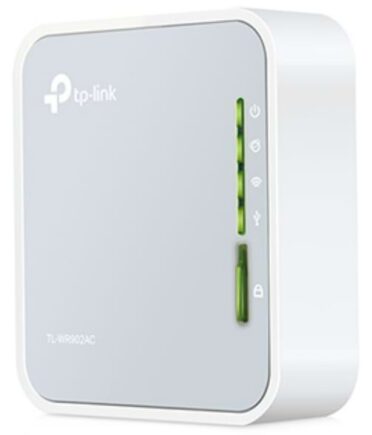
TP-Link TL-WR902AC Router
- Internet Access > Ethernet and WISP
- Wi-Fi Standard(s) > Wi-Fi 5: IEEE 802.11ac/n/a 5 GHz and IEEE 802.11n/b/g 2.4 GHz
- Wi-Fi Speed(s) > 5 GHz: 433 Mbps (802.11ac) and 2.4 GHz: 300 Mbps (802.11n)
- Wi-Fi Range > 2 Bedroom Houses: 2× Fixed Antennas (Internal)
- Network Security > SPI Firewall, Access Control, IP & MAC Binding, Application Layer Gateway
- Ethernet Port(s) > 1× 10/100 Mbps WAN/LAN Port
- Power Source > 5V/2A
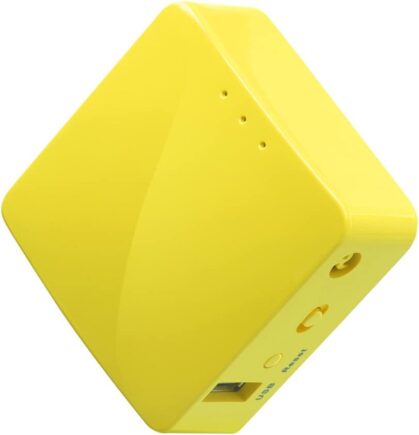
GL.iNet “Mango” GL-MT300N-V2 Mini Travel Router
- Internet Access > Ethernet, Repeater, USB Modem, and Tethering
- Wi-Fi Standard(s) > IEEE 802.11b/g/n
- Wi-Fi Speed(s) > 300 Mbps (2.4GHz)
- Network Security > Built-in firewall, OpenVPN and WireGuard capability, DNS server
- Ethernet Port(s) > 1 x WAN Ethernet port, 1 x LAN Ethernet port
- Power Source > Micro USB, 5V/2A
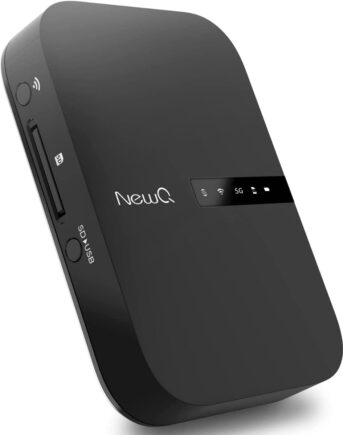
NewQ Filehub AC750 Travel Router
- Internet Access > Ethernet cable
- Wi-Fi Standard(s) > 5.8 GHz, 2.4 GHz
- Wi-Fi Speed(s) > 1,300 Mbps
- Ethernet Port(s) > 1 x Ethernet port
- Power Source > Chargeable battery
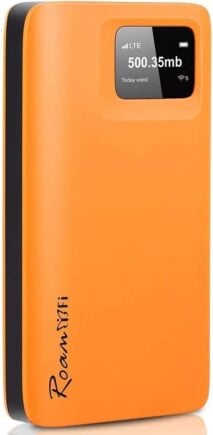
RoamWiFi 4G LTE WiFi Mobile Hotspot Router
- Internet Access > Built-in 4G LTE data plans
- Wi-Fi Standard(s) > 802.11n, 802.11b and 802.11ac
- Wi-Fi Speed(s) > 150 Mbps
- Ethernet Port(s) > None (because none needed!)
- Power Source > High-capacity 5000mAh lithium battery
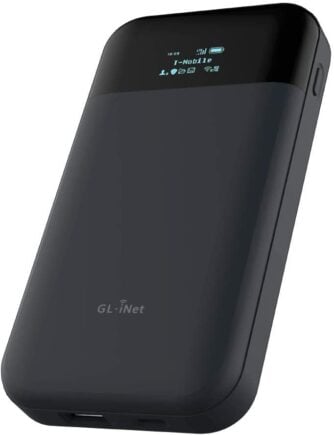
GL.iNet Mudi GL-E750 4G LTE Privacy Travel Router
- Internet Access > SIM Card
- Wi-Fi Standard(s) > 802.11 a/b/g/n/ac
- Wi-Fi Speed(s) > 2.4GHz: 300 Mbps and 5GHz: 433Mbps
- Network Security > OpenVPN and WireGuard capability, and Encrypted DNS with Cloudflare DNS over TLS, or DNS via HTTPS proxy
- Ethernet Port(s) > 1 x FE Port
- Power Source > 7000mAh battery
What is a Travel Router and What Does It Do?
How much does a travel router cost, the 5 best travel routers of 2024 – tried and tested, alternatives to using a travel router, final thoughts – best travel routers in 2024.
A travel router does the same thing as your Wi-Fi router at home: it sends out a wireless internet signal that your computer and phone can connect to. But if you’ve ever really looked at the big jumbled mess of antennas and cables that make up your home internet, you might be wondering how it could possibly be convenient to travel with one of these puppies.
This is where travel routers (keyword: travel ) really shine. They’re tiny, often very light, and instead of being connected to a big ol’ clunky modem, they get their internet connection the same way your phone does: via cell signal.
But if that’s true, you might now be wondering why you’d ever need a travel router when you have a phone. The reason? Travel routers come with a huge amount of connection benefits that your phone, even with a trusty personal hotspot, can’t touch.
Before we get to that though, it’s important to note that not all travel routers acquire their cell signals the same way. Some require a SIM card, others require a USB modem, and some actually need a standard Ethernet input (which can be hard to find while traveling).
Before you purchase a router on this list, check out the “Internet Access” line to see which method it uses before adding it to your digital nomad packing list .
Benefits of Travel Routers
- Better connection: Most travel routers simply provide a much stronger and faster internet connection than mobile hotspots. I mean, these things are optimized to provide Wi-Fi connection on the go, whereas your phone’s hotspot feature is more of an afterthought — an added bonus. Some travel routers have antennas for signal-boosting, and all of the ones on our list use advanced Wi-Fi technology. This means a stronger connection and extended range.
- Multiple devices: Travel routers allow you to connect more than one device at a time. Now, most hotspots also allow you to do this, but it’s often at the expense of internet speed. So if you’re traveling with a group, or if you’re just a Digital Nomad with more complex needs, a travel router will serve your purposes wonderfully.
- Increased security: If you’re concerned about data theft, using a travel router is usually a much better choice than using a mobile hotspot. Travel routers typically support advanced encryption protocols like WPA/WPA2, ensuring a secure wireless connection between your devices and the router. They also make use of advanced safety technology like firewalls, MAC filtering, and blacklisting/whitelisting.
- Longer battery life: Since travel routers are literally designed to provide a mobile internet connection, their batteries are built to last for a long time. Just try streaming a YouTube video via your hotspot and you’ll see your battery start to plummet (not to mention your phone will start to heat up like you’ve put it in the microwave). The difference in battery power between a travel router and your mobile hotspot becomes especially clear when you have multiple devices connected.

Drawbacks of Travel Routers
- Constantly connecting: If you’re planning on skipping out on a SIM card for your phone, and connecting to the internet only with a travel router, you might want to rethink that. One huge benefit of a mobile phone is that it’s always connected (or at least, always trying to connect). If you’re relying solely on a travel router, you’ll definitely end up a bit frustrated at the hassle of constantly connecting, disconnecting, shutting the router off, turning it back on, etc.
- Money: Travel routers tend to be a bit on the pricey side. We’ll get more into this below, but if you already spent hundreds on a mobile smartphone, you might think twice about throwing away still more cash for a device that’s incredibly convenient, but not strictly necessary.
- Cumbersome: This is ironic, given that the major draw of travel routers is their compact size — but it bears mentioning that, when living the Broke Backpacker life, every extra pound and every extra potential pocket in your backpack really counts. Again, a travel router can be immensely helpful, but it’s not totally essential for your travel packing list — so think about whether the extra weight and the loss of pack space is really 100% worth it for you.
I’m going to be real with you here.
You should expect to pay anywhere between $20 and $130 for a travel router.
However …
You should expect to pay anywhere between $70 and $130 for a travel router that works !
Slightly kidding, but also not. Trust me when I say that a travel router is not an area where you want to save as much money as possible.
You wouldn’t book a helicopter tour after seeing a sign that said “Cheapest in Town!” would you? In the same way, when you’re traveling (and especially when you’re solo backpacking), an internet connection can be a lifesaver. My advice is to save up, spend the extra dough, and get yourself a reliable travel router with a long lifespan, otherwise it’s just a complete false economy !

Do You Want to Travel FOREVER??
Pop your email in below to get a FREE copy of ‘How to Travel the World on $10 a Day!’.
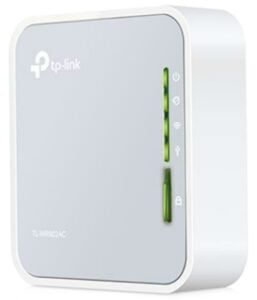
- Internet Access: Ethernet and WISP
- Wi-Fi Standard(s): Wi-Fi 5: IEEE 802.11ac/n/a 5 GHz and IEEE 802.11n/b/g 2.4 GHz
- Wi-Fi Speed(s): 5 GHz: 433 Mbps (802.11ac) and 2.4 GHz: 300 Mbps (802.11n)
- Wi-Fi Range: 2 Bedroom Houses: 2× Fixed Antennas (Internal)
- Network Security: SPI Firewall, Access Control, IP & MAC Binding, Application Layer Gateway
- Ethernet Port(s): 1× 10/100 Mbps WAN/LAN Port
- Power Source: 5V/2A
As we go down this list, you’ll find that one common thread between all of these routers is their utterly unpronounceable names.
To start, the TL-WR902AC comes in a beautiful, minimalistic white design. This thing is so tiny it can easily fit in your pocket, and it comes with multiple modes: Router, Hotspot, Range Extender, Client, and Access Point.
If you’re a tech geek and you want lots of options, the TL-WR902AC is an excellent place to start. The main drawback with the TL-WR902AC is its lack of a battery; you can only use this router when it’s plugged into a power source… so blogging at the beach might be a stretch!
The setup for the TL-WR902AC is relatively straightforward. It basically involves switching your router on, setting it to your desired mode, connecting your device to the network, creating a TP-Link account, and then surfing the internet to your heart’s content!
The TL-WR902AC is shaped like a tiny square with rounded corners. It’s super small and lightweight, measuring only 2.91 × 2.64 × 0.87 inches and weighing a measly 57 grams. So perfect for packing light.
GL.iNet “Mango” GL-MT300N-V2 Mini Travel Router
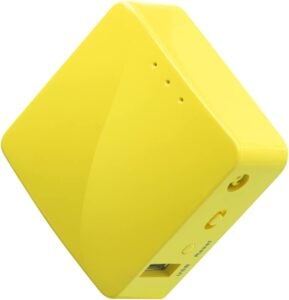
- Internet Access: Ethernet, Repeater, USB Modem, and Tethering
- Wi-Fi Standard(s): IEEE 802.11b/g/n
- Wi-Fi Speed(s): 300 Mbps (2.4GHz)
- Network Security: Built-in firewall, OpenVPN and WireGuard capability, DNS server
- Ethernet Port(s): 1 x WAN Ethernet port, 1 x LAN Ethernet port
- Power Source: Micro USB, 5V/2A
The GL-MT300N-V2 is a new and improved version of GL.iNet’s original travel router. It’s a sexy little thing that comes in a striking yellow color scheme. V2 features doubled the RAM capacity (128 MB, up from 64), as well as adding an MTK driver for optimizing connection and lightning-fast OpenVPN encryption.
Like the TL-WR902AC, a main drawback for the GL-MT300N-V2 is that it doesn’t have a battery, which means you need an external power source to use it.
Setting up the GL-MT300N-V2 for the first time should take no more than 15-30 minutes. Simply turn on the router, connect your device via Wi-Fi, wait until you’re redirected to the web admin page, create an account, adjust your Wi-Fi settings, and bam! You’re good to go.
The GL-MT300N-V2 has a beautiful, opaque yellow finish. It’s really, really, really tiny, measuring only 2.28 x 2.28 x 0.98 inches and weighing only 40 grams. Minimalist travellers rejoice!
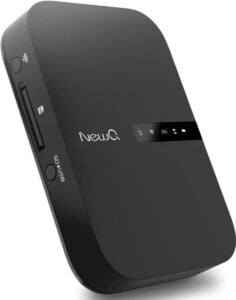
- Internet Access: Ethernet cable
- Wi-Fi Standard(s): 5.8 GHz, 2.4 GHz
- Wi-Fi Speed(s): 1,300 Mbps
- Ethernet Port(s): 1 x Ethernet port
- Power Source: Chargeable battery
Generally speaking, when you see the little “Amazon’s Choice” badge underneath a product, you know it’s going to be quality. The NewQ Filehub AC750 is no exception. Compared to the first two routers on this list, this one is a bit more cumbersome and heavy, but it packs way more of a punch.
The Filehub feature makes this router an excellent choice for photographers: you can connect an external hard drive or SD card directly to the router, and then access the files on the hard drive from your phone or computer 100% remotely. The NewQ Filehub AC750 is a great buy if you don’t care so much about portability and you need a true powerhouse of a router.
The setup process for the Filehub AC750 is straightforward, but pretty dang detailed. Rather than half-heartedly going into it here, I recommend you check out the official user manual for setup information.
As I mentioned earlier, this router is a bit more on the hefty side, but for good reason: it also functions as a power bank for when your phone needs an emergency charge! It measures 5.08 x 3.23 x 1.93 inches and weighs 258 grams. It’s a great product for slower-travelling digital nomads that need the extra power.

Now, you could spend a fat chunk of $$$ on the WRONG present for someone. Wrong size hiking boots, wrong fit backpack, wrong shape sleeping bag… As any adventurer will tell you, gear is a personal choice.
So give the adventurer in your life the gift of convenience: buy them an REI Co-op gift card! REI is The Broke Backpacker’s retailer of choice for ALL things outdoors, and an REI gift card is the perfect present you can buy from them. And then you won’t have to keep the receipt. 😉
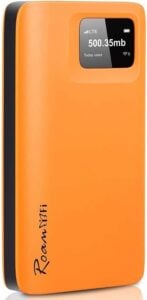
- Internet Access: Built-in 4G LTE data plans
- Wi-Fi Standard(s): 802.11n, 802.11b and 802.11ac
- Wi-Fi Speed(s): 150 Mbps
- Ethernet Port(s): None (because none needed!)
- Power Source: High-capacity 5000mAh lithium battery
This is the router for the fast traveler. If you’re not planning on staying in the same spot for more than a few days at a time, go with this RoamWiFi router. Why? Unlike the other routers on this list, it actually comes with three different data package choices, without any SIM card, USB modem, or Ethernet cable necessary.
The packages offer data coverage on every continent (except Antarctica — what a bummer!) This thing is tiny and light, it looks super dope, and the battery lasts more than 18 hours — which means you’re unlikely to get caught in a tight spot with no internet.
If ultra-fast download speeds aren’t a necessity and you want to maximize convenience, this is the router for you.
The RoamWifi travel router is trivially easy to set up: make sure you’ve purchased a RoamWifi data plan for your router, then turn it on and connect! Yup, that’s literally it.
This travel router is a striking bright orange, and shaped kind of like a mini smartphone. It measures 4.96 x 2.68 x 0.57 inches and weighs about 175 grams.
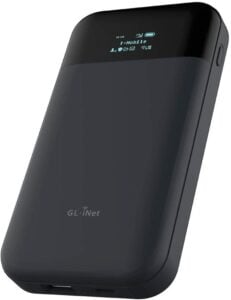
- Internet Access: SIM Card
- Wi-Fi Standard(s): 802.11 a/b/g/n/ac
- Wi-Fi Speed(s): 2.4GHz: 300 Mbps and 5GHz: 433Mbps
- Network Security: OpenVPN and WireGuard capability, and Encrypted DNS with Cloudflare DNS over TLS, or DNS via HTTPS proxy
- Ethernet Port(s): 1 x FE Port
- Power Source: 7000mAh battery
The Mudi GL-E750 is a bit on the pricey side, but it’s absolutely packed full of features. This puppy makes connecting to the internet super easy: the router is powered by a SIM card, which means getting it up and running is just as easy as it is with a phone.
It’s heavier than the above RoamWifi router, but it’s got more than double the download speed and a more powerful battery. As long as you don’t mind using a SIM card like you would with a phone, this router is essentially a bigger, beefier version of the RoamWifi.
The Mudi GL-E750 also comes with a plethora of security features, making it a great choice for those dealing with confidential data.
Setup involves popping in a SIM, powering on the router, connecting with your phone, adjusting some settings on the admin page, and then sitting back and enjoying a lightning-fast internet connection!
The Mudi GL-E750 measures 5.71 x 3.05 x 0.93 inches, and weighs 285 grams. It’s sleek, black, and has a small LCD screen, which makes settings adjustments super easy.

As clever and nifty as all of these travel routers are, it’s just a fact that not everyone needs the kind of heavy-duty utility that they provide. Most of us just want to book a hostel online, check Google Maps, and maybe stream a little Netflix.
If you feel like a travel router is slightly overkill for the kinds of things you use the internet for, check out the below alternatives.
If you’re not a veteran traveler (yet!) you may be surprised to learn that Wi-Fi is usually provided at nearly every hostel or hotel you could dream of — even some of the really off-the-beaten-path ones! You can also usually find internet cafes with relative ease in most reasonably developed towns and cities.
Using a provided WiFi network has the disadvantage of inconvenience, but it’s got some serious benefits as well:
- You won’t have to spend money on data plans or worry about your data running out;
- Because most provided Wi-Fi connections get their internet from a wired source, you won’t have any trouble with random “spotty” connections;
- Even the worst provided Wi-Fi networks are usually pretty fast, which is everything if you’re a Digital Nomad.
If you’re going to go this route, then for convenience’s sake I recommend booking your accommodation online as often as you can. This way you can verify beforehand whether or not Wi-Fi is provided. And again, you’d be surprised how many small unassuming cafes offer free internet too — so grab a coffee and take advantage of these places as much as possible!
To be honest with you, this is what most of us at the Broke Backpacker tend to do. Here’s why:
- Mobile hotspots have made many improvements over the last few years, so if your phone has 4G or 5G coverage, you’ll be pretty speedy on the ol’ worldwide web.
- There are tons of cheap, unlimited data plans these days, especially in Southeast Asian countries like Thailand or Sri Lanka. This means you’ll have complete peace of mind while streaming The Lord of the Rings Extended Editions from your hostel.
- Finally, travel eSIMs are a thing now, which means you hardly ever need to go through the hassle of buying a physical SIM card.
Regarding that last point, we hear at the Broke Backpacker loves the HolaFly eSIM . They’ve got a huge range of packages at different price points, with coverage in pretty much any country you could imagine. Buy an unlimited data plan with HolaFly, plug in your phone, connect to the hotspot, and you’re good to go!
If you want to know a bit more then check out our rundown of the best eSims for travel and backpacking before making your mind up.

Our GREATEST Travel Secrets…
Pop your email here & get the original Broke Backpacker Bible for FREE.
To conclude, it bears repeating that an internet connection is really dang important when you’re traveling these days. Everyone relies on it now, which means that if you want to know where to go, when to be there, and how to get there, chances are you’ll need a solid internet connection.
How you get this connection is totally up to you. The 5 best travel routers that I covered in this article are all excellent choices, each with its own specific pros and cons. To be totally honest, it would be hard to go wrong with any of them.
It all depends on what you’re going to use the internet for. If you’re a serious Digital Nomad, a photographer, or a videographer, you’re likely going to be dealing with huge amounts of data, and you’ll need a very dependable connection to do what you do best. If this is you, buy yourself a good travel router and rest easy.
For the rest of us, however, a good ol’ personal hotspot connection will do the trick just fine, especially if you’ve pre-purchased an eSIM from our good friends over at HolaFly.

And for transparency’s sake, please know that some of the links in our content are affiliate links . That means that if you book your accommodation, buy your gear, or sort your insurance through our link, we earn a small commission (at no extra cost to you). That said, we only link to the gear we trust and never recommend services we don’t believe are up to scratch. Again, thank you!

Aiden Freeborn
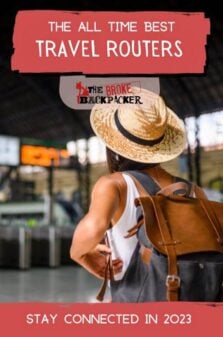
Share or save this post

Leave a Reply Cancel reply
Your email address will not be published. Required fields are marked *
Save my name, email, and website in this browser for the next time I comment.
Notify me of followup comments via e-mail.
Winter is here! Check out the winter wonderlands at these 5 amazing winter destinations in Montana
- Travel Essentials & Accessories
10 Best Travel Routers for Frequent Travelers
Published: August 2, 2022
Modified: December 27, 2023
by Angela Magsajo
- Hotel Reviews
- Tech & Gear
- Travel Tips
- Travel Accessories

Frequent travelers know the importance of bringing a reliable travel router with them during a trip. As the name suggests, travel routers let you stay connected while on vacation or business trips. They work the same way as the internet router you have at home. The main difference is the fact that they are more lightweight and compact compared to a regular home router. There are even models that you can easily fit inside your weekender bag or even your pants’ pockets!
How does a travel router work? It acts as an access point and connects your devices to the Internet, either by using an Ethernet cable or wireless signals from an already existing internet network. May this be the Wi-Fi in your hotel room, at the airport lounge, or even the 4G or 5G network of your phone. But, the best travel router does more than just allow for Wi-Fi on the go . Newer models are now equipped with Virtual Private Network (VPN) that protect your personal data when connecting to public networks. Additionally, you can find ones that double as a power bank or portable hard drive.
Here’s the rundown of the top 10 best portable Wi-Fi routes for travel!
1. Best Overall: TP-Link TL-WR902AC AC750 Travel Router
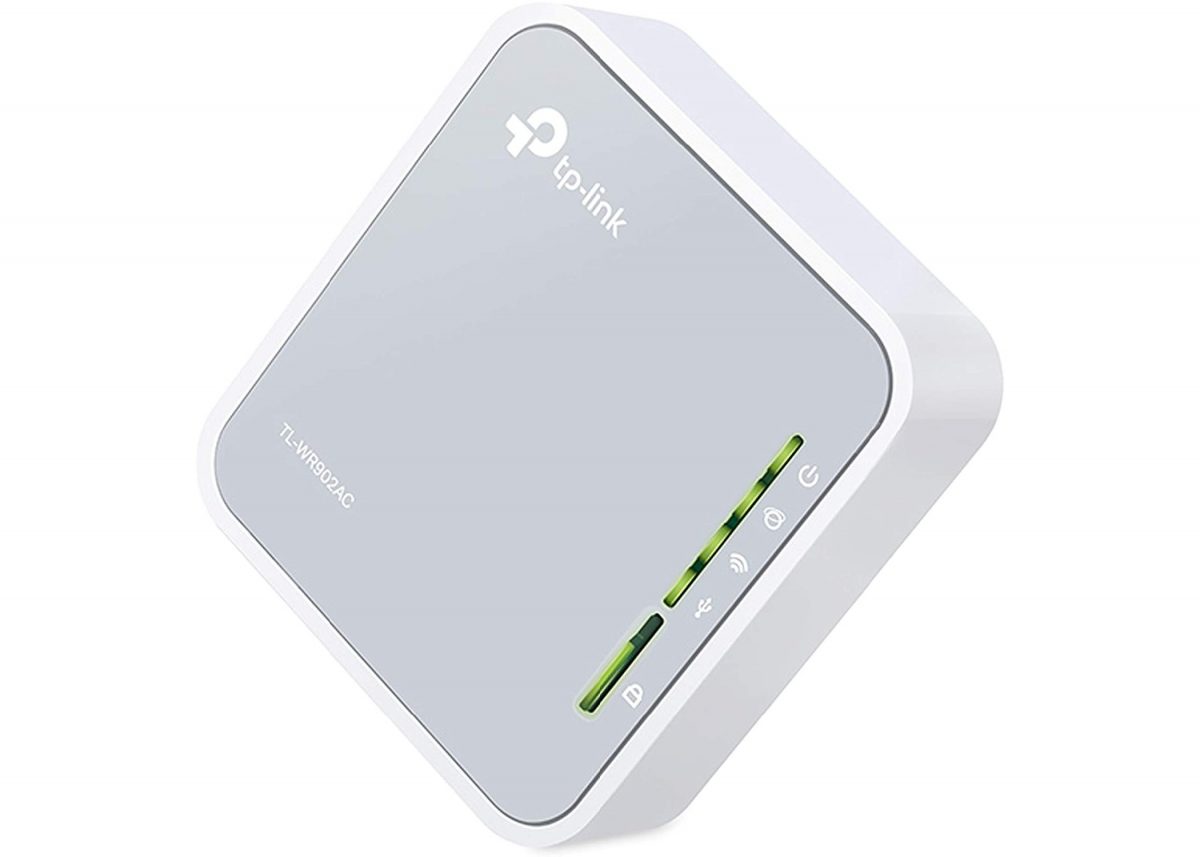
Read More Reviews Photo from Amazon
The TP-Link TL-WR902AC is a versatile travel router . It boasts five different modes that cater to the type of connection you need. But, the two main modes that you’ll most likely be using when on the go are Router and Hotspot Mode. When in Router Mode, you can create your very own private wireless network by plugging it into your hotel’s Ethernet jack. Hotspot Mode, on the other hand, allows you to connect to any public Wireless Internet Service Provider (WISP) Access Point. Moreover, thanks to its dual-band capability, you get a better range and signal strength.
On top of that, this TP-Link travel router is incredibly easy to set up and use. You can switch between the different modes with just one press of a button. Another highlight of this dual-band router is its portable design that fits in the palm of your hand or the pocket of your travel purse . However, the TL-WR902AC doesn’t have a built-in battery. You will need to connect it to a power source, such as an electrical outlet, power bank, or laptop via the mic ro-USB port. The USB port can also be used for file sharing or charging devices.
- Extremely portable
- Three-in-one device
- Dual-band router
- No built-in battery
Get the TP-Link TL-WR902AC AC750 Travel Router on Amazon now.
2. Best for Remote Areas: Netgear Nighthawk M1
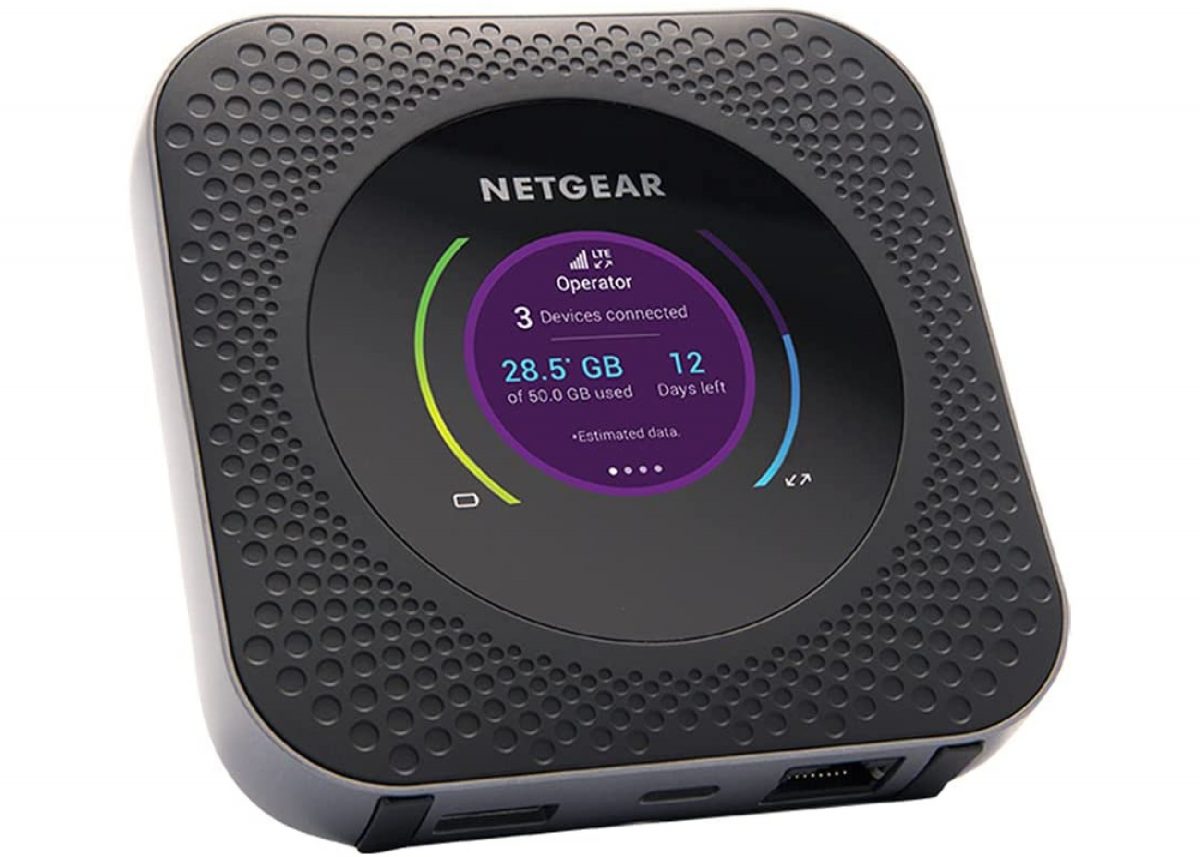
Traveling to far-flung areas? When traversing through the remote paths of the Appalachian Mountains with only a cellular connection to stay connected , you will need a reliable wireless router . The Netgear Nighthawk M1 is exactly that and more. As a premium travel router , it utilizes 4G Long Term Evolution (LTE) connections to provide maximum download speeds of up to one gigabit per second (Gbps). What’s more, you get upload speeds of up to 150 megabits per second (Mbps). It’s important to note, though, that it performs better with SIM cards from AT&T and T-Mobile than other carriers.
This travel router provides a steady connection to up to 20 devices at the same time, which you can track on its LCD screen. You can likewise monitor your data usage, signal strength, and battery life on the display. Besides being a portable Wi-Fi router , the Netgear Nighthawk M1 is also a power bank with a 5,040 milliampere-hour (mAH) rechargeable battery. You can use it to store files thanks to the SD card reader and USB port, as well. When you connect your device to the router’s network, you can easily access and manage all of your files.
- LED screen for tracking data consumption
- Connect up to 20 devices
- Three-in-one device
- Works best with specific networks only
Get the Netgear Nighthawk M1 on Amazon now.
3. Best for Overseas Travel: GlocalMe U3 Mobile Hotspot
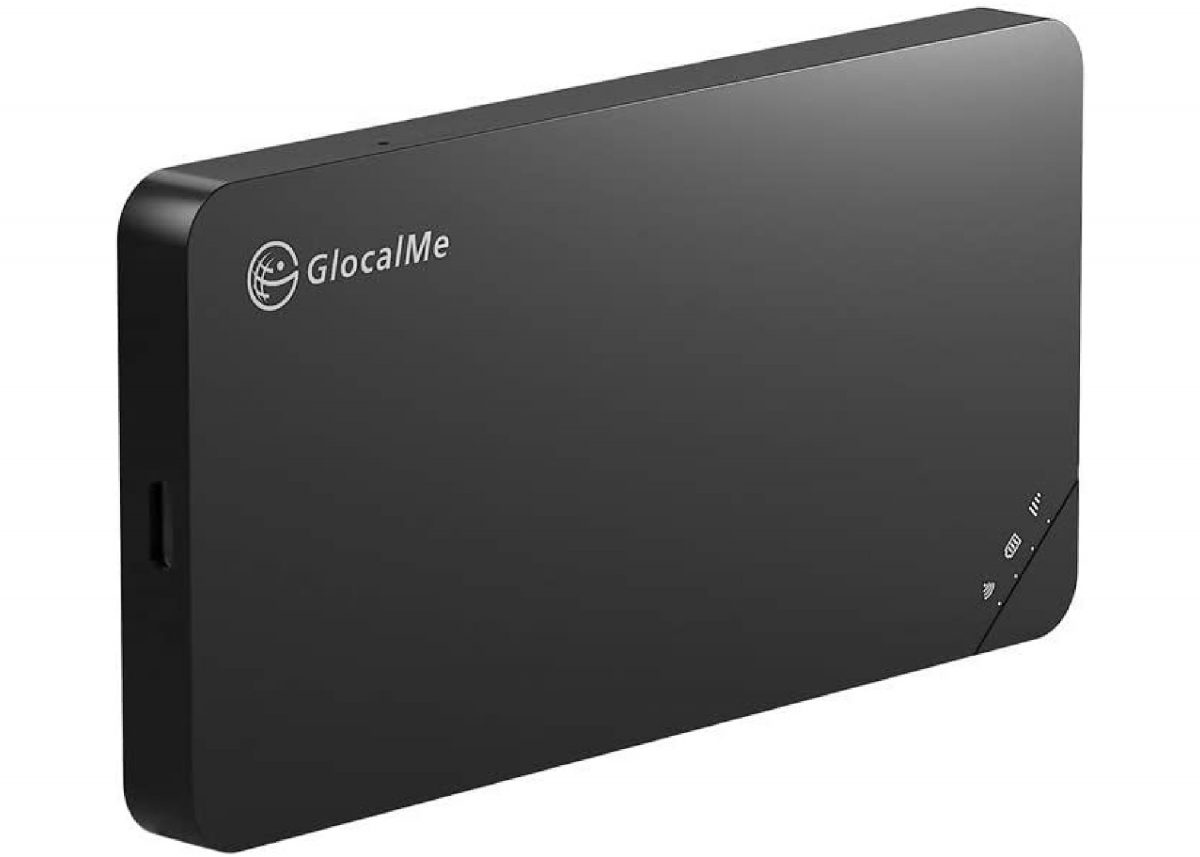
Planning to visit the best places to travel without a passport for your next overseas adventure? Then the GlocalMe U3 Mobile Hotspot is a companion you will want with you. While most wireless hotspot-type devices rely on SIM cards to establish a connection, the GlocalMe U3 eliminates this by utilizing its own secure full frequency network. By doing so, you get a faster and more stable connection. It supports 4G LTE with maximum download speeds of 150 Mbps and upload speeds of 50 Mbps.
The best part? It can provide portable internet service in over 140 countries across the globe, so you don’t have to worry about losing connection with your loved ones at home. It can also connect to 10 different devices simultaneously! And while you don’t need a separate SIM card to connect to the internet, it does feature a SIM card slot that allows you to use your own if needed. However, the notable downside to this handheld router is its weight. It may boast a slim and compact design, but it is fairly heavy compared to other options in the market. This is because of its 3,000 mAh battery which powers the device for roughly 13 hours.
- Works in 140+ countries
- Flexible data plans
- No SIM card required
Get the GlocalMe U3 Mobile Hotspot on Amazon now.
4. Best for Traveling in Europe : TP-LINK M7350
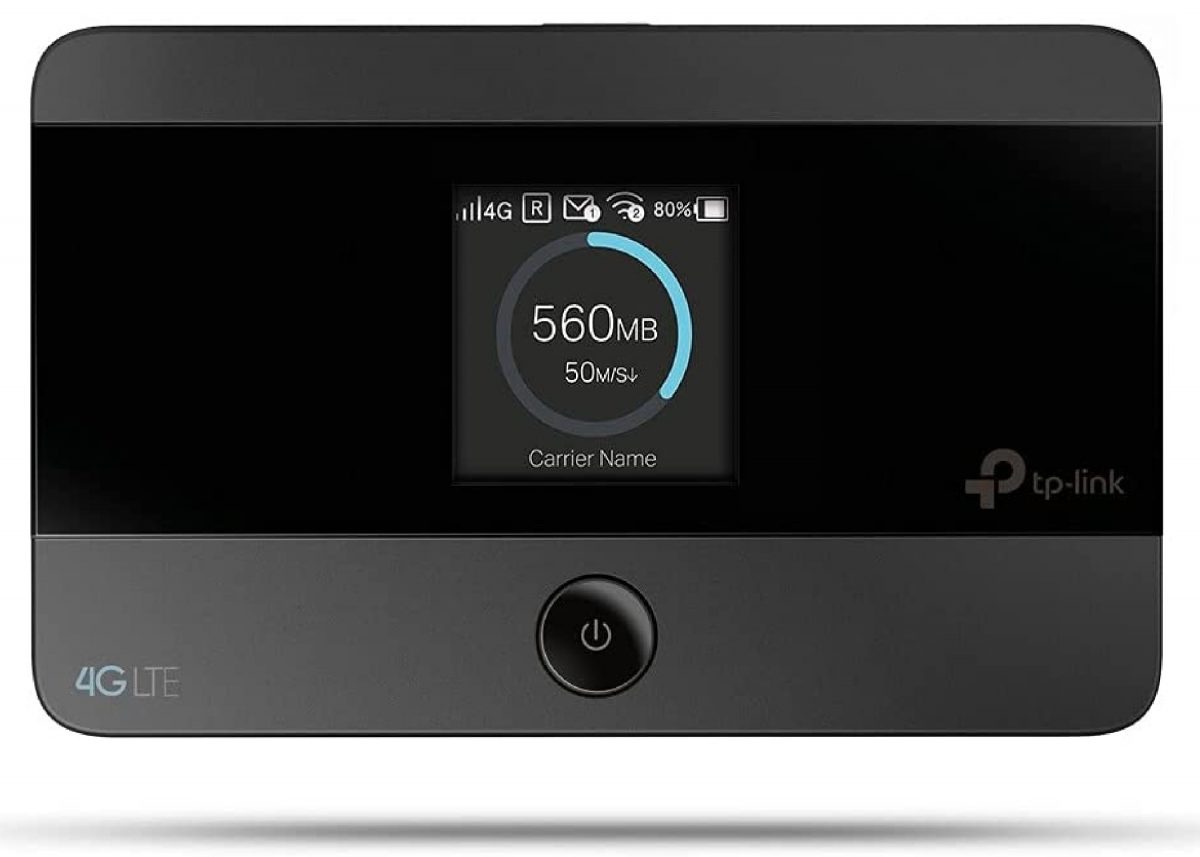
Planning a holiday to the best Southern Europe destinations ? You may want to bring the TP-Link M7350 with you. This portable Wi-Fi hotspot provides users with great connectivity using 4G LTE networks while traveling in European cities. With download speeds of up to 150 Mbps and upload speeds of up to 50 Mbps, you won’t have trouble streaming videos, downloading files, and uploading all your vacation photos online with this in your arsenal. Share the connection with up to 10 devices. It features an LCD screen which is a major bonus since you can see all information such as data usage, battery life, signal strength, and connected devices.
You can also manage and set limits to the data usage and connections using the dedicated smartphone companion app. It has a rechargeable battery with a 2,000 mAh capacity. This should keep you going for around eight hours, depending on usage. It isn’t the longest battery life out there, but it should be enough for a quick day trip. Furthermore, this mobile router features a micro SD card slot, so you can easily share files with other devices and users connected to the same network.
- Useful LCD screen
- Supports up to 10 devices
- Smartphone companion app
- Lackluster battery life
- Works only in European countries
Get the TP-LINK M7350 on Amazon now.
5. Best for Hotels: D-Link Wi-Fi AC750 DAP-1520
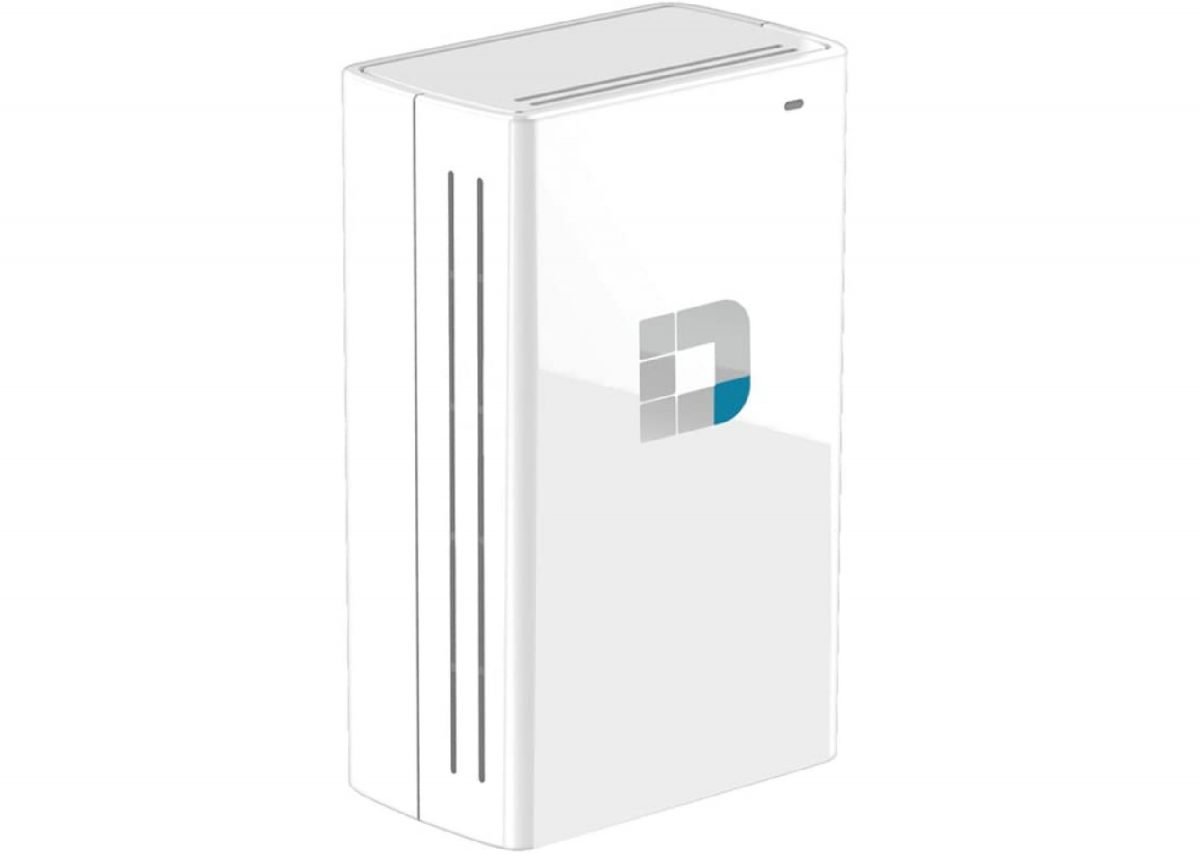
High-speed internet is among the top hotel amenities to look out for when booking your accommodation. If you’re on the hunt for the best travel router for hotels , look no further than the D-Link Wi-Fi AC750. This travel router for hotel Wi-Fi connections acts as a range extender , boosting the signal of your room’s already existing wireless network. As such, you don’t have to worry about any dead zones.
It can support Wireless AC speeds up to 750 Mbps. And due to its dual-band capabilities, you can connect more devices to it without sacrificing speed. Furthermore, this wireless Wi-Fi router is incredibly simple to set up. All you need to do is plug the D-Link travel router into a power outlet, establish a connection to your hotel’s Wi-Fi, and then you’re good to go. Note that it has no ports for either Ethernet or USB cables, which limits connection to wireless signals only. But for the affordable price, we’re willing to overlook this slight hitch.
- Budget-friendly
- Dual-band capabilities
- No Ethernet or USB port
- Bulky design
Get the D-Link Wi-Fi AC750 DAP-1520 on Amazon now.
6. Best Mobile Hotspot : Verizon Orbic Speed Mobile Hotspot
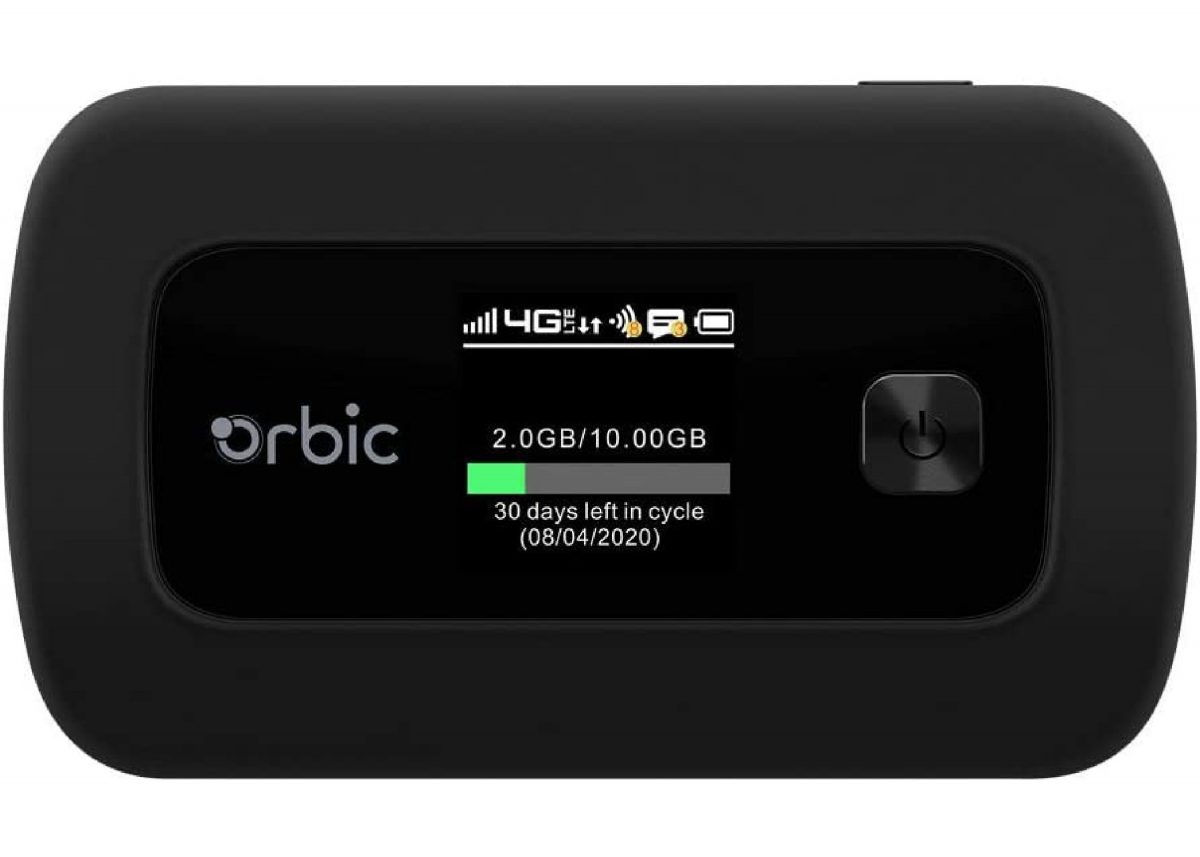
The Verizon Orbic Speed is a small but powerful mobile hotspot . Boasting dual-band 802.11 AC technology and 4G LTE networks, you get a fast, reliable connection with a wider range. It can handle up to 10 different devices simultaneously. It’s also equipped with a 3,000 mAh removable battery that lasts up to 12 hours of continuous use. You can check everything from its battery life, data consumption, and signal strength with just a glance thanks to its easy-to-read LCD screen.
The most notable downside to the Verizon travel router, however, is that you will be limited to Verizon data plans. Another drawback is its lack of ports for Ethernet cables, antennae, flash, or hard drives.
- Easy-to-read LCD screen
- Dual-band technology
- Only works with Verizon SIM cards
- No external ports
Get the Verizon Orbic Speed Mobile Hotspot on Amazon now.
7. Best Budget: GL.iNet GL-MT300N-V2
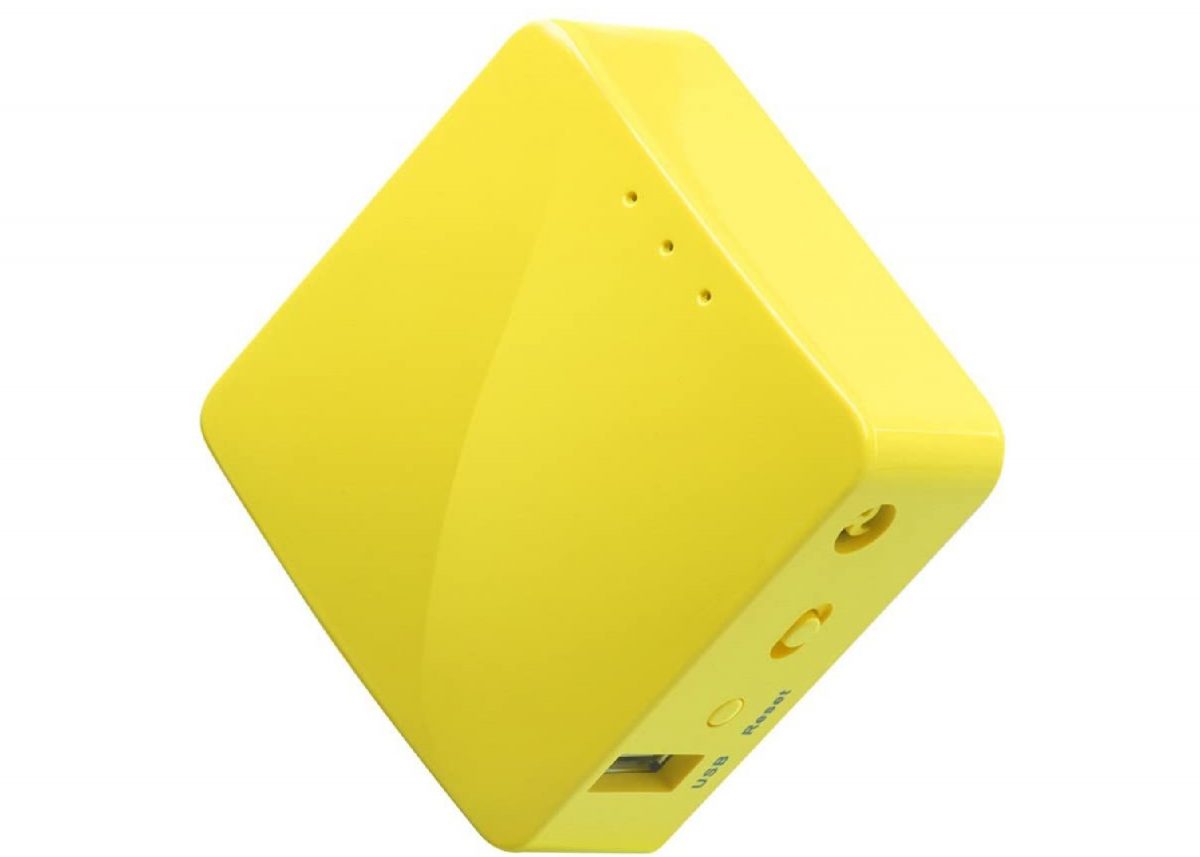
Finding the best travel router doesn’t have to cost you an arm and a leg. Valued at less than $30, the GL-MT300N-V2 is an affordable portable router from GL.iNet . Equipped with a powerful chipset, it has a wireless data transfer speed of 300 Mbps. Meanwhile, you get 100 Mbps when you connect your device using the USB or Ethernet port .
It has both a built-in firewall and open-source VPN capabilities to ensure your online security. However, configuring the VPN client of this router can be difficult for novice users. This travel router also doesn’t have a built-in battery, which is a bit inconvenient. You will need to connect it to a power source, like a laptop or power bank , for it to function.
- VPN capabilities
- Affordable price tag
- Hard to set up
Get the GL.iNet GL-MT300N-V2 on Amazon now.
8. Best Security: GL.iNet GL-AR750S-Ext
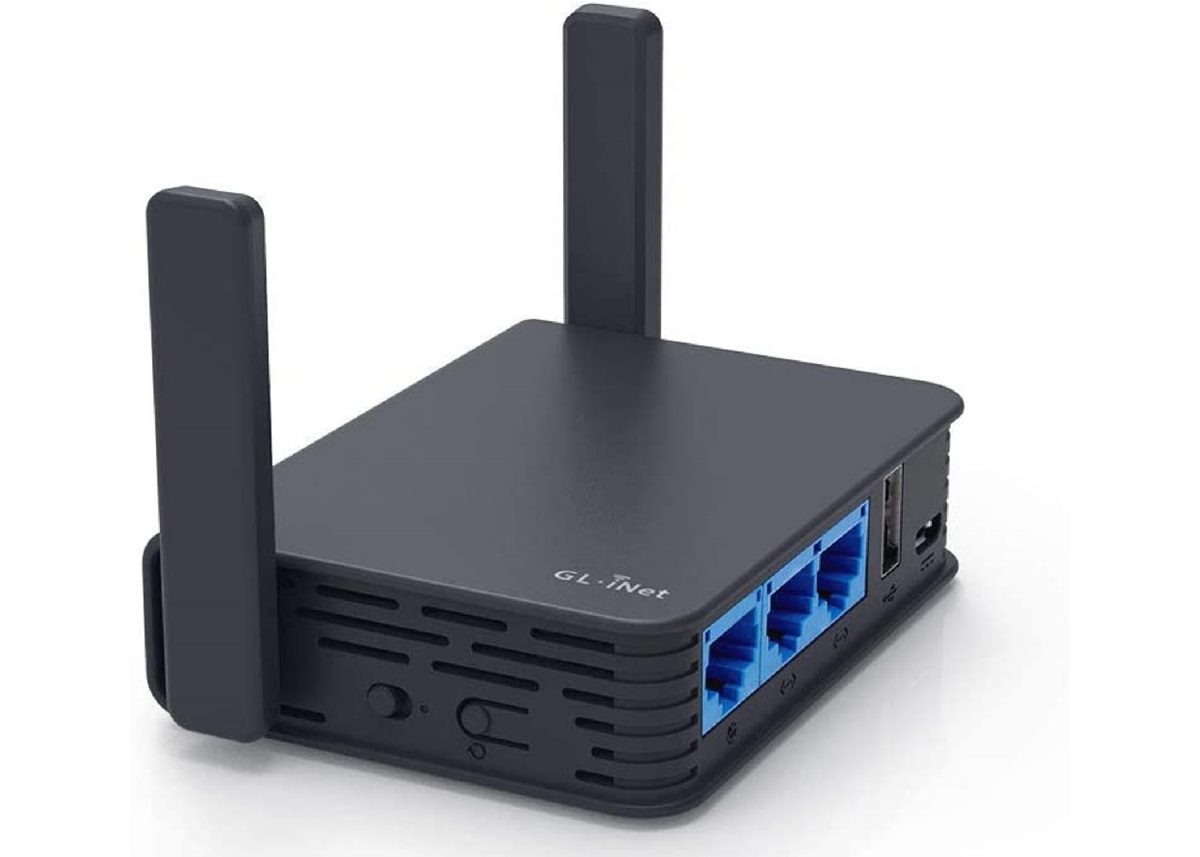
The GL.iNet GL-AR750S-Ext is a travel router that not only amplifies public internet connections but also has its own VPN server that actively protects your personal data from falling into the wrong hands. Featuring multiple open sources and programmable VPN protocols, it protects all of your data with ease when browsing the net.
In addition, it comes with a built-in firewall, which ensures an even more secure internet connection when in public spaces like hotel lobbies, airports, coffee shops, etc. It has three-gigabit ports, so you can connect up to three different wired devices. On top of that, you can also connect to a network wirelessly, allowing for more flexibility.
Admittedly, though, it’s not the easiest thing to set up. You will need to configure and tweak it to achieve optimal performance. This VPN router also doubles as a storage device because of its built-in MicroSD card reader. Access and manage files when your laptop or other smart devices are connected to the same network.
- Built-in VPN server and firewall
- Can be used wired or wirelessly
- MicroSD card slot for file storage
Get the GL.iNet GL-AR750S-Ext on Amazon now.
9. Best Wireless Access Point : GL.iNet GL-AR300M16-Ext
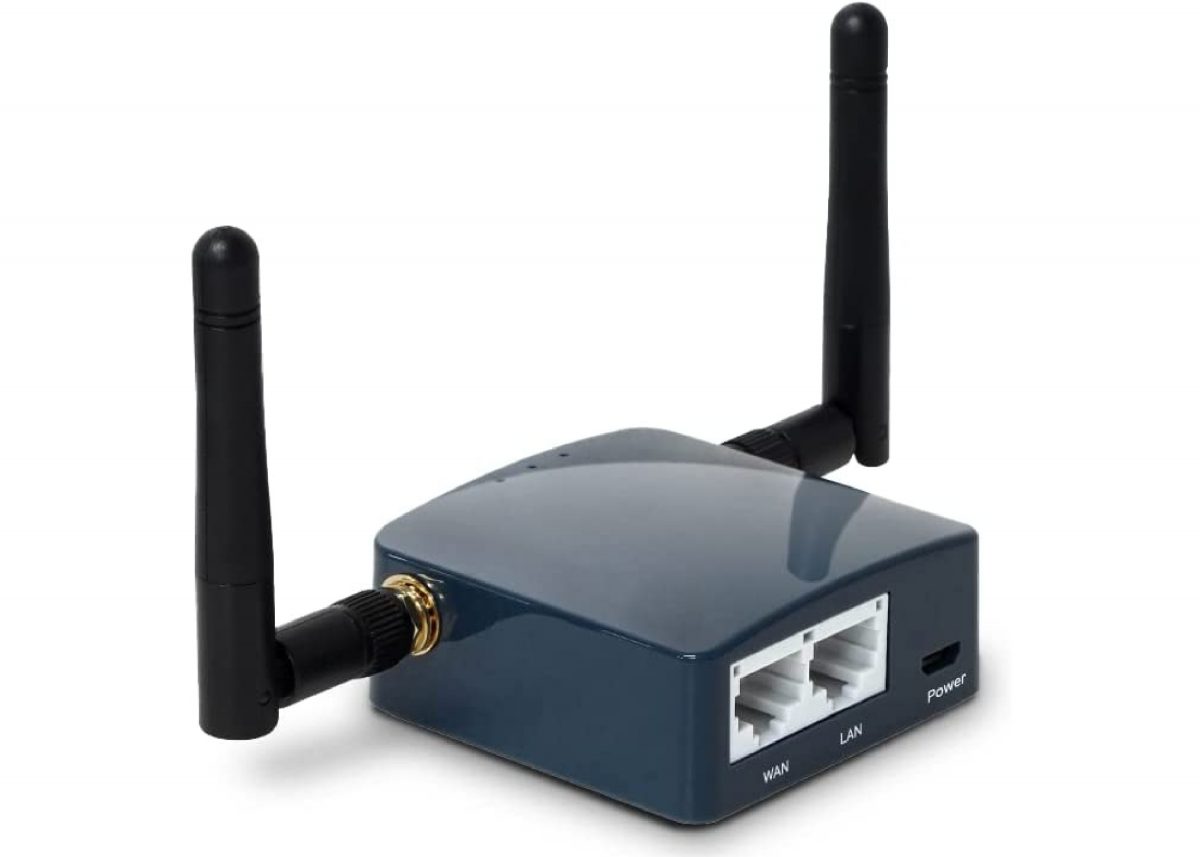
The GL.iNet GL-AR300M16-Ext is another unassuming travel router that’s rich in features. It can be used as Wireless Access Point (WAP), a Wi-FI booster, or as an independent router when connected to a mobile hotspot . It even features two detachable external Wi-Fi antennae that help improve the signal of your device’s connection even while hiking through remote areas like the mountains in New Zealand . However, it runs on a single 2.4 gigahertz (GHz) band frequency, so it may be noticeably slower than routers using double-band channels.
That said, it boasts advanced security protocols and encryption technology, including VPN capabilities. It comes pre-installed with both OpenVPN and WireGuard services, allowing you to connect to over 30 VPN service providers. All things considered, you get an extra layer of cybersecurity wherever you go.
- Multiple configuration options
- Two detachable antennae
- VPN capabilities
- Single-band router
10. Best Multi-Purpose: NewQ Filehub AC750
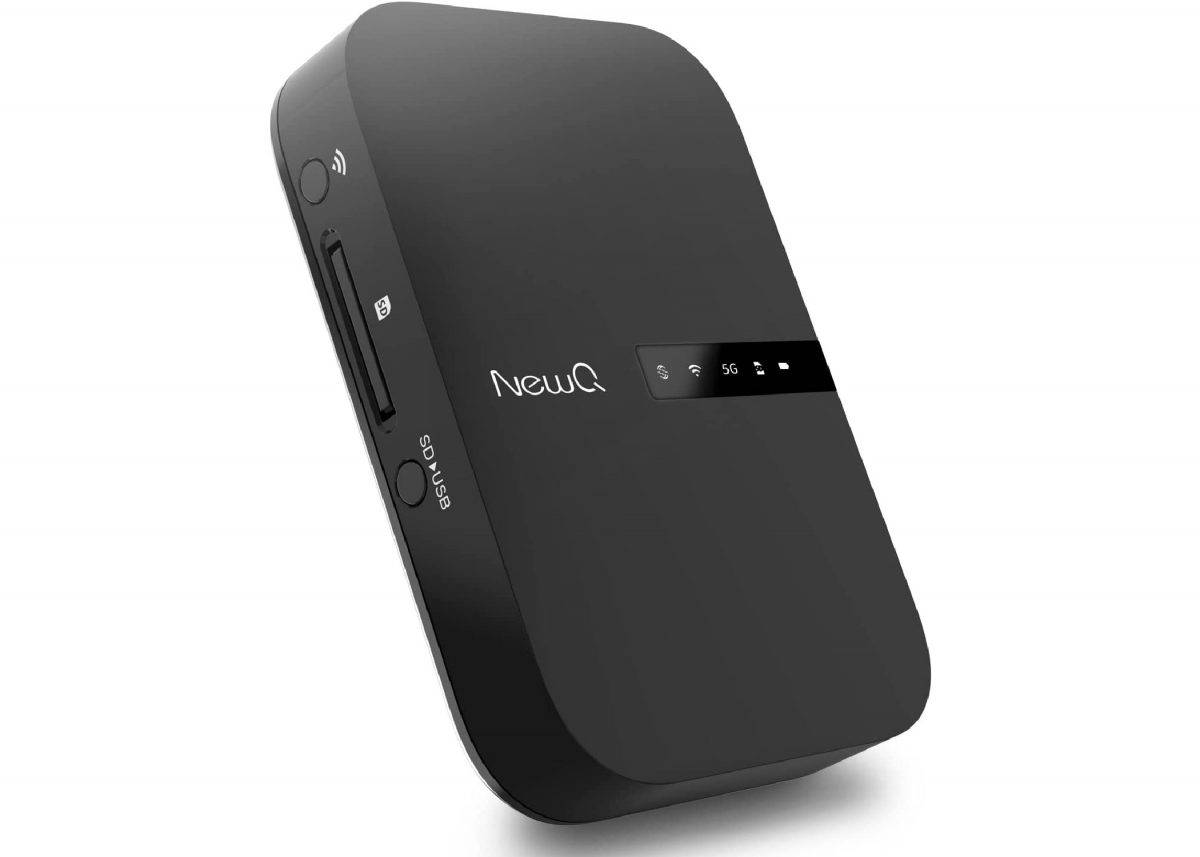
The NewQ Filehub AC750 is an all-in-one device you’ll want with you when traveling. As a portable wireless Wi-Fi router , it has three network modes: Access Point (AP) Mode, Router Mode, and Bridge Mode. The NewQ Filehub AC750 is a dual-band router and can support internet speeds up to 1300 Mbps. However, expect slower internet speeds when it’s in Bridge Mode since it cannot support 5 GHz frequencies.
On top of it being a travel router , you can also use it for wireless data transfer. It has an SD slot and a USB port for plugging in a storage device. Transfer and manage photos, videos, music, and other documents from them using your phone, tablet, laptop, or other devices when you connect them to the same network. This wireless travel router also works as a power bank, so you don’t have to worry about your gadgets dying when out and about.
- Multiple connection modes
- Not all modes support 5 GHz channels
Get the NewQ Filehub AC750 on Amazon now.
What to Look For in the Best Travel Router
Wireless frequencies .
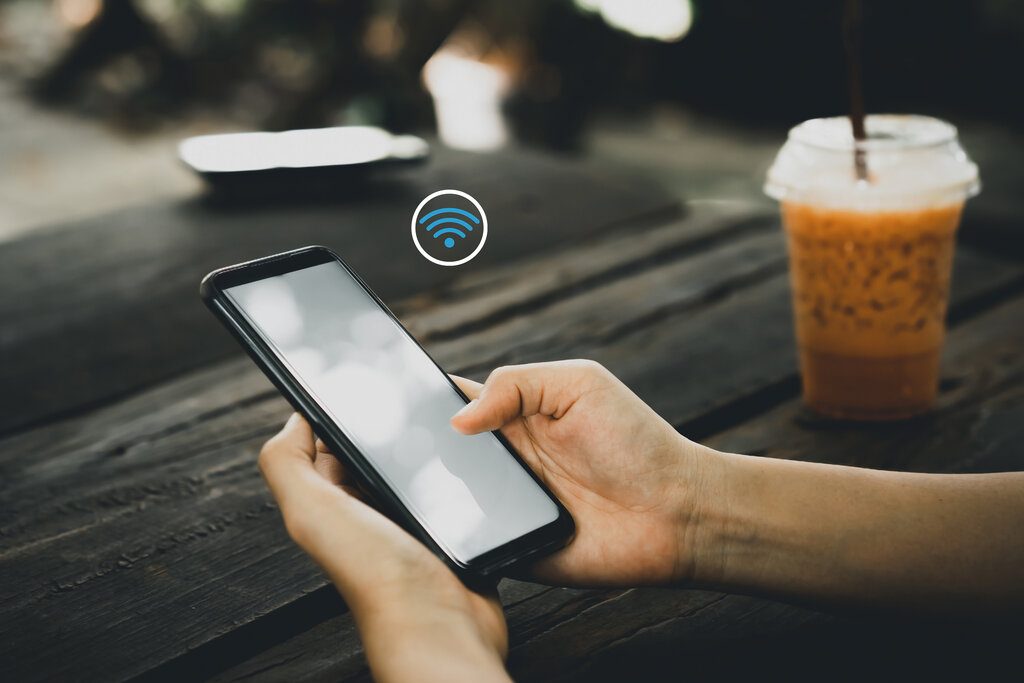
Photo by tonktiti on Adobe Stock
Most travel routers utilize either single or dual-band technology, which refers to the frequencies they support. A single-band router hosts a 2.4 GHz signal, while a dual-band router broadcasts both 2.4 GHz and 5 GHz signals . The main difference between the two frequencies boils down to speed and range. Wireless portable routes using 2.4 GHz frequencies have a larger range but slower speed, while 5 GHz travel routers are faster, but the coverage area is a bit more limited. A dual-band router can connect to the two bands at the same time, thus providing you with a more stable wireless internet connection . However, the catch is that dual-band travel routers tend to be pricier.
Keep these differences in mind when choosing a mini router to provide you with internet for travel . A single-band router is a great option for people on a budget whose primary concern is simply surfing the web and sending emails. Meanwhile, if you plan on gaming and streaming high-resolution videos while on vacation, invest in a double-band router .
Ports and Connectivity
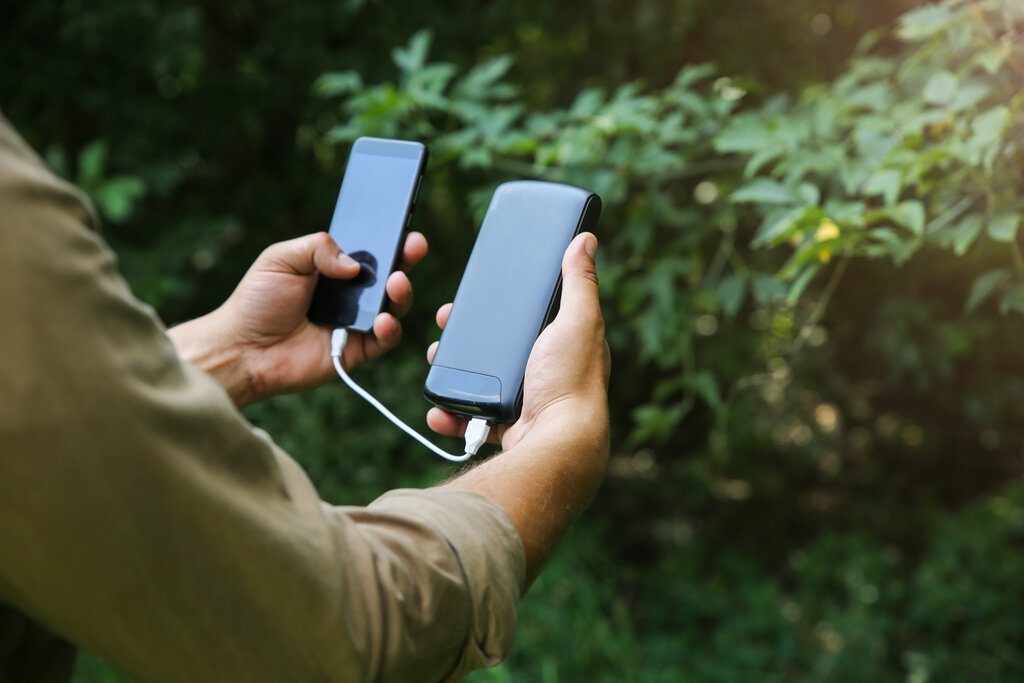
Photo by Vadym on Adobe Stock
Enhanced wireless connectivity is probably one of the main reasons you’re buying a wireless Wi-Fi router . However, you should also consider physical ports when choosing the best travel router for you. While most smartphones and tablets support wireless connections, there are still devices that require a wired connection to a router . And even if your laptop or console does have Wi-Fi capabilities, the internet connection from a wired connection is generally faster, more stable, and more reliable .
If you have a device that needs to be connected via cables, also consider the number of ports you need in a router. Most portable Wi-Fi routers come with one or two Ethernet ports , but you can find others with even more. Additionally, a built-in USB port comes in handy for storing, sharing, and managing files and media over the same network.
Security And Privacy
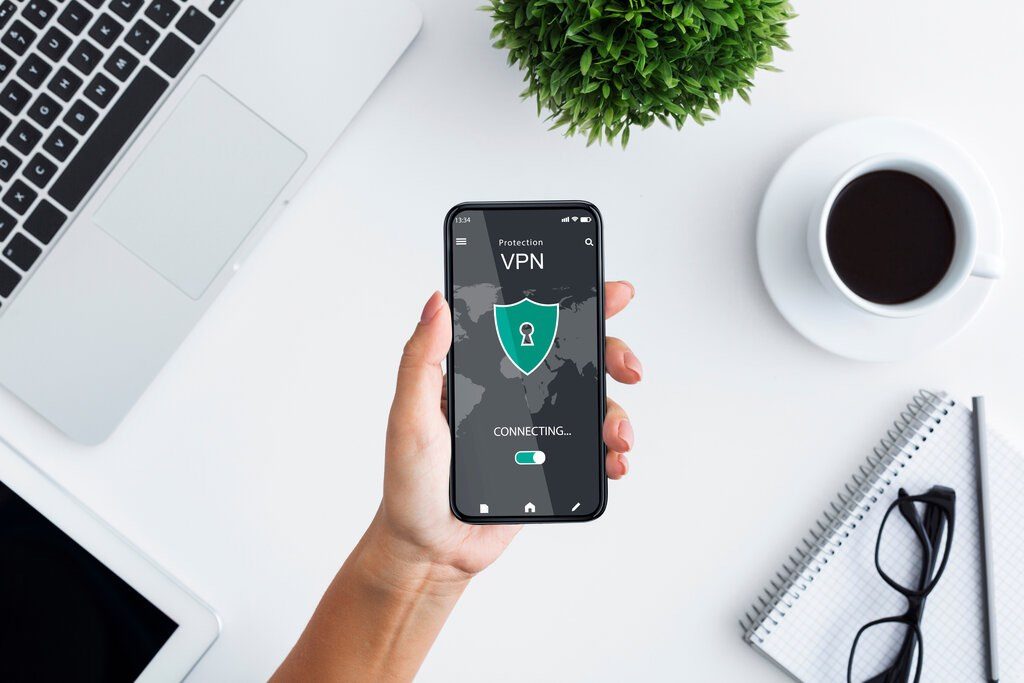
Photo by Prostock-studio on Adobe Stock
Modern wireless Wi-Fi routers have some security protocols and encryption support to protect users from hackers and other cybercriminals . The bare minimum for most models includes basic firewall protection and a Wi-Fi Protected Access 2 (WPA2) protocol. A firewall scans all the data sent or received over your network, while WPA2 encrypts them. If you want additional protection from other prying eyes on the web, opt for a travel router with a built-in VPN server. Investing in a travel router with VPN support means you are adding an extra layer of protection when online .
Battery and Power
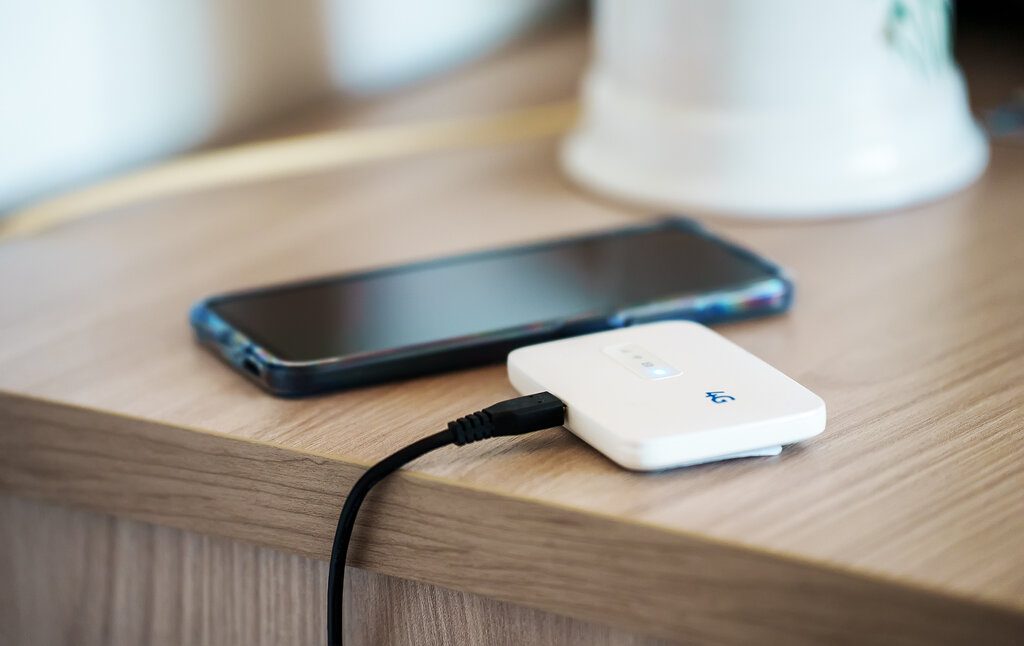
Photo by M-Production on Adobe Stock
If you truly want Wi-Fi for traveling, we recommend investing in a travel router with a rechargeable battery . Unfortunately, some of even the best routers need to be plugged into an outlet. For the few models that do run on battery power, also consider their capacity. The higher the indicated milliampere-hour (mAh), the longer it will last.
Can’t find a suitable model for you with a rechargeable battery? Look for one with at least a USB port that can be hooked up to a portable battery pack or laptop.
Frequently Asked Questions about Travel Routers
Is a travel router worth it.
Absolutely! It’s worth investing in a travel router, especially if you’re constantly traveling and staying in different hotels or other vacation rentals . Whether you’re on a business trip or a relaxing vacation, a travel router simplifies the process of connecting your gadgets to internet networks. In addition, they also allow for faster and more secure connections. Some models even function as power banks or storage drives.
Is a Travel Router a Hotspot?
Technically speaking, a traditional travel router is different from a hotspot . A travel router relies on an already existing network to provide an internet connection to your devices, while a mobile hotspot uses a cellular network to connect to the internet. But nowadays, you can find travel router models that also act as hotspots, giving you the option to get online either with wireless networks or mobile networks.
Can You Use a Travel Router Without an Internet Connection?
Generally, you cannot use a travel router without an existing network , may this be via a wireless connection or an Ethernet jack. There are a few models in the market that have SIM card slots, however, which gives you the ability to connect to the internet using cellular data.

- Privacy Overview
- Strictly Necessary Cookies
This website uses cookies so that we can provide you with the best user experience possible. Cookie information is stored in your browser and performs functions such as recognising you when you return to our website and helping our team to understand which sections of the website you find most interesting and useful.
Strictly Necessary Cookie should be enabled at all times so that we can save your preferences for cookie settings.
If you disable this cookie, we will not be able to save your preferences. This means that every time you visit this website you will need to enable or disable cookies again.

How Does a Travel Router Work?
How much time do you spend on your smartphone or tablet every day? If you answered yes, then you might want to consider investing in a travel router. Travel routers allow you to connect multiple devices at once, such as smartphones, tablets, laptops, and even smart TVs. They also provide Wi-Fi hotspots for travelers who don’t have access to reliable Internet connections.
Travel routers are designed to give you access to high-speed Internet wherever you go. Whether you’re traveling abroad or staying in your home country, they let you stay connected without worrying about expensive roaming fees.
A travel router lets you share your data connection with other devices. This means you won’t have to pay extra for each device that connects to your network. Plus, you can save money on data usage because you won’t be paying for additional data plans.
On the whole, a travel router is a great investment for any traveler.
There are many different types of travel routers. Some are designed to provide Wi-Fi hotspots for travelers who don’t have reliable Internet access. Others are meant to be connected to your home router, which will provide a wireless connection to multiple devices. Some travel routers can even be used to extend your home network to other areas in your home.
In this guide, we’ll take a look at the features of travel routers and how they work.
Portable travel routers are perfect for travelers who are staying in a hotel or other place that doesn’t have a reliable Internet connection. They are easy to use, lightweight, and have high-speed connections that provide great speeds even when you are far from your home network. Some models also offer extra ports for connecting to printers or other devices.
They use a USB cable to connect to your home computer and let you access the Internet. These routers provide a wireless network connection, so you can access the Internet from anywhere.
The good news is that you don’t need to be an expert to set one up and get connected, and these routers are pretty inexpensive. If you’re a regular traveler, you might already have one of these lying around the house.
Similar Posts
How far can drones travel or fly – facts & stats.
How far can drones travel or fly? How long does it take them to get from point A to…
Best Way To Use Laptop In Bed
Laptops are used by most of us on a daily basis and most of the time we spend working…
Importance of Laptop in Our Daily Life in 2022
The importance of laptop in our daily life is increasing. They are used for almost everything like playing a…
Leave a Reply Cancel reply
Your email address will not be published. Required fields are marked *
Save my name, email, and website in this browser for the next time I comment.
- Skip to content
- Skip to search
- Skip to footer

How Does a Router Work?
Learn how routers securely connect your small business to the rest of the world and connect your devices, including laptops and printers, to each other.
- Watch video (3:40)
- Discover routing solutions
Contact Cisco
- Get a call from Sales
Call Sales:
- 1-800-553-6387
- US/CAN | 5am-5pm PT
- Product / Technical Support
- Training & Certification
What does a router do?
Routers connect computers and other devices to the Internet. A router acts as a dispatcher, choosing the best route for your information to travel. It connects your business to the world, protects information from security threats, and can even decide which computers get priority over others.
Why do you need a router?
A router helps you connect multiple devices to the Internet, and connect the devices to each other. Also, you can use routers to create local networks of devices. These local networks are useful if you want to share files among devices or allow employees to share software tools.
If you don’t have routers, your business's data won’t get directed to the right place. For example, if you'd like to print a document, you need a router to help get that document to a printer—not to another computer or a scanner.
How do modems differ from routers?
A modem connects your business to Internet access via your internet service provider (ISP). A router, on the other hand, connects many devices in a network—including modems. With a router in place, modems and other devices can transfer data from one location to another.
Get started with a free trial of Cisco Meraki cloud networking
- Try Cisco Meraki for free
You may also like:
- What is a switch vs a router?
- How to set up a router
- How to setup a network
- How does a router work
- Getting to know the RV160 Router
- Getting to know the RV260 Router
- Getting to know the RV340 Router
What are the different types of routers?
Wired routers.
Wired routers usually connect directly to modems or wide-area networks (WANs) via network cables. They typically come with a port that connects to modems to communicate with the Internet.
Wireless routers
Routers can also connect wirelessly to devices that support the same wireless standards. Wireless routers can receive information from and send information to the Internet.
How routers route data
Routing, defined.
Routing is the ability to forward IP packets—a package of data with an Internet protocol (IP) address—from one network to another. The router's job is to connect the networks in your business and manage traffic within these networks. Routers typically have at least two network interface cards, or NICs, that allow the router to connect to other networks.
Speeding data across networks
Routers figure out the fastest data path between devices connected on a network, and then send data along these paths. To do this, routers use what's called a "metric value," or preference number. If a router has the choice of two routes to the same location, it will choose the path with the lowest metric. The metrics are stored in a routing table.
Creating a routing table
A routing table, which is stored on your router, is a list of all possible paths in your network. When routers receive IP packets that need to be forwarded somewhere else in the network, the router looks at the packet's destination IP address and then searches for the routing information in the routing table.
If you are managing a network, you need to become familiar with routing tables since they'll help you troubleshoot networking issues. For example, if you understand the structure and lookup process of routing tables, you should be able to diagnose any routing table issue, regardless of your level of familiarity with a particular routing protocol.
As an example, you might notice that the routing table has all the routes you expect to see, yet packet forwarding is not working as well as expected. By knowing how to look up a packet's destination IP address, you can determine if the packet is being forwarded, why the packet is being sent elsewhere, or whether the packet has been discarded.
Managing routers
When you need to make changes to your network's routing options, you log in to your router to access its software. For example, you can log in to the router to change login passwords, encrypt the network, create port forwarding rules, or update the router's firmware.
How routers can help your business
Sharing applications.
Routers help give employees access to business applications and therefore improve productivity—especially for employees who work remotely or outside main offices. Routers can also enable specialized services such as VoIP, video conferencing, and Wi-Fi networks.
Speeding access to information
With routers in place, your business can improve responses to customers and enable easier access to customer information. These are real benefits at a time when customers demand fast answers to questions, as well as personalized service. By using routers to build a fast and reliable small business network, employees are better able to respond rapidly and intelligently to customer needs.
Reducing operating costs
Routers can have a positive impact on your bottom line. Your small business can save money by sharing equipment such as printers and servers, as well as services such as Internet access. A fast and reliable network built with routers can also grow with your business, so you don't have to keep rebuilding the network and buying new devices as the business expands.
Improving security
Routers can help you protect valuable business data from attacks if they offer built-in firewalls or web filtering, which examines incoming data and blocks it as needed.
Enabling secured remote connections
Routers help your business provide secure remote access for mobile workers who need to communicate with other employees or use business applications. This is a common scenario for many businesses that have virtual teams and home-based telecommuters who need to share critical business information at any time of the day or night.
Creating small business networks with routers
Invest in business-grade switches and routers.
Consumer or home networking products won't keep pace with the challenges of business growth.
Build networks that can grow over time
This way, you can add features and functionality when needed, such as video surveillance, VoIP, integrated messaging, and wireless applications.
Choose routers designed with reliability and redundancy
This provides the business continuity you'll need to bounce back quickly from unforeseen and disruptive events, like natural disasters.
Want to learn more?

Our resources are here to help you understand the security landscape and choose technologies to help safeguard your business.

Collaboration
These tools and articles will help you make important communications decisions to help your business scale and stay connected.

Learn how to make the right decisions for designing and maintaining your network so it can help your business thrive.

Resource Center
Get how-to’s, checklists, and other tips to help you meet those demands and to help your business scale and thrive.

Best routers for 2024 [List]
- Click to share on Twitter (Opens in new window)
- Click to share on Facebook (Opens in new window)
- Click to share on Pinterest (Opens in new window)
A good router isn’t just about performance. It’s your first line of defense against network break-ins. If your router isn’t updating anymore, you’re experiencing random Wi-Fi freezes, frequent reboots, or runs hot, it’s time for a new one. Komando IT genius John replaces his every two years.
We all can’t be John. Most of us keep routers long enough that we should buy the best when it’s time to upgrade. That’s why I put together this list.
3+ bedrooms and lots of devices? Try the Linksys Velop Pro 7 .
- The newest of the new: 802.11 standard, designated Wi-Fi 7. Yup, that’s life in the fast LAN .
- Up to 3,000 square feet.
- Connect 200+ devices.
Bonus: It’s a mesh router. You can add on units for stronger coverage across the house.
Great value for smaller homes: Netgear 4-Stream AX1800
- Up-to-date AX Wi-Fi 6.
- Up to 1,500 square feet.
- 20+ devices.
FYI: It supports up to four streaming sessions at once — no more playing traffic cop.
Banish dead zones: Try the TP-Link Deco AXE5400
- At $209.99, it’s a solid mid-range price.
- The Tri-Band Wi-Fi 6E.
- Two units cover up to 5,500 square feet, taking you to the promised LAN .
FYI: The 6GHz band works for new devices, while 5GHz and 2.5 GHz support older devices. Nerd translation: Extra speedy performance!
👯 Do the router two-step
- Write down important settings: Before disconnecting your old router, know your SSID (network name) and passwords. This will make setting up your new router much smoother.
- Update the firmware: After installing the new router, check for and install any firmware updates. Nowadays, this happens automatically a lot of the time.
Look at how easy it was to pick the best router! Don’t forget to share this article with family and friends. I bet you get a ton of thank you’s back in return.
We may receive a commission when you buy through our links, but our reporting and recommendations are always independent and objective.

Join the Komando Community
Get even more know-how in the Komando Community! Here, you can enjoy The Kim Komando Show on your schedule, read Kim's eBooks for free, ask your tech questions in the Forum — and so much more.

Can You Work Remotely From a Cruise Ship? Here's What Digital Nomads Should Know
I f you can work remotely, there certainly are some great reasons to work from a cruise ship. Cruising can be a cost-effective way to travel to several places in one trip, and a cruise vacation includes a lot. There's entertainment, shopping, fitness classes, movies, games, pools, and more within a short walk at all times.
While cruises can be a great choice for remote work, there are certain things you need to consider before you write a to-do list, set meetings, and prepare for a productive time. Here are three things in particular to keep in mind that I've gathered from my own experience while working at sea.
Things to keep in mind
There are a few questions that you'll need to answer before you leave dry land. And while this isn't an exhaustive list, they include the following.
Is internet access good enough (and affordable)?
In most cases, cruise ship internet access isn't free, so you need to budget for it . Virgin Voyages is one of the few that includes it in your cruise fare, but if you sail on Carnival, Royal Caribbean, or most other popular cruise lines, expect to pay anywhere from $15-$30 per day per device for internet access. (Note: You can switch back and forth, meaning you could use one-device internet on your laptop while working, and switch to your smartphone when you're done.) One suggestion is to prepay for internet access, ideally with a travel credit card , as it's almost always cheaper than buying it on the ship.
The bigger issue is whether the internet is reliable enough to work. Some cruise lines, including Royal Caribbean, MSC, and Carnival, have started using Starlink satellite internet, which is far superior to what was previously available. It's still likely to be significantly slower than the connection you have at home or at the office, but it's sufficient for most work activities.
With modern cruise ship internet access (especially Starlink), you should be able to participate in Zoom meetings, stream video, etc. But even the best ship internet can be spotty at times, so if you need the ability to do these things at specific times, it might not be the best choice.
Does my cabin have a good place to work?
You might be surprised to learn that not all cabins on all cruise ships have a functional space to get work done. There might just be a small makeup stool near a ledge and a wall mirror, or a couch with a coffee table as the only real seating areas.
And even if there is space to put a laptop, there's no guarantee there will be power nearby -- most cruise cabins (especially those on relatively older ships) have outlets in just one or two places in the room. Plus, not all cruise ships have many public spaces that are conducive to getting work done (although some newer ships have coffee shops designed with this in mind).
If I'm planning to get any work done at all on a cruise, one thing I do is head to YouTube and search for the name of my ship and the room type I've booked. For example, if I search for "Independence of the Seas Balcony Room," I can find several short videos that will walk me through a room similar to the one I'm staying in.
Am I allowed to work internationally?
Some companies might have restrictions against working overseas, mainly for tax reasons. In the eyes of the IRS, any money you earn while on board a cruise ship in international waters is "sourced in the United States," as long as you're a U.S. citizen.
But let's say you get off the ship in Mexico and decide to work in a coffee shop. That might be something you want to check with your HR department about if you're a W-2 employee (self-employed people shouldn't need to worry about this).
The bottom line on working from a cruise ship
Working on a cruise ship can certainly be done. I often spend at least a few daytime hours working while I'm on a cruise -- at least on "sea days." However, there are some practical considerations to keep in mind that can help you manage your productivity expectations and prepare accordingly.
Alert: our top-rated cash back card now has 0% intro APR until 2025
This credit card is not just good – it’s so exceptional that our experts use it personally. It features a lengthy 0% intro APR period, a cash back rate of up to 5%, and all somehow for no annual fee! Click here to read our full review for free and apply in just 2 minutes.
We're firm believers in the Golden Rule, which is why editorial opinions are ours alone and have not been previously reviewed, approved, or endorsed by included advertisers. The Ascent does not cover all offers on the market. Editorial content from The Ascent is separate from The Motley Fool editorial content and is created by a different analyst team.The Motley Fool has a disclosure policy .


IMAGES
VIDEO
COMMENTS
A travel router is designed to simplify the process of connecting and managing devices on public Wi-Fi networks, whether that means in a hotel, at the airport, or anywhere else. Most major router manufacturers have travel versions in their product range, including Netgear, D-Link, and more. They can be pretty small, too.
Here are the top brands of wireless travel routers that we recommend. GL.iNet. We like GL.iNet because their products perform consistently well. We traveled with the GL.iNet GL-AR750 (Creta) travel WiFi router in the past, as well as an older version of the GL.iNet GL-MT3000 (Beryl) wireless travel router. However, there are plenty of other ...
Equipped with a 1.2GHz quad-core processor, as well as all the latest compatible WiFi 6 technologies, the GL iNet Slate tops our list of the best travel routers currently on the market. With MUMIMO, OFDMA, and BSS color, the GL iNet Slate can also connect up to 120 devices simultaneously, which makes it on par with some of the best routers for ...
Different Types of Travel Routers / Networking Devices. The type of travel networking device you want to purchase depends on several factors, including the nature of your work, the number of devices you want to connect, availability of the internet at a given location, the number of non-wireless products around, nature of the primary internet supplying device, and even the security safeguards ...
It's tiny, inexpensive, and our all-around top pick for best travel router. For most folks, it's the easiest solution. $35 at Amazon. The upgraded model features dual-band Wi-Fi, 802.11AC (Wi-Fi 5), and a really convenient switch on the side that makes it dead simple to change modes without logging into the router.
The only real downside is that the port layout can be awkward since the USB and micro USB power ports are on the opposite side of the Ethernet port. Wireless Spec: 802.11ac | Security: WPA2 | Standard/Speed: AC750 | Bands: Dual-band | MU-MIMO: No | Beamforming: No | Wired Ports: 1. TP-Link TL-WR902AC AC750 Travel Router Review.
If you can afford the price tag, this is one of the best portable routers that money can buy, and luckily, you can often find discounts on this product on Amazon. Click here to learn more about the NETGEAR Nighthawk M1. 5. GL.iNet (Beryl) VPN Wireless Little Travel Router. Photo Credit: GL.iNET.
3. NETGEAR Nighthawk M1 Mobile Hotspot 4G LTE Router. Safely, swiftly and easily connect up to 20 devices in total with the NETGEAR Nighthawk M1 Mobile Hotspot 4G LTE Router and have each and every one of them work like magic. This travel router brings public WiFi into a private setting for everyone you're on the road with.
If you're in a hurry, here's a list of the eight best travel routers on the market. There's one for every budget and need. Best overall: TP-Link AC1750 (connects up to five devices) Best budget: iNet. Best Range: TP-Link N300. Most specifications: TP-link. Smallest: TP-link. Most multifunctional: RAVPower.
Exploring the Basics of Travel Routers: How Do They Work? A travel router works by taking an existing Wi-Fi signal and amplifying it so that multiple devices can be connected at once. The router then creates its own network, allowing users to share files, stream media, and access the internet anywhere there is an available Wi-Fi signal. ...
The TP-Link TL-WR902AC Travel Router is both versatile and portable. Whether you're traveling and want more security and privacy than a public Wi-Fi network affords, or you just want to extend your home Wi-Fi network, this humble little gadget can't be beaten. View On Amazon $40 View On Walmart $32 View On B&H Photo Video $40.
A travel router is a compact little device that solves common Internet issues while traveling and offers a number of features to the on-the-go traveler who wants to stay connected. It can act as a wireless range extender, WiFi access point, and help provide extra security to your Internet connections when traveling. We review the best travel routers to help you decide which is for you!
View Latest Price →. TP-Link TL-WR902AC. Best Travel Router for Hotels. Makes use of dual frequency bands of 2.4 and 5Ghz. Can be used for a variety of connection options. View Latest Price →. GL.iNET GL-MT300N-V2. Best Wireless Travel Router. Made with a durable construction to last longer.
RoamWiFi Router. 8.40 /10 6. MIGHTYWIFI Router. 8.20 /10 7. GL.iNet GL-AR750S-Ext Router. View All. In this modern world, staying connected to the internet, even when you are on the go is an essential part of life. The best travel routers can enable you to connect several devices while providing you with a secure, fast, and reliable internet ...
How Does a Travel Router Work. September 1, 2023 by Lily Hurtado. ... Discover how a travel router seamlessly connects multiple devices to create your very own private network, ensuring uninterrupted browsing wherever your wanderlust takes you. So, get ready to break free from internet limitations and embark on a truly liberating travel experience!
The RoamWifi travel router is trivially easy to set up: make sure you've purchased a RoamWifi data plan for your router, then turn it on and connect! Yup, that's literally it. This travel router is a striking bright orange, and shaped kind of like a mini smartphone. It measures 4.96 x 2.68 x 0.57 inches and weighs about 175 grams.
Here's the rundown of the top 10 best portable Wi-Fi routes for travel! 1. Best Overall: TP-Link TL-WR902AC AC750 Travel Router. Read More Reviews. Photo from Amazon. The TP-Link TL-WR902AC is a versatile travel router. It boasts five different modes that cater to the type of connection you need.
Travel routers are designed to give you access to high-speed Internet wherever you go. Whether you're traveling abroad or staying in your home country, they let you stay connected without worrying about expensive roaming fees. A travel router lets you share your data connection with other devices. This means you won't have to pay extra for ...
But how exactly does a travel router work? In this article, we will explore the functionality of a travel router and answer some common questions related to its use. A travel router is a compact device designed to create a private Wi-Fi network wherever you go. It works by connecting to an existing internet source, such as a hotel's wired ...
1. Best Overall: TP-Link AC750 Wireless Portable Nano Travel Router. 2. RAVPower FileHub (RP-WD009) AC750 Wireless Travel Router. Best Wireless Travel Routers. 3. Best Wireless Travel Router: HooToo Tripmate Titan. Best For Portable Wireless Access Point Use. 4.
Routers figure out the fastest data path between devices connected on a network, and then send data along these paths. To do this, routers use what's called a "metric value," or preference number. If a router has the choice of two routes to the same location, it will choose the path with the lowest metric. The metrics are stored in a routing table.
I think the thing with a travel router is that built to be more portable and maybe provide easier access than a regular router. Like maybe if you tap your phone in it, it will connect automatically with NFC. Maybe it had USB ports so it can help charge your devices. The most important feature though is that you get an ethernet cable, plug it ...
Because your router is designed to connect multiple devices to your network, it will usually have more ports than your modem. A typical Wi-Fi router usually has one wide area network (WAN) ethernet port that connects to a modem and four or more additional ethernet ports for hard-wired computers and devices. If you plan on connecting a device ...
For staying connected no matter where your travels may lead, the JEXtream® RG2100 5G Mobile Hotspot is a perfect choice. Whether you're connecting a single device or an entire RV's worth of phones, laptops, TVs, gaming devices and more, this compact device has you covered. With the power to provide Wi-Fi to up to 20 devices, the JEXtream ...
How does the internet work? In simple terms, the internet links computers and other devices together via wires, cables, radio waves, and other networking infrastructure. The devices can then communicate, share, and access information in seconds. While the process itself sounds simple, it has some nuances to it, especially when setting up ...
How to connect in 4 easy steps. In order to connect your router to a modem, you'll need the router, modem, and an ethernet cable. Unplug your modem's power source from the wall. Then, make sure your modem is connected to the wall via coaxial cable. Once the modem is unplugged from its power source but connected by coaxial cable, plug an ...
Try the Linksys Velop Pro 7. $349.99. The newest of the new: 802.11 standard, designated Wi-Fi 7. Yup, that's life in the fast LAN. Up to 3,000 square feet. Connect 200+ devices. Bonus: It's a ...
Wi-Fi repeater. Also referred to as a network repeater, a Wi-Fi repeater connects to your home Wi-Fi network wirelessly and then rebroadcasts the signal throughout a larger area. Wi-Fi repeaters connect to your Wi-Fi network just like any other device, such as a mobile phone or laptop would. So, they're an option if, say, a guest network on ...
Virgin Voyages is one of the few that includes it in your cruise fare, but if you sail on Carnival, Royal Caribbean, or most other popular cruise lines, expect to pay anywhere from $15-$30 per day ...